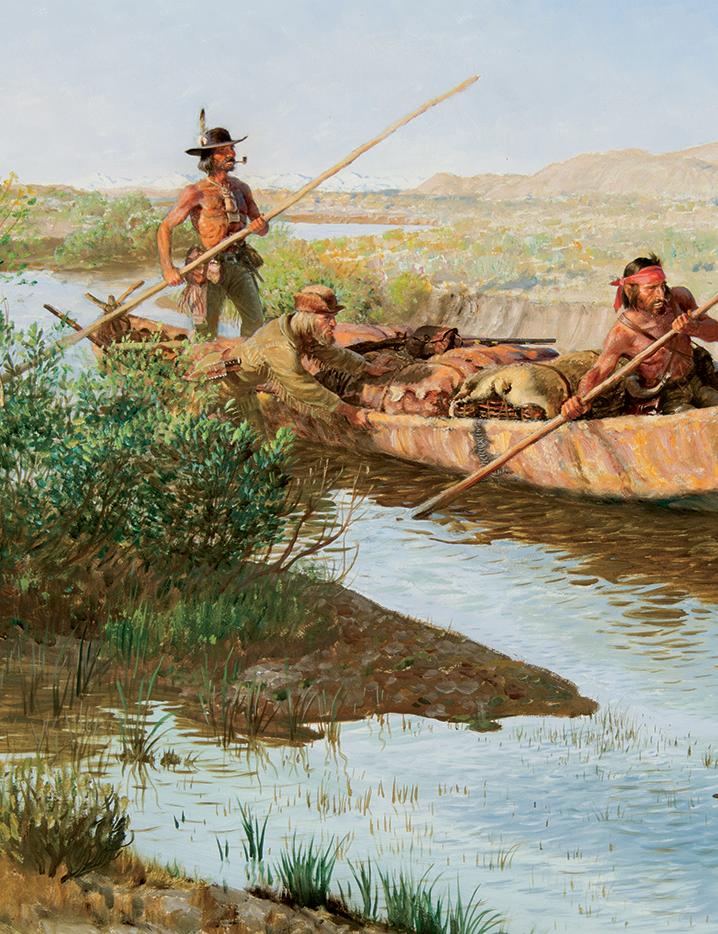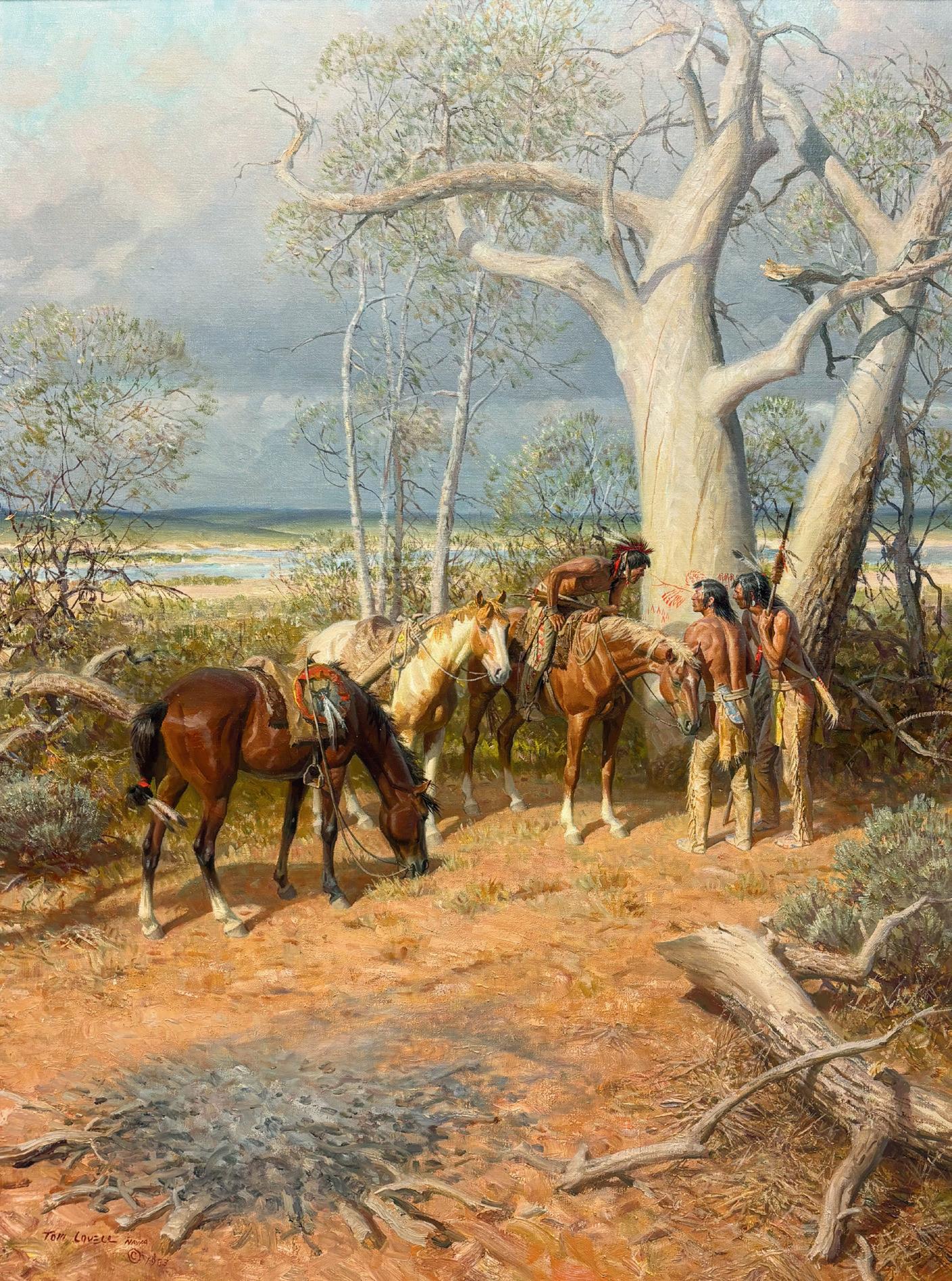SESSION II
L ots 176 - 410
Jason Brooks, Auctioneer
Hotels nearby. Limited availability.
Canopy by Hilton
Scottsdale Old Town 7142 E. First St • Scottsdale (480) 590-3864
Corporate rate code: "Legacy Gallery" 3198274.
Caesars Republic Hotel (Opens April 2024) 4747 N Goldwater Blvd • Scottsdale (480) 903-4747
Corporate rate code: N/A
Walking distance to the Scottsdale Fashion Square Mall
*More hotels listed on our website
Auction results will be available online Tuesday, April 16 on our website.
Download our Scottsdale Art Auction app today!

276 Martin Grelle b. 1954 Distant Signal (detail)
Oil on linen
36 x 48 inches
Signed/CA and dated 2015 lower right;
Signed/CA, titled and dated 2015 verso
Estimate: $150,000 - 200,000
SCOTTSDALE ART AUCTION 85


Insignia and “Phoenix, Ariz.” lower left
Estimate: $3,000 - 5,000
Signed lower right; Signed and titled verso
Estimate: $3,000 - 5,000

Signed lower right
Estimate: $5,000 - 7,000
SCOTTSDALE ART AUCTION 86
176
Edith Hamlin 1902-1992 Mountain Peak Oil on board 16 x 20 inches
177
Maynard Dixon 1875-1946
Ramada Phoenix, Arizona - August 1900
Graphite on buff paper 10 ⅜ x 7 ⅝ inches
178
Oscar Berninghaus 1874-1952
At the Treeline Oil on board 16 x 12 inches


180
Bodmer Karl (In the manner of)
Pachtüwa-Chtä. An Arrikkara Warrior
Watercolor
11 ¼ x 8 ¼ inches
Estimate: $2,000 - 3,000
179
Ernest Blumenschein 1874-1960 American Indian Ink and gouache
9 ¼ x 6 ½ inches
Signed lower left “B”
Estimate: $2,500 - 3,500

181
Fernand Lungren 1857-1932
A Prehistoric Potter
Watercolor
24 x 17 ½ inches
Signed lower right
Estimate: $500 - 800
SCOTTSDALE ART AUCTION 87
182
Frederic Remington 1861-1909
Set of eight: A Bunch of Buckskins
Lithograph
20 x 15 inches (each)
Signed
Complete set with original portfolio and text. 1901 RH Russell & Co.
Estimate: $12,000 - 18,000

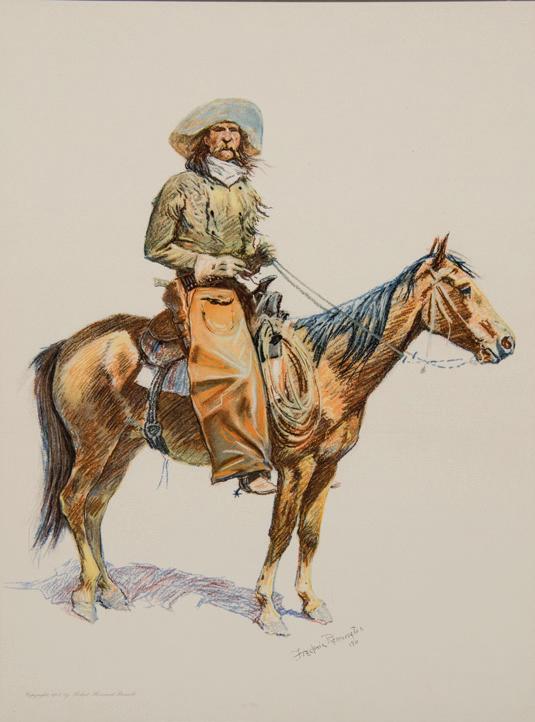






SCOTTSDALE ART AUCTION 88

183
William Gollings 1878-1932
A Rough Voyage Etching 11 ½ x 9 inches
Signed and dated 1929 in plate; Signed and dated 1929 lower right
Estimate: $2,500 - 3,500

185
William Gollings 1878-1932
A Winter Camp Etching 6 ¾ x 9 ¾ inches
Signed and dated 1929 lower right
Estimate: $2,500 - 3,500

184
William Gollings 1878-1932
Busting a Steer Etching 9 x 11 ¼ inches
Signed lower right
Estimate: $2,500 - 3,500
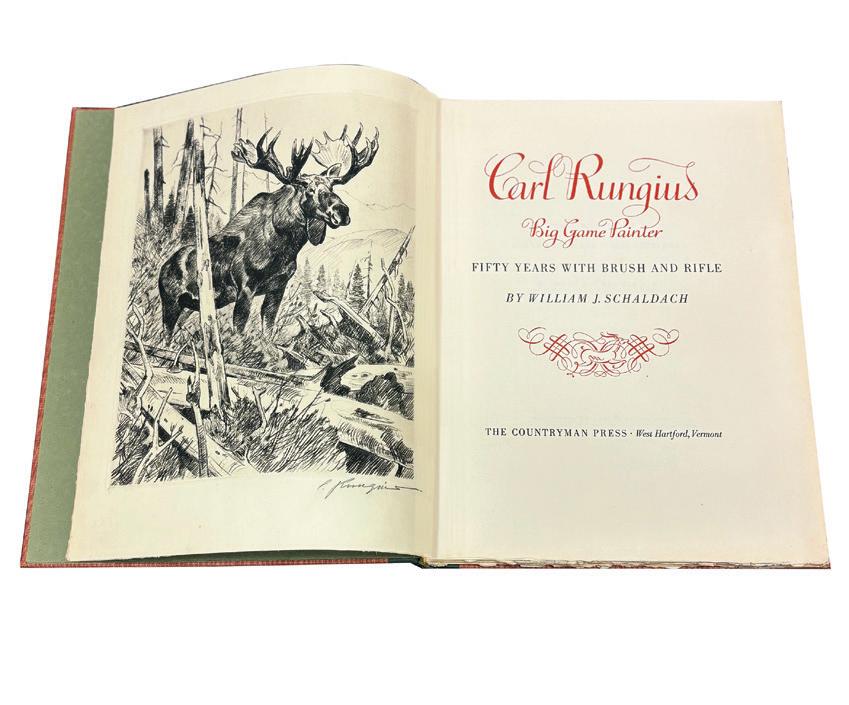
186
Carl Rungius 1869-1959
Carl Rungius: Big Game Painter, 50 Years with Brush and Rifle
Original Dry point etching 143/160 (inside book), signed 9 ¾ x 7 ¾ inches
Also signed by Rungius and Schaldach
Estimate: $3,500 - 5,500
SCOTTSDALE ART AUCTION 89
187
Eanger Irving Couse 1866-1936
Moonlight Seascape Oil on canvas 10 x 8 inches
Signed lower left; Titled verso
Estimate: $2,500 - 4,500


188
Eanger Irving Couse 1866-1936
Stream in the Valley Oil on canvas 7 x 9 inches
Signed lower left
Estimate: $2,000 - 4,000
189
Leon Gaspard 1882-1964
Suzdal Russia
Oil on canvas mounted to board 4 ¾ x 7 inches
Signed lower left
Estimate: $4,000 - 6,000
Provenance:
Fenn Gallery
Ann Buell Fine Art

Widely recognized in the West for his images of Taos, New Mexico, Leon Gaspard had many interests that expanded past the Southwest, including to France, China, Mongolia and Russia, where he frequently painted rural settings in small villages. Gaspard took few notes, rarely wrote letters and never kept a journal, which has bewildered curators for more than a century. This image of Suzdal, Russia, roughly 150 miles northeast of Moscow, could have been painted at several points in his career, including as a student in Moscow during the final years of the 19th century or during a late-career visit in 1959 during an easing of tensions amid the Cold War. During that trip, Gaspard, an American citizen at that point, painted in front of the Kremlin dressed in his normal attire—that of an American cowboy.
SCOTTSDALE ART AUCTION 90

190
Joseph Henry Sharp 1859-1953
The Crow Reservation
Oil on canvas
13 ½ x 19 ¼ inches
Copy of letter of authenticity written and signed in 1967 by Harold McCracken verso
Estimate: $8,000 - 12,000
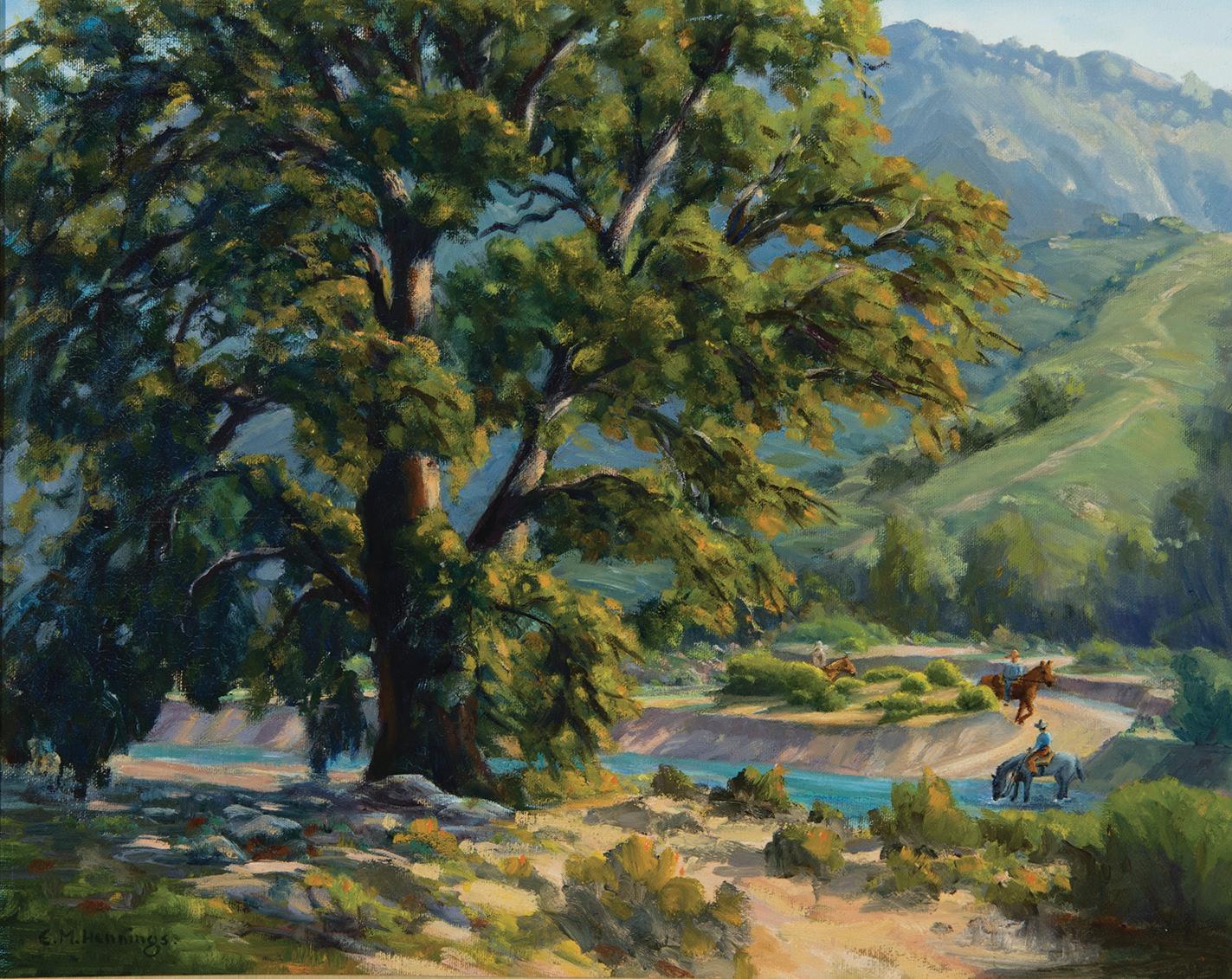
191
E. Martin Hennings 1886-1956
Mountain Stream with Riders
Oil on board
16 x 20 inches
Signed lower left
Estimate: $10,000 - 15,000
SCOTTSDALE ART AUCTION 91

Bronc
Oil on board
6 x 7 inches
Signed and dated 80 lower right
Estimate: $7,000 - 11,000
The Standoff Watercolor
14 x 20 inches
Signed and dated 36 upper right
Estimate: $2,000 - 3,000


Bucking Bronco
Watercolor
10 x 8 inches
Signed bottom left, dedication and signed and dated 1962 bottom right
Estimate: $1,500 - 2,500
SCOTTSDALE ART AUCTION 92
192
James Bama 1926-2022
Rider with Saddle
193
Edward Borein 1872-1945
194
Olaf Wieghorst 1899-1988
195
The Chief Expecting Friendly Visitors
Watercolor
13 x 19 inches
Signed lower left;
Signed and titled verso
Estimate: $12,000 - 18,000



196
Charles M. Russell 1864-1926
Trigg Silver Series (Complete Set of 10 Sculptures)
Cast Sterling Silver, 16/100
Size varies
Signed
Estimate: $8,000 - 12,000
Provenance:
Charles M. Russell Museum, Great Falls, MT, early 1970s
Private collection, Great Falls, MT
Private collection (by descent), Great Falls, MT Tierney Fine Art, Bozeman, MT, and Thomas Nygard Gallery, Bozeman, MT, 2019
Accompanied by Certificate of Authenticity for each piece
Originally offered in the 1970s at the C.M. Russell Museum, and only to museum members, the Trigg Silver Series consists of 10 finely made and highly detailed sculptures in sterling silver created from the original collection that is now held in the museum’s permanent collection. Limited to just 100 editions (this set is No. 16), the set features a nice grouping of Russell subjects, including buffalo, grizzly bears, bighorn sheep, a pair of mule deer, a seated Native American figure and a turkey, among others.
SCOTTSDALE ART AUCTION 93
Herman Hansen 1854-1924
197
George Carlson b. 1940
Youth and Age
Pastel
17 x 14 inches
Signed and dated 84 lower right; Signed and Titled verso
Estimate: $5,000 - 8,000


198
Michael Maczuga
The Fifth Veda
Oil on canvas
30 x 40 inches
Signed lower right
Estimate: $3,000 - 5,000
SCOTTSDALE ART AUCTION 94

199
Winold Reiss 1886-1953
Zapatista Soldier from Cuernavaca
Pastel
20 x 14 ¾ inches
Signed lower right
Estimate: $5,000 - 8,000

200
Winold Reiss 1886-1953
Mexican Fantasy Watercolor
20 x 14 ¾ inches
Signed lower right
Estimate: $7,000 - 12,000
Literature:
The Mexico Diary: Winold Reiss between Vogue Mexico and Harlem Renaissance. An Illustrated Trilingual Edition with Commentary and Musical Interpretation, Frank Mehring, Trier: WVT Wissenschaftlicher Verlag Trier and Tempe, AZ; Bilingual Press, 2016: Plate 1.
SCOTTSDALE ART AUCTION 95

201
Anna Katherine Skeele 1896-1963
St. Francis and Flowers
Oil on board
24 x 19 ¾ inches
Signed lower left
Estimate: $12,000 - 18,000
Provenance: Bonhams, Los Angeles, CA, 2006
Known for her modernist interpretations of the Southwest and deep love for Taos, New Mexico, Ohio-born Anna Katharine Skeele settled in Monrovia, California, at the age of 16. She would study art first in California with painter Armin Hansen, and then later at the Art Students League of New York City under Charles Hawthorne, as well as in Paris France and Italy. It would be Taos that would linger in her heart, and it was there she spent many summers. She was also a beloved and respected teacher of art.
202
Blanche Grant 1874 - 1948
The Cochiti Bird
Oil on canvas
22 x 18 inches
Signed lower right;
Signed, Titled and Dated 1931 verso
Estimate: $8,000 - 12,000
Provenance:
Heritage Auctions, Dallas, TX, 2018
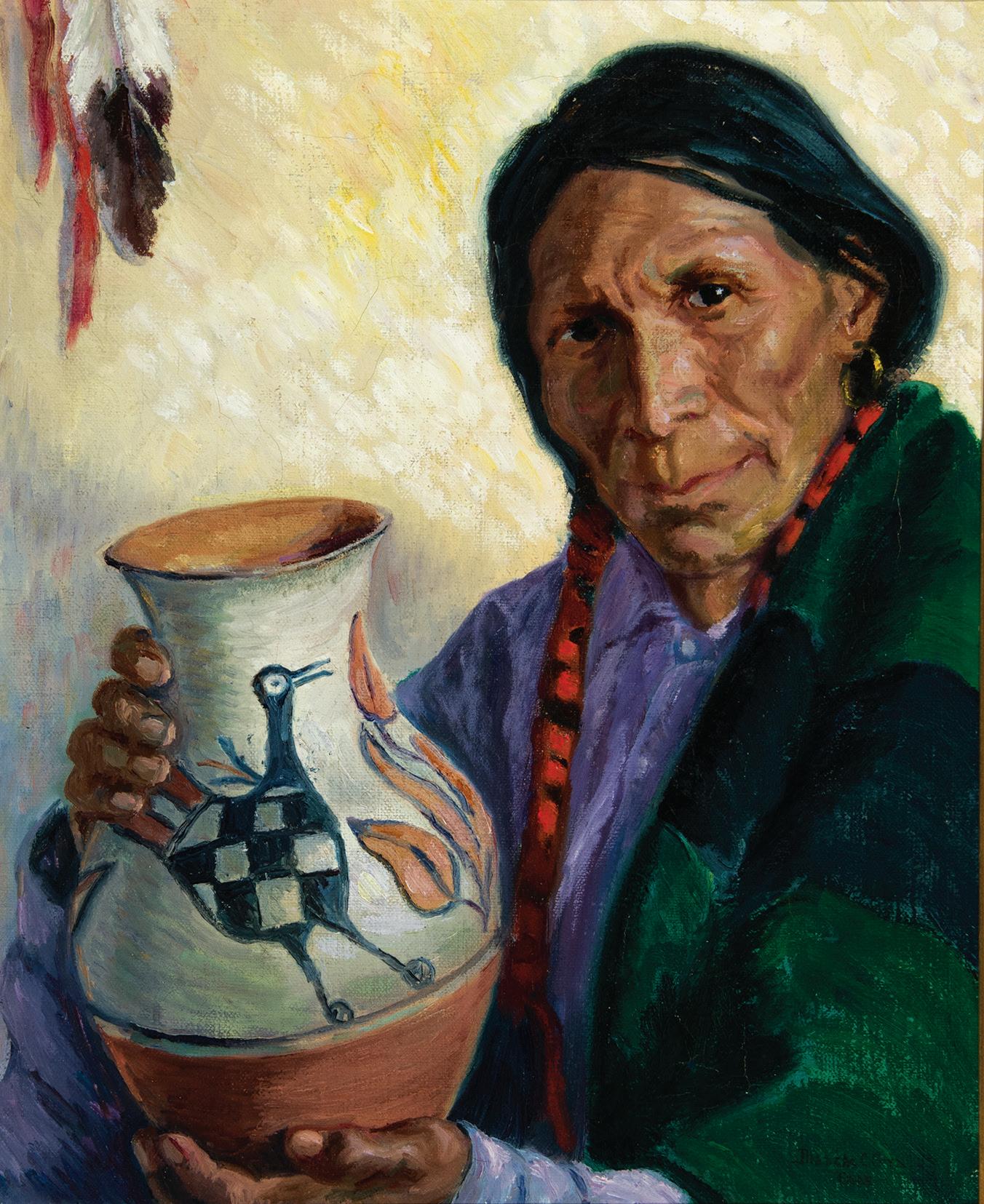
Like many people who arrived in Taos, New Mexico, Blanche Grant arrived with a colorful history. Born in Kansas, but educated in the arts in East Coast schools—with teachers that included William McGregor Paxton, Philip Leslie Hale and William Merritt Chase—Grant left a teaching position in Nebraska to see Europe. A year later she was in Taos, where she painted, was a printmaker, served as the editor of the Taos Valley News and researched Kit Carson. She lived a full life and died at the age of 74. She is buried in the same Taos cemetery as many of the members of the Taos Society of Artists.
SCOTTSDALE ART AUCTION 96
203
AK-ENE
Oil on canvas
24 x 20 inches
Signed and dated 1905 upper left
Estimate: $18,000 - 24,000
Born before Frederic Remington and Charlie Russell, who was a close friend, Edgar S. Paxson had a front-row view of history during the final days of the Wild West. The New Yorkbased artist was encouraged to go West by James Fenimore Cooper novels. After heading to the Montana Territory in 1877, the artist spent time as a cowboy, hunter, stagecoach guard, military scout and a sign painter before becoming an artist. He would go on to paint many historic scenes, although his Native American portraits are highly desirable.

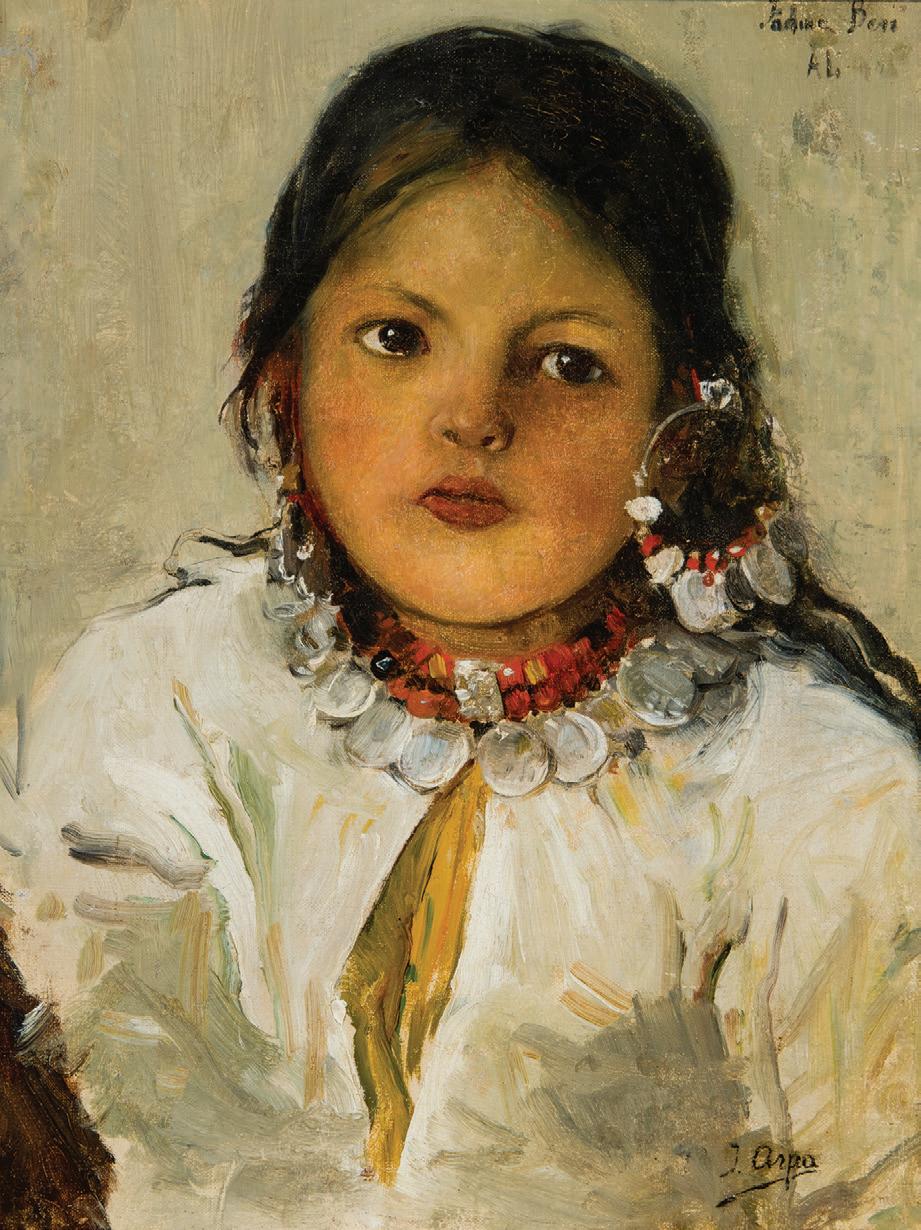
José Arpa 1858-1952
Girl Portrait
Oil on canvas
17 x 13 inches
Signed lower right
Estimate: $18,000 - 28,000
Born and raised in Spain, José Arpa y Perea traveled and studied throughout Europe and Africa, where his brush encountered an array of subjects. His artwork hit American soil before he did in 1893 at the World’s Columbian Exposition in Chicago. Arpa arrived on the continent not long after, where he explored Mexico, Arizona and, famously, Texas. It was in the Lone Star State where he met Robert and Julian Onderdonk, among others, and fell in love with the Texas landscape and its people. He settled in the San Antonio area and was the director of the San Antonio Art School.
SCOTTSDALE ART AUCTION 97
Edgar S. Paxson 1852-1919
204

24 x 18 inches
Signed lower right; Signed and titled verso
Estimate: $8,000 - 12,000
36 x 30 inches
Signed lower right; Signed and titled verso
Estimate: $15,000 - 20,000

SCOTTSDALE ART AUCTION 98
205
Bill Anton b. 1957 Overtime on Granite Mountain
Oil on board
206
Bill Anton b. 1957
Rough Country Rescue
Oil on board
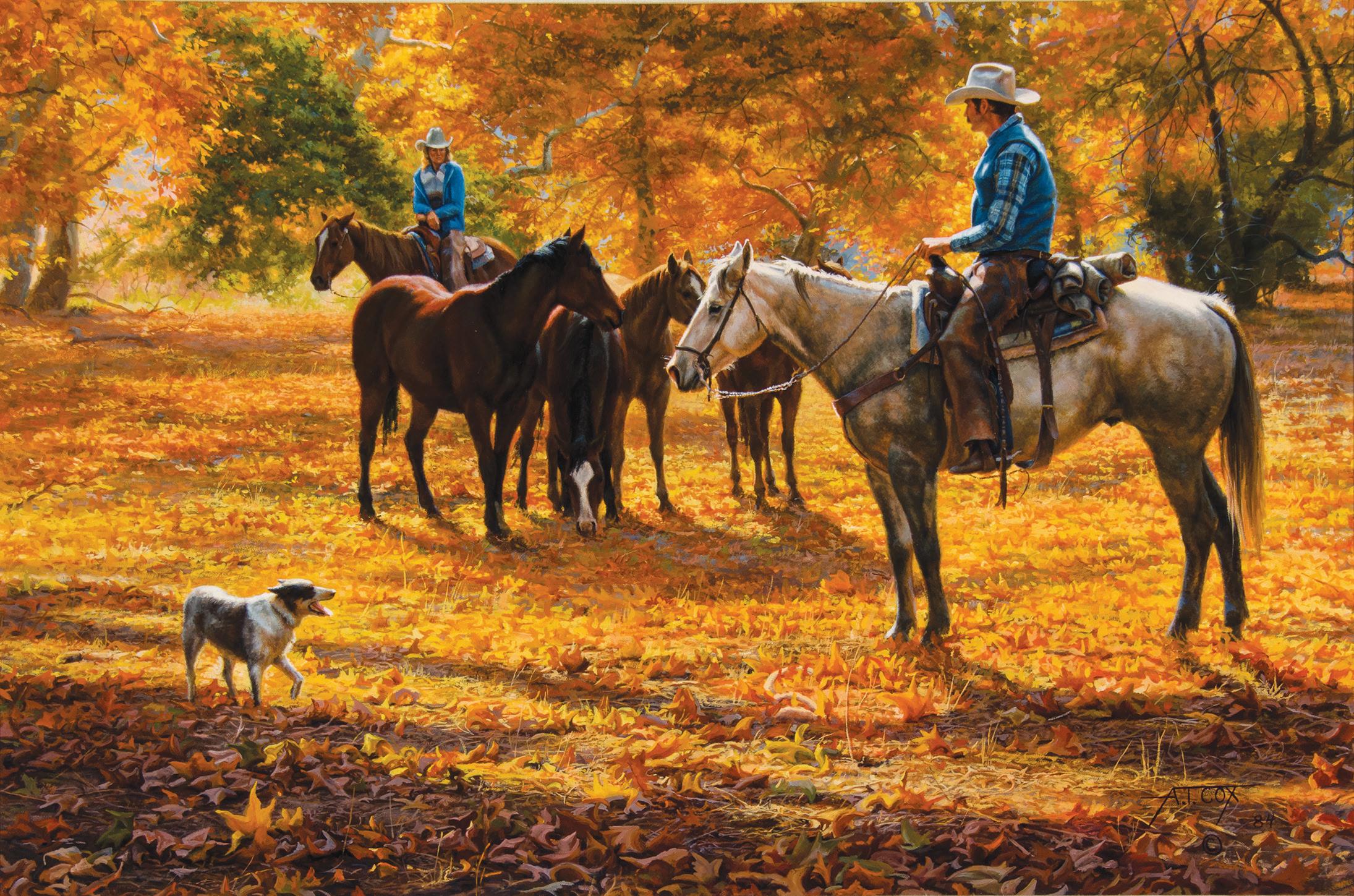
207
Tim Cox b. 1957
Share Our Wealth Oil on board 24 x 36 inches
Signed and dated 84 lower right
Estimate: $10,000 - 15,000
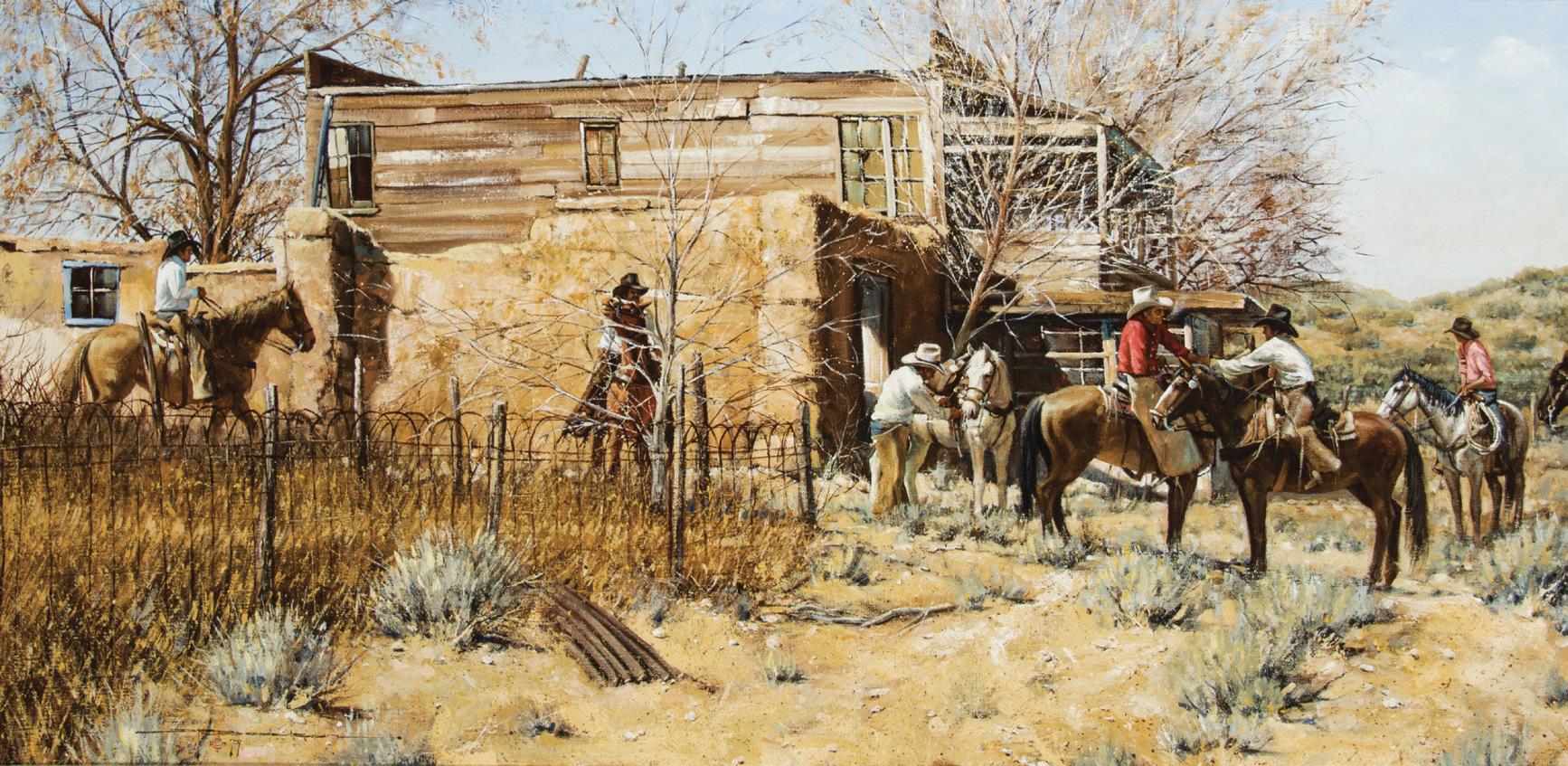
208
Cowboy Rendezvous Oil on canvas 24 x 48 inches
Signed and dated 79 lower left; Also verso
Estimate: $4,000 - 6,000
SCOTTSDALE ART AUCTION 99
Dan Bodelson b. 1949

White Man’s Buffalo
Oil on canvas
24 x 36 inches
Signed/CA lower right
Estimate: $25,000 - 35,000
River Encampment
Oil on board
24 x 30 inches
Signed lower left
Estimate: $12,000 - 18,000

SCOTTSDALE ART AUCTION 100
209
Joe Beeler 1931-2006
210
Michael Coleman b. 1946
211
The Neighbor’s Place
Oil on canvas
12 x 18 inches
Signed and dated 94 lower right
Estimate: $8,000 - 12,000


212
Robert Lougheed 1910-1982
Taos Trapper in Pinion County Watercolor
18 x 36 inches
Signed/CA lower right;
Signed, titled and dated 1974 verso
Estimate: $14,000 - 18,000
Literature:
Follow the Sun: Robert Lougheed, Don Hedgpeth, Diamond Tail Press, Vail, CO, 2010; illustrated p. 282.
Like many artists of his era, Robert Lougheed started life far from the West. It would take the Canadian illustrator nearly 50 years to spend serious time in the West, and when he did it was at New Mexico’s sprawling Bell Ranch for National Geographic. The assignment changed the trajectory of his career. He would go on to become one of the most respected cowboy painters of the second half of the 20th century.
SCOTTSDALE ART AUCTION 101
Tucker Smith b. 1940

213
James Reynolds 1926-2010
Noon Check
Oil on board
28 x 40 inches
Signed/CA and dated 1973 lower left
Estimate: $20,000 - 30,000
After James Reynolds moved from Los Angeles to Arizona, he couldn’t quite wrap his head around the Western lifestyle and how different it was from life in the big city. As he started painting the West, though, it all came into focus rather quickly. He would come to be known as one of the great champions of the American cowboy. “To hear someone casually remark that the West is dead is not an uncommon occurrence these days,” he wrote in 1997. “Many people have the impression that the horse-and-cowboy style of ranching has disappeared in the face of modern technology. I have to challenge that. There have been changes in the past hundred years, but when it gets right down to the job of managing the welfare of cattle in big country, there is only one sure way to do it. And that is with a good cow horse and a good cowboy sitting on top of him. It is a tried and true partnership, and eloquent proof that the West survives.”
SCOTTSDALE ART AUCTION 102

Warrior’s Return
Oil on canvas
16 x 26 inches
Signed/CA and dated 1986 lower right;
Signed and dated 1986 verso
Estimate: $20,000 - 30,000
Jim
Snow in the Willows
Oil on board
36 x 24 inches
Signed/CA lower left;
Signed/CA, titled and dated 11/14 verso
Estimate: $15,000 - 25,000

SCOTTSDALE ART AUCTION 103
214
Frank McCarthy 1924-2002
215
Norton 1953-2023
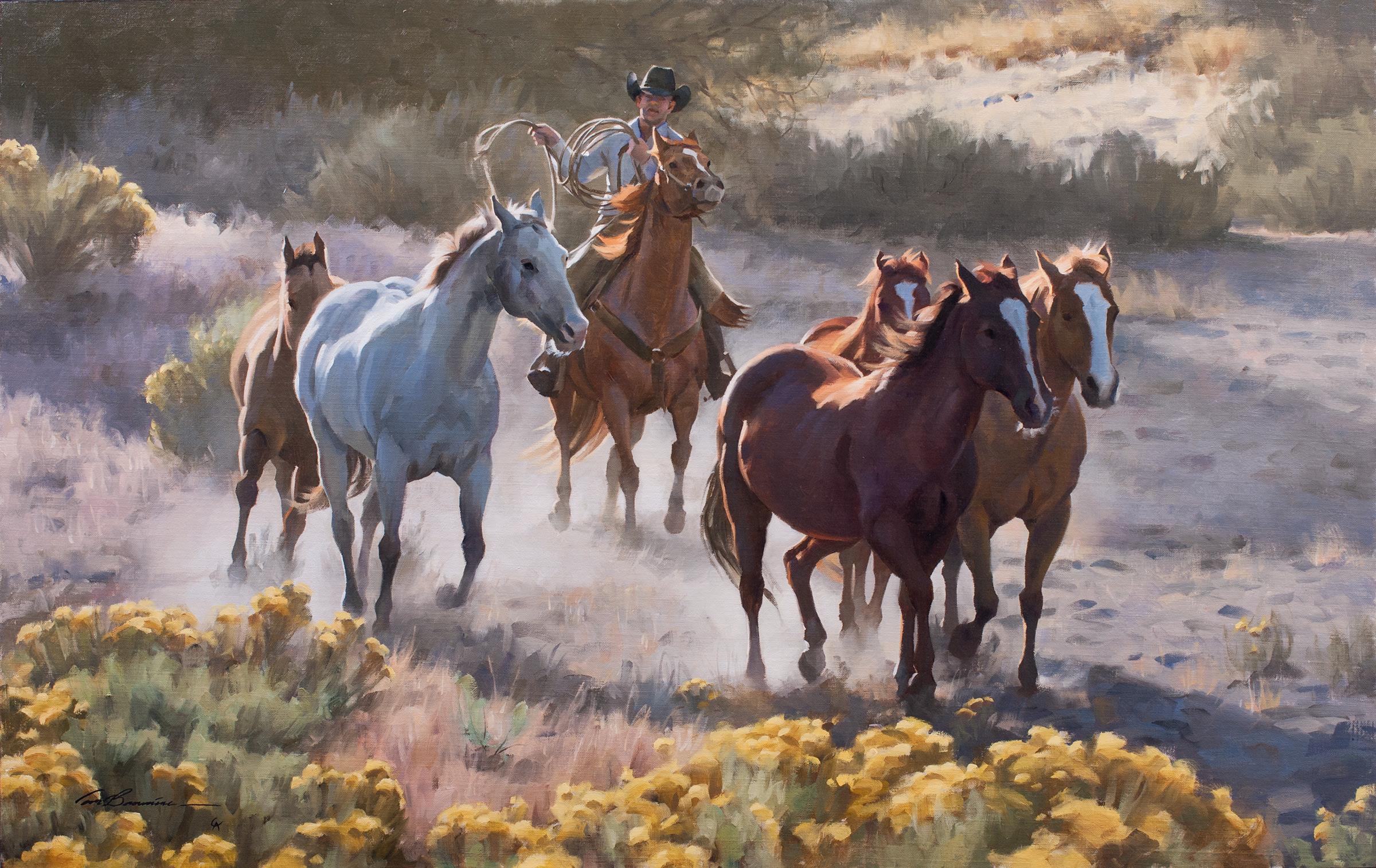
New Recruits
Oil on board
24 x 38 inches
Signed/CA lower left; Signed/CA and titled verso
Estimate: $16,000 - 24,000

Golden October
Oil on canvas
12 x 22 inches
Signed/CA and dated 1984 lower right
Estimate: $8,000 - 12,000
SCOTTSDALE ART AUCTION 104
216
Tom Browning b. 1949
217
Bill Owen 1942-2013

218
Bill Owen 1942-2013
On The Drag
Oil on linen
30 x 40 inches
Signed and dated 1995 lower right
Estimate: $30,000 - 50,000
Provenance:
Private collection, Prescott, AZ, 1995, acquired from the artist
Private collection, Texas
Authenticity was key for Bill Owen, the large and commanding figure who painted working cowboys throughout his career in the West. Born to a cowboy father and an artist mother, Owen was a merging of his parents’ interests. He lived all around Arizona, particularly in areas with rough country that would serve as inspiration for his cowboy paintings. He joined the Cowboy Artists of America in 1973 and helped stabilize the group in the 1970s and 1980s, and again after the passing of Joe Beeler in 2006. For this work, “on the drag” refers to the cowboys that ride behind the herd to keep it moving, including the slower cows with their calves. These rear positions can be exhausting and dusty, and are sometimes reserved for greener cowboys.
SCOTTSDALE ART AUCTION 105

219
Kenneth Riley 1919-2015 Spirit of the Wolves Oil on board
40 x 24 inches
Signed/NAWA and dated 1980 lower right
Estimate: $70,000 - 100,000
Exhibitions:
Museum of Western Art, Kerrville, TX, 1985
West of Camelot, Eiteljorg Museum, Indianapolis, IN, 1993
Kenneth Riley’s work is recognized by historians and curators for a number of reasons, including his delicate color palette, his use of strong male figures to tell stories of leadership, and his careful adherence to historical truth and cultural sensitivity. But, more than anything, Riley is recognized for his compositions, which were ahead of their time when they were created in the 1980s and still ahead of their time here in the 2020s. His strength in design and composition can be seen in Spirit of the Wolves, a work created in 1980. Composition begins with the Idea, which Riley uses with a capital I in West of Camelot: The Historical Painting of Kenneth Riley
“In the mid-1960s I became intrigued with the intricacies of composition and design. Design, I decided, was the skeleton upon which everything in a painting hangs…After nearly 30 years of putting these principles into practice, I’m more convinced than ever of the powerful role design plays in presenting an Idea and communicating it to the viewer,” he writes. “In order to project an Idea or convey a feeling, an artist must be capable of a high degree of organization and an ability to present his Idea forcefully, yet simply and directly. The obligation the artist has to anyone viewing his work—whether an illustration for a story, still-life painting, portrait or mural—is to present the Idea in a fresh way. What will interest the viewer most is seeing something of the individual in the work.”
SCOTTSDALE ART AUCTION 106
220
Kenneth Riley 1919-2015
Eye of the Antelope
Acrylic on board
14 x 16 inches
Signed/CA lower right
Estimate: $20,000 - 25,000


221
Kenneth Riley 1919-2015
The Outrider
Acrylic on board
8 x 16 inches
Signed and dated lower right
Estimate: $8,000 - 12,000
SCOTTSDALE ART AUCTION 107
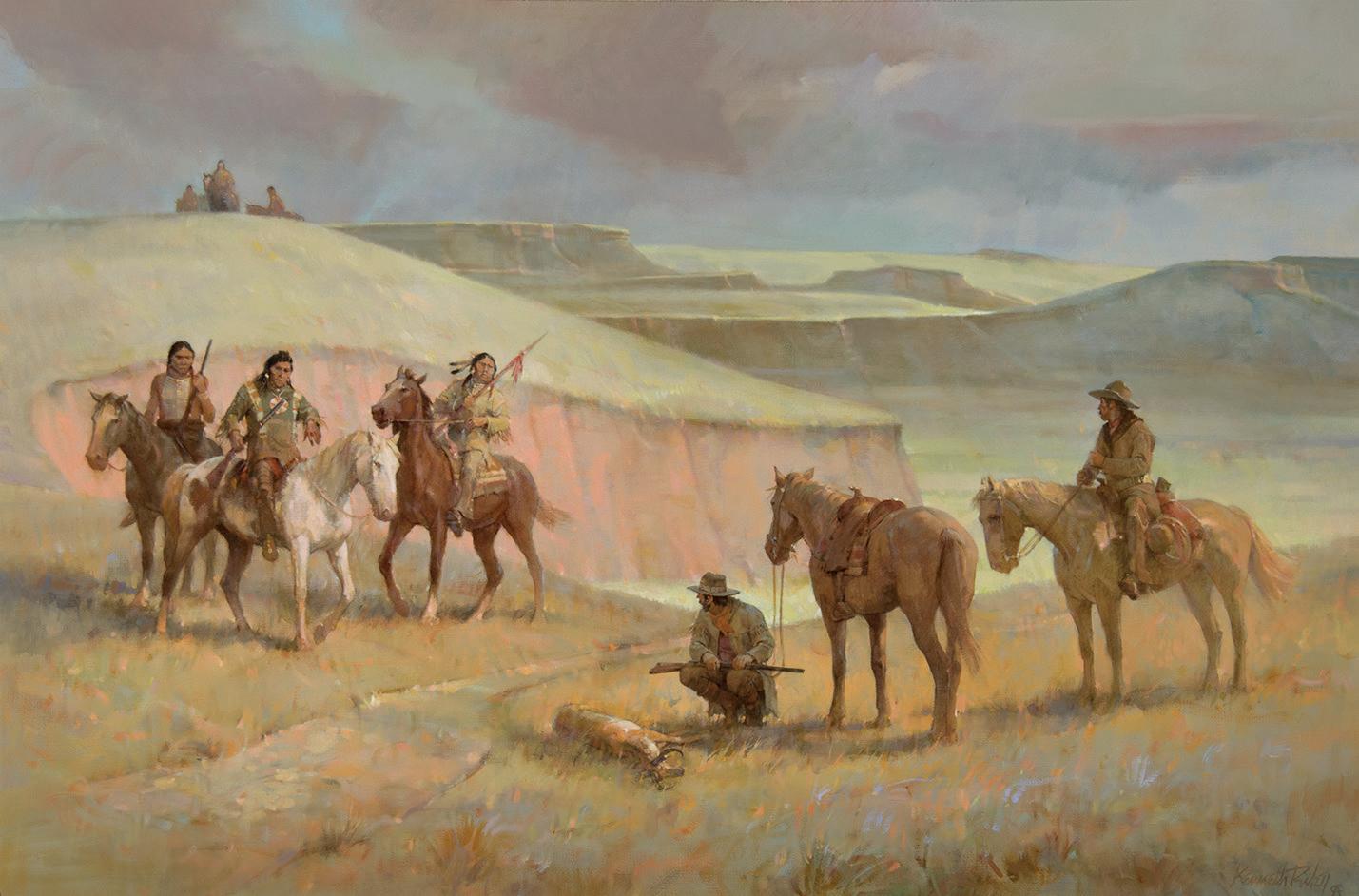
222
Kenneth Riley 1919-2015
Claiming the Kill Oil on canvas 24 x 36 inches
Signed/CA lower right
Estimate: $25,000 - 35,000
SCOTTSDALE ART AUCTION 108

Leaving No Tracks
Oil on canvas
40 x 30 inches
Signed and dated 2019 lower left
Estimate: $50,000 - 75,000
SCOTTSDALE ART AUCTION 109
223
Robert Griffing b. 1940

Don Oelze
Ambush Road
Oil on canvas
36 x 50 inches
Signed lower left
Estimate: $20,000 - 30,000
In my painting Ambush Road , the raw essence of the Apache Wars period unfolds on canvas. A scene of suspense takes center stage as armed Apache warriors pursue a stagecoach through the desert. The isolation of the road amplifies the tension, with the unsuspecting stage driver blissfully unaware of the imminent danger charging thunderously from behind. The dust kicked up by galloping hooves adds a layer of urgency to the moment, creating a dramatic image of conflict and impending confrontation. This work I believe captures the essence of a pivotal and dangerous chapter in the history of the Southwest. I invite viewers to step into the heart of the Apache Wars and witness the intensity of this era. - Don Oelze
110 SCOTTSDALE ART AUCTION
224
b. 1965

225
Z.S. Liang b. 1953
Recalling Past Glory
Oil on linen
34 x 48 inches
Signed lower right
Estimate: $40,000 - 60,000
After many years had past, a Cheyenne war chief is recalling where he had received the trophy long knife in a battle. -Z.S. Liang
SCOTTSDALE ART AUCTION 111
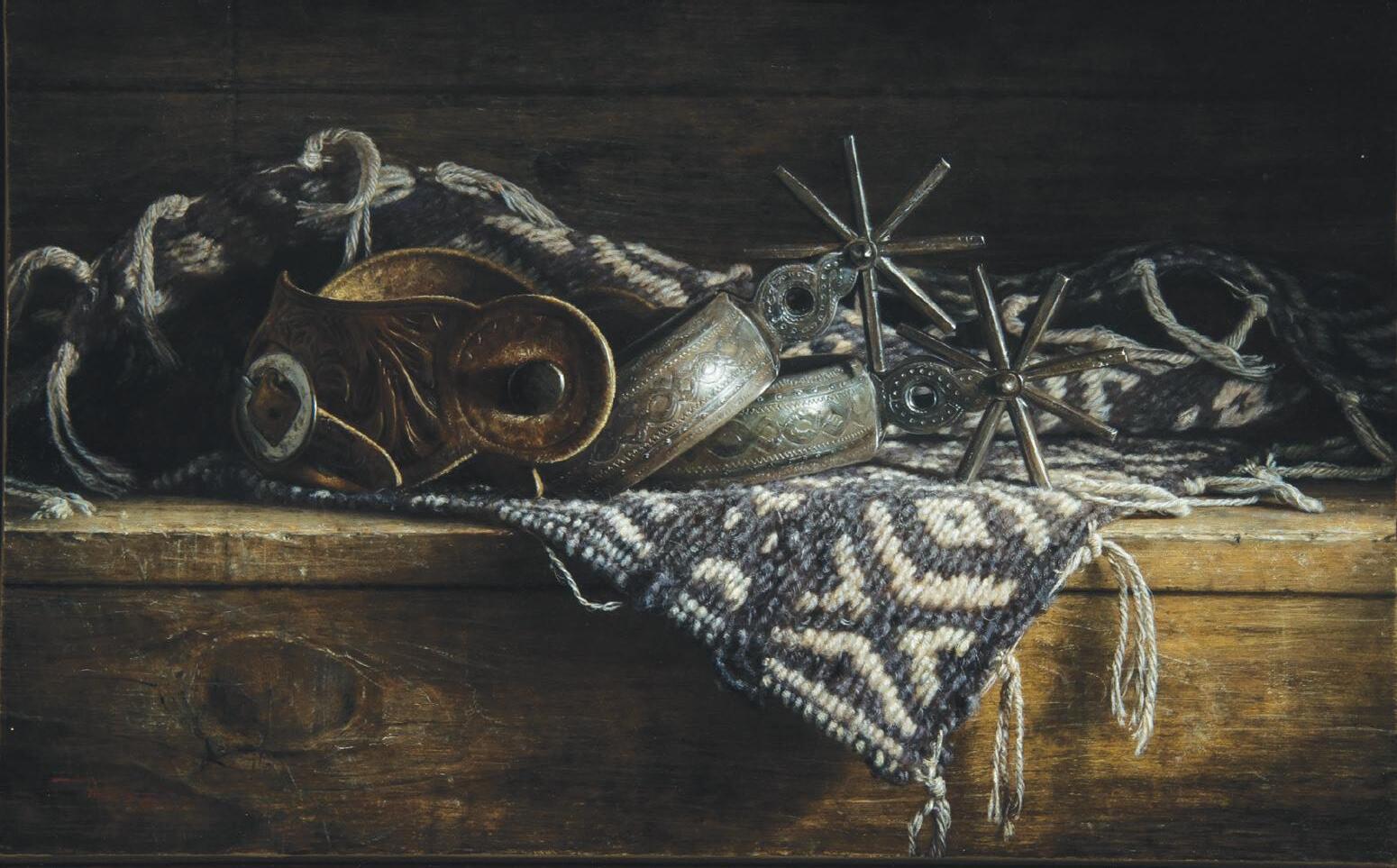
Morning Light
Oil on canvas
12 x 19 inches
Signed lower left
Estimate: $25,000 - 35,000
Spirit of the Plains
Oil on canvas
19 x 10 inches
Signed lower left
Estimate: $18,000 - 28,000

SCOTTSDALE ART AUCTION 112
226
Kyle Polzin b. 1974
227
Kyle Polzin b. 1974

Oak and Amber Oil on canvas 22 x 37 inches
Signed lower right
Estimate: $35,000 - 55,000
The warm glow of aged whiskey radiates from a collection of half-empty bottles. The play of light and shadow accents the intricate details of each label, weathered by the years. The composition captures a sense of quiet contemplation, inviting viewers to remember bygone moments and the allure of well-aged spirits. -Kyle Polzin
SCOTTSDALE ART AUCTION 113
228
Kyle Polzin b. 1974

Buffalo Shield
Oil on canvas
48 x 29 inches
Signed lower left
Estimate: $65,000 - 95,000
SCOTTSDALE ART AUCTION 114
229
Kyle Polzin b. 1974

El Torro
Oil on canvas
26 x 40 inches
Signed lower left
Estimate: $35,000 - 50,000

Ancient of Days
Oil on canvas
30 x 40 inches
Signed lower right; Signed and titled verso
Estimate: $20,000 - 30,000
SCOTTSDALE ART AUCTION 115
230
Kyle Polzin b. 1974
231
Eric Bowman b. 1960

Sunday Driver
Oil on board
16 x 20 inches
Signed lower right
Estimate: $8,000 - 12,000
Green Mountain
Oil on canvas
30 x 30 inches
Signed lower right; Signed and titled verso
Estimate: $18,000 - 28,000

SCOTTSDALE ART AUCTION 116
232
Eric Bowman b. 1960
233
Eric Bowman b. 1960

Phil Epp b. 1946
Expansive Landscape
Acrylic on board
30 x 40 inches
Signed/CA lower left;
Signed/CA and titled verso
Estimate: $8,000 - 11,000

Edge of Tomorrow
Oil on canvas
30 x 50 inches
Signed lower left
Estimate: $7,000 - 11,000
SCOTTSDALE ART AUCTION 117
234
235
Colt Idol b. 1992

Men of Importance
Oil on board
36 x 36 inches
Signed lower right;
Signed, titled and dated 2017 verso
Estimate: $20,000 - 30,000
The Germantown Blanket
Oil on board
36 x 24 inches
Signed/CA lower left;
Signed/CA, titled and dated 2009 verso
Estimate: $8,000 - 12,000

118
236
John Moyers b. 1958
237
John Moyers b. 1958
SCOTTSDALE ART AUCTION

The Fragrance of Rain Oil on canvas 30 x 30 inches
Signed lower left, “TAOS”; Signed and titled verso
Estimate: $28,000 - 38,000
SCOTTSDALE ART AUCTION 119
238
Jerry Jordan b. 1944

Wunnestow, The White Buffalo Bronze, cast 21/35 34 inches overall height
Signed; Carl Bodmer series
Estimate: $15,000 - 25,000
Literature:
John Coleman Past/Present/Future, Retrospective, Scottsdale's Museum of the West 2016; illustrated p. 51

Graceful
Bronze,
8/20 28 inches overall height
Signed/CA, titled and dated 2016
Estimate: $8,000 - 12,000
Literature:
John Coleman Past/Present/Future, Retrospective, Scottsdale's Museum of the West 2016; illustrated p. 64
SCOTTSDALE ART AUCTION 120
239
John Coleman b. 1949
240
John Coleman b. 1949
Spirit
cast
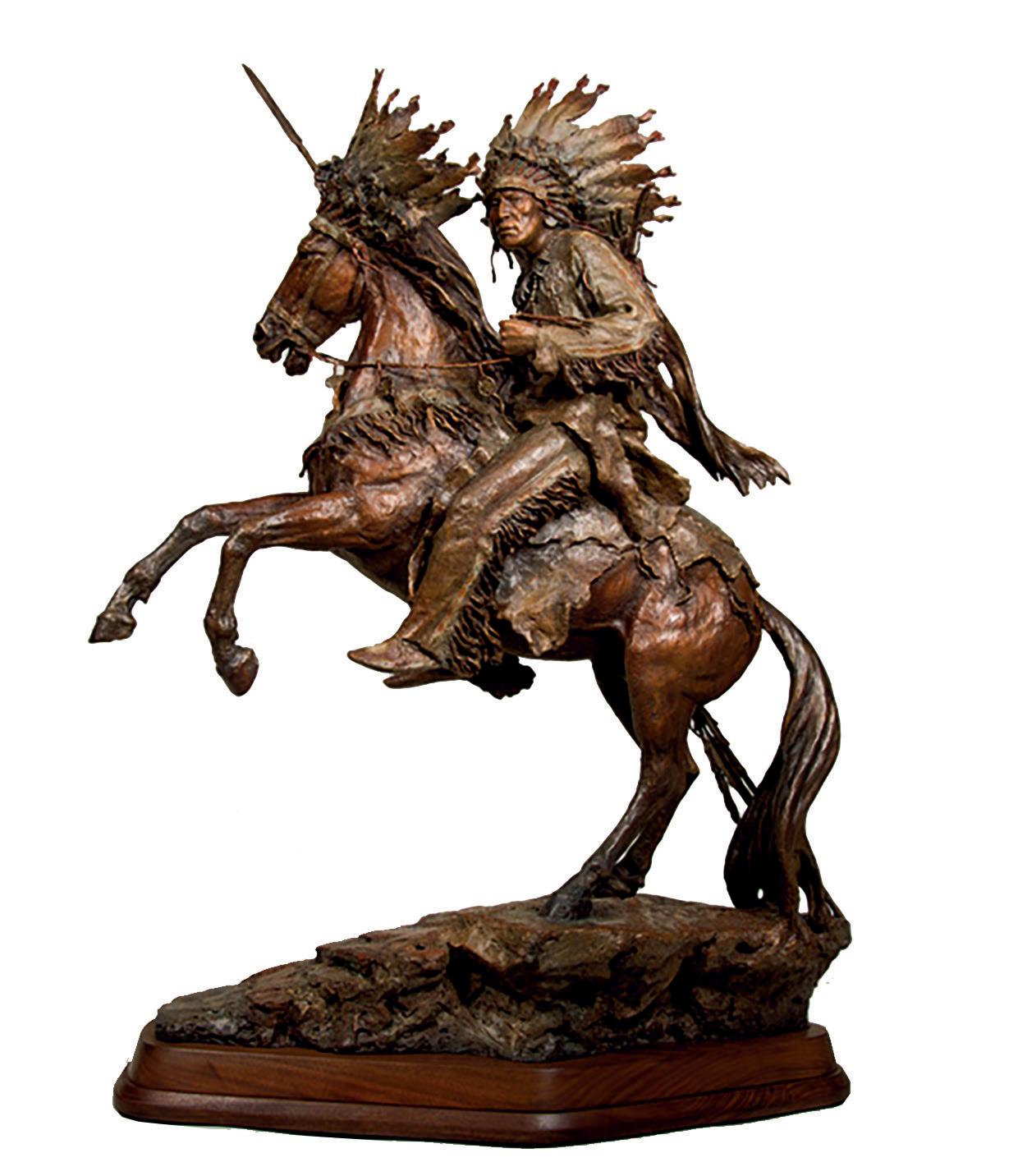
Bronze,
47 ½ inches
Signed, titled and dated 2018
Estimate: $45,000 - 65,000
SCOTTSDALE ART AUCTION 121
241
John Coleman b. 1949
He Who Jumps Over Everyone
cast 2/9
high

Oil on canvas
40 x 32 inches
Signed and dated 2018 lower left
Estimate: $75,000 - 125,000
SCOTTSDALE ART AUCTION 122
242
Mark Maggiori b. 1977
Wild Thing

The Crossing
Oil on canvas
27 x 36 inches
Signed and dated 2018 lower right; Ontario - Okanagan Lake verso
Estimate: $75,000 - 100,000
Provenance:
Masters of the American West, Autry Museum of the American West, Los Angeles, CA, 2018
In his first year at the Masters of the American West at the Autry Museum in Los Angeles, Mark Maggiori brought several key paintings that would help establish his work within the world of Western art. One of them was The Crossing, showing a chaotic river crossing with dozens of figures on horses and nearly as many covered wagons. It was an ambitious work, particularly with splashing water in the foreground and detailed mountain peaks in the top half of the image. “After I finished the mountains, I had to put the whole bottom part aside for maybe two months,” Maggiori told Southwest Art. “Then, one morning, I told myself to just do it, step by step, like climbing a gigantic staircase. It took me maybe three weeks of long, hard, sweaty days and lots of coffee. But it was one of those epic paintings I want to do once in a while.”
Born in France, Maggiori first experienced the American West from the inside of a car during a month-long trip across the United States. He was 15 years old, and the journey left a profound impression on the young man. Back in France, Maggiori detoured into other professions, including animation, photography and the lead singer of the rock band Pleymo, which was a sensation in Europe. After the band went on a hiatus, Maggiori moved briefly to Kingman, Arizona, where he would slowly piece together the beginnings of his art career. It would soon take off like a rocket. Gallery shows, museum exhibitions, auctions, hugely successful print releases—his growing fanbase helped make sure each new work was a hit. This upward momentum culminated in a March 2023 show that sold more than $3 million of new paintings and drawings. It holds the record as the most successful solo show in Western art history.
123 SCOTTSDALE ART AUCTION
243
Mark Maggiori b. 1977
244
Mark Maggiori b. 1977
The Old Cowboy
Charcoal and Ink wash
32 x 38 inches
Signed and dated 2016 lower left
Estimate: $8,000 - 12,000


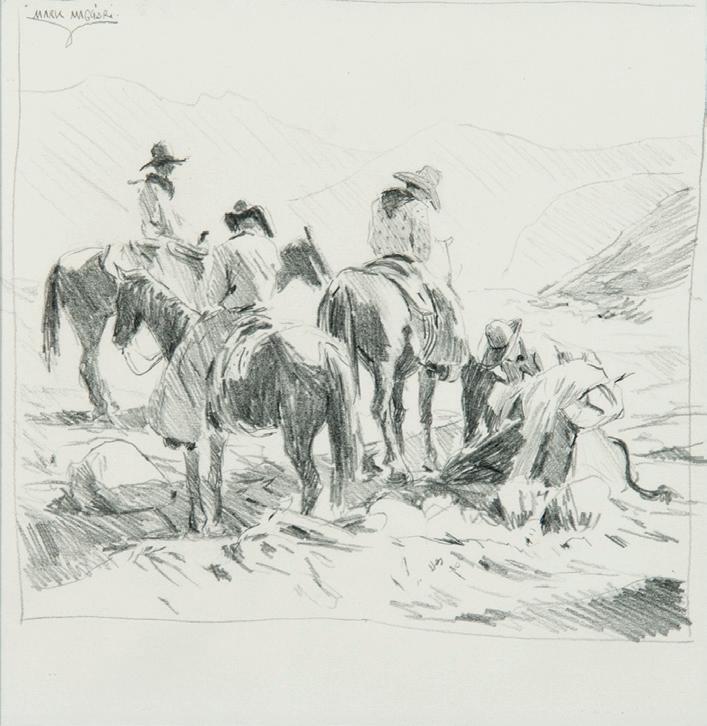
245
Mark Maggiori
Set of two sketches: Sun & Saddle; Cowboys at Work
Pencil drawings
8 x 10 inches; 8 x 8 inches
Signed and dated 2014 lower right, titled upper right; Signed upper left
Estimate: $3,500 - 5,000
124 SCOTTSDALE ART AUCTION
b. 1977
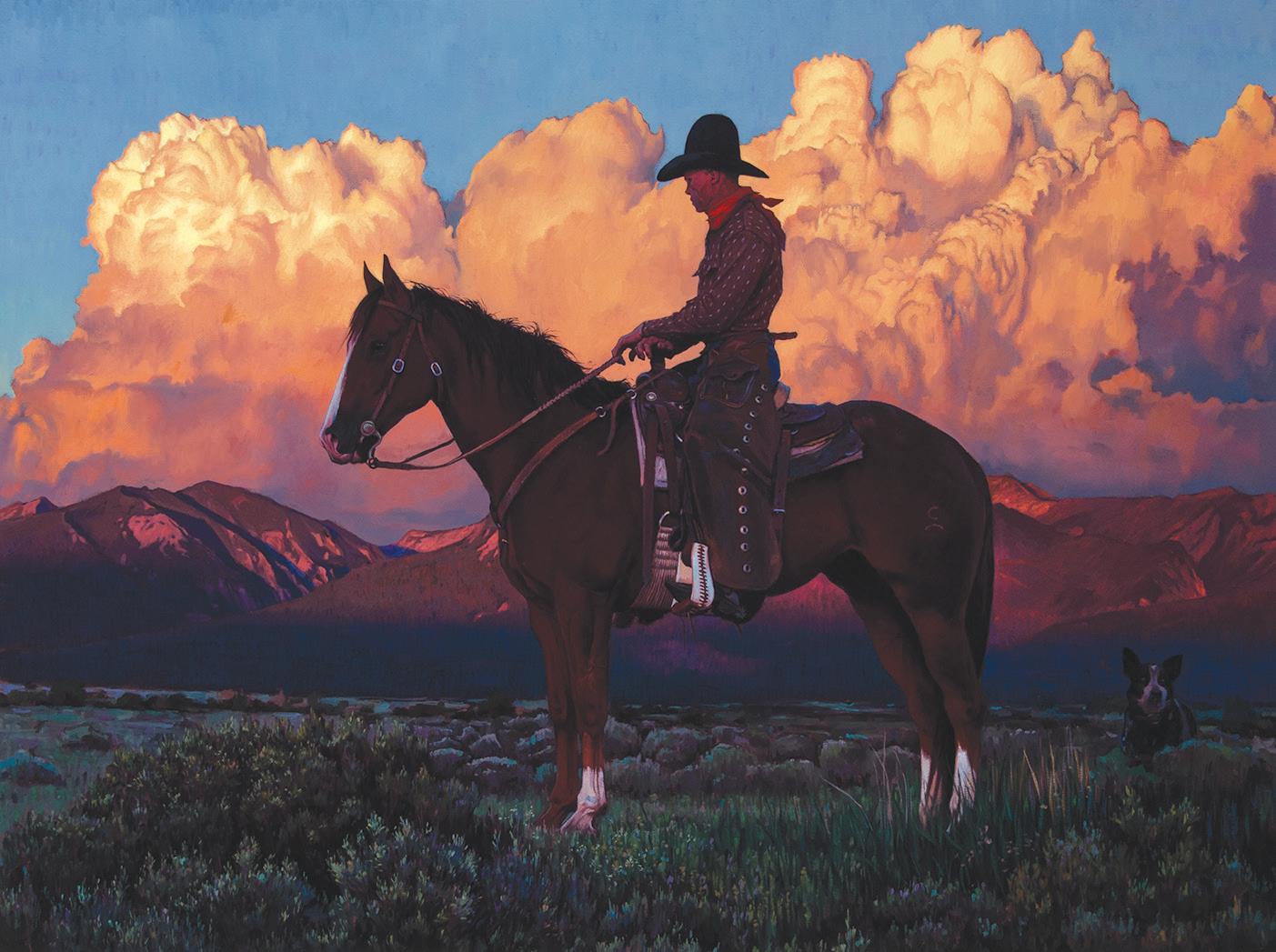
246
Mark Maggiori b. 1977
And the Mountains Echoed
Oil on linen
30 x 40 inches
Signed and dated 2017 lower right
Estimate: $100,000 - 150,000
Provenance:
Trailside Galleries, Scottsdale, AZ, 2017
Private collection, Texas
After settling initially in Kingman, Arizona, and then Los Angeles, Mark Maggiori moved to Taos, New Mexico, where he built a studio that had the same views as many of the founders of the Taos Society of Artists. The French artist shared another bit of history with those distinguished painters: like Maggiori, four of the six founders (Blumenschein, Phillips, Sharp and Couse) had all studied in Paris before coming to America to paint the Southwest. He was in good company walking those streets, wandering those hills and painting the people of the Taos Pueblo.
And the Mountains Echoed was created in a busy period in 2017 just prior to Maggiori’s move to Taos. At that time, he was painting a great deal at the Grand Canyon, Vermilion Cliffs and the Grand Tetons, all of which show up in numerous works around 2017 and 2018. This was a tremendously busy period for the artist, who was still trying to establish a solid foothold in Western art. Works like And the Mountains Echoed were important early paintings that helped launch the artist to wider acclaim and stardom.
SCOTTSDALE ART AUCTION 125

Four Gentlemen
Oil on board
30 x 40 inches
Signed lower left
Estimate: $30,000 - 50,000
Texas-based painter Ken Carlson paints most of the large North American mammals from his Kerrville studio. These include bears, moose, elk, wolves, bison, pronghorn and whitetail deer. He reserves a special place on his easel for images showing bighorn sheep and, as seen here in Four Gentlemen, mountain goats. The majestic mammals, with their small horns and sure footing, cut distinct silhouettes perched amid rocky outcroppings high up in Grand Teton or Yellowstone national parks, as well as other destinations where Carlson finds his inspiration. The animals have been the subjects of many of the master wildlife painters, including Bob Kuhn, Carl Rungius and John Clymer.
Raised in Minnesota, Carlson expressed an early interest in painting and drawing, specifically wildlife art. In between trips to natural areas around the country, where he would photograph and paint wildlife of all varieties, the artist worked in illustration for a TV station and newspaper. When work commitments would keep him near his studio, Carlson would spend his free time at the nearby zoo, where he could still watch and study animals. Even at an early point in his career, personal observation was key to his mission as a wildlife painter. Some of his earliest breaks did not involve large mammals at all, but with birds, including the 1974 publication Birds of Western North America. After he moved to Montana, his paintings began to take hold with collectors, including at major museums. Today his paintings are in prominent collections, private and public, all around the world.
SCOTTSDALE ART AUCTION 126
247
Ken Carlson b. 1937

248
Tim Shinabarger b. 1966 Cliffhanger
Bronze, cast 1/24 35 inches overall height
Signed and dated 2016 Hanging sculpture
Estimate: $8,000 - 12,000
Confrontation
Acrylic on paper
11 x 8 ½ inches
Signed lower right;
Estimate: $10,000 - 15,000

SCOTTSDALE ART AUCTION 127
249
Bob Kuhn 1920-2007
"Best to my old friend Bob Lougheed - Bob Kuhn" under frame
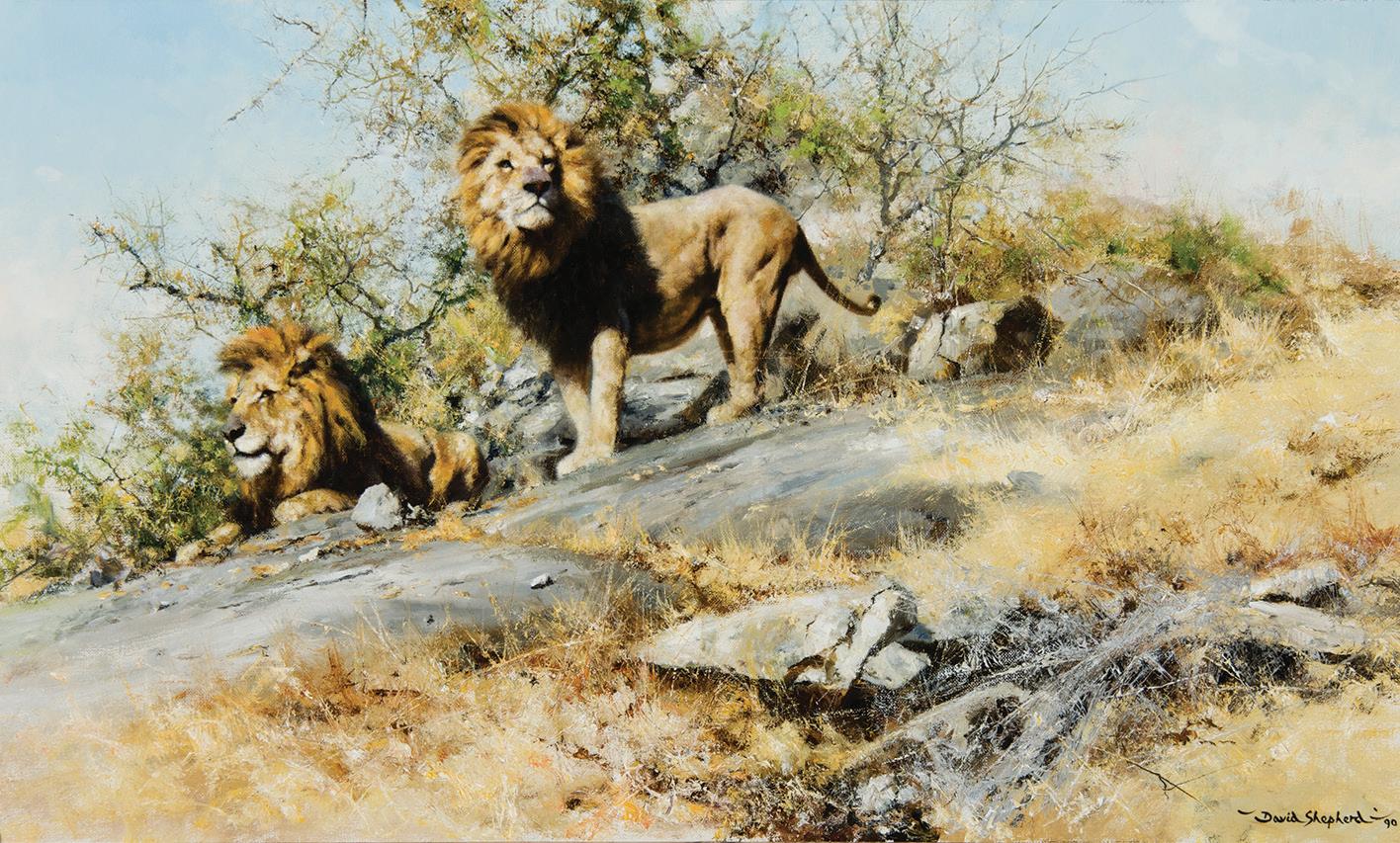
250
David Shepherd 1931-2017
Two Gentlemen of Savuti
Oil on canvas
18 x 30 inches
Signed and dated 90 lower right
Estimate: $45,000 - 65,000
As London-based painter David Shepherd was coming up in the world as an artist, his first assignment was airplanes that sat on an airport runway. Shepherd happened to really like airplanes, so the gig was a good fit, but he longed for something different. He discovered what different was when the British Royal Air Force sent him to Africa to paint even more airplanes. It was there he started painting elephant portraits for the first time—it would change his career. After that fateful 1960 trip, Shepherd became one of the leading artists for African and Asian wildlife, with elephants, tigers and lions as his favorite subjects. In addition to his paintings, which were a hit around the globe, Shepherd also became an outspoken advocate for animal conservation, some of which was funded through his fine art prints and reproductions. One of those hit prints was Two Gentlemen of Savuti, showing two lions scanning the horizon on a hill looking out over northern Botswana. The original painting of Two Gentlemen of Savuti, is being offered here.
SCOTTSDALE ART AUCTION 128

inches
Signed lower right
Estimate: $150,000 - 250,000
251
David Shepherd 1931-2017
Tiger in the Sun Oil on canvas 26 x 52

Oil on canvas
26 x 52 inches
Signed lower right
Estimate: $150,000 - 250,000
Provenance:
Private collection, Nevada
Literature:
David Shepherd: The Man and His Paintings by David Shepherd, published by David and Charles Publishers plc, 1985. Illustrated p. 59
Exhibited:
Jubilee Exhibition, The Tyron Gallery LTD, London, May - June 1977
David Shepherd Exhibition The Tyron Gallery LTD, London, October-November 1978
David Shepherd painted many animals, but few stirred his passion for wildlife conservation the way tigers did. At the center of this passion was Tiger in the Sun, a 1977 painting that is one of the artist’s most well-known works. Not long after it left Shepherd’s easel, the image was reproduced for a limited edition print that would go on to become a huge bestseller and help raise thousands of dollars for tigers in Asia. Even today, the David Shepherd Wildlife Foundation acknowledges Tiger in the Sun as one of the most sought-after images from Shepherd’s catalog. During his lifetime, the artist was acutely aware of the habitat destruction and hunting suffered by the Bengal and Sumatran tiger in South Asia. “You can always build another Taj Mahal, but you can never build another tiger,” Shepherd would say.
The British-born artist is primarily known for three subjects: elephants and tigers, and then also steam locomotives, which he was always keen on mentioning right after his work in the area of wildlife. Trains naturally became a subject for the painter after early assignments at airports all around the world painting airplanes. Later in his career—after many paintings of elephants, planes and trains—he would say he was attracted to “all things jumbo.” Today, his work lives on through the David Shepherd Wildlife Foundation, which continues to fund animal conservation around the world.

252
David Shepherd 1931-2017
The Big Five
Oil on canvas
6 x 6 inches each; 6 x 31 ½ inches (overall)
Signed lower right (each)
Estimate: $30,000 - 50,000
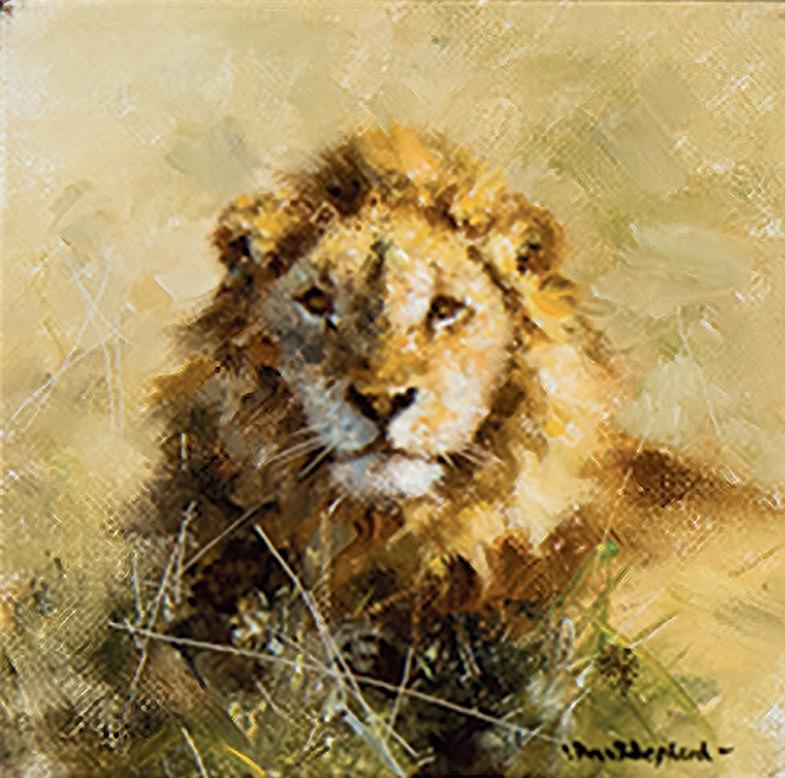



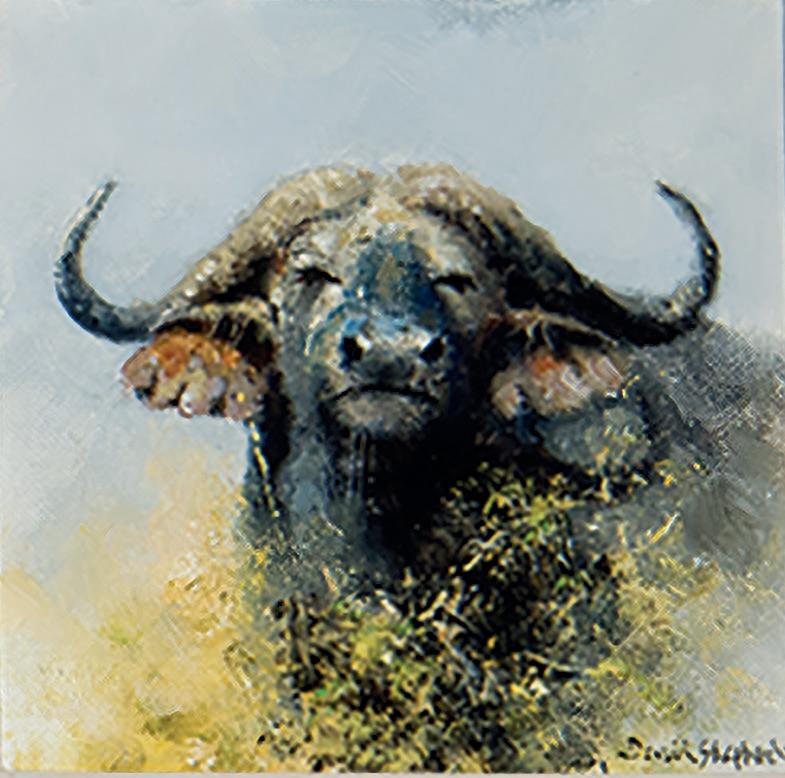
Featuring portraits of African wildlife—rhinoceros, lion, elephant, leopard and cape buffalo—David Shepherd’s The Big Five highlights more than five decades of wildlife work from the British-born artist. A dedicated painter and a passionate conservationist, Shepherd rarely painted North American wildlife, yet his work was collected in the United States and his causes were celebrated.
SCOTTSDALE ART AUCTION 130
129 SCOTTSDALE ART AUCTION
251
David Shepherd 1931-2017 Tiger in the Sun (detail)
A copy of David Shepherd: The Man and His Paintings, by David Shepherd to accompany this lot.

253
David Shepherd 1931-2017
A Happy Elephant
Oil on canvas 24 x 52 inches
Signed and dated 1979 lower right
Estimate: $50,000 - 75,000
David Shepherd painted many types of animals, but he always held a soft spot in his heart for elephants—and also airplanes and steam engines. When he wrote his autobiography, he titled it The Man Who Loves Giants: An Artist Among Elephants and Engines. In the art world, his elephants are king, with top examples fetching high prices both in the United State and the United Kingdom. After his death in 2017, the New York Times relayed one of his early experiences with Africa. “I had one idea only when I was growing up in the 1930s: to go to Africa and be a game warden,” he said in a 2015 television interview. “I had never even been across the channel, so I had no qualifications whatsoever. So I hop into an airplane and fly out to Kenya in 1949 and knock on the door of the head game warden in Nairobi and say, ‘Can I be a game warden?’ And he said, ‘No, bugger off.’ And I came back to England with my world in ruins.” Sadly, he never became a game warden, but in 1960 Shepherd returned to Africa to paint elephants. It was the beginning of a long adventure with the giant animals.
SCOTTSDALE ART AUCTION 131
Serengeti Lion
Bronze, cast 14/35
19 inches overall height
Signed
Estimate: $6,000 - 9,000


Cutting Corners
Bronze, cast 3/35
10 inches high, 24 inches wide
Signed and dated 2009
Estimate: $5,000 - 8,000
SCOTTSDALE ART AUCTION 132
255
Kenneth Bunn 1938-2020
254
Kenneth Bunn 1938-2020

In the Jungle - Tigers
Oil on board
15 x 24 ⅝ inches
Signed and dated lower left
Estimate: $65,000 - 85,000
Provenance:
The Fine Art Society, London, May 1911
Winston Guest, New York
Private collection (by descent)
Sotheby’s, New York, NY, 2005
Private collection, United Kingdom
Private collection, Florida
Although he was given the nickname Lion by fellow painters, Wilhelm Kuhnert also spent a great deal of time painting tigers, as he does here with In the Jungle – Tigers, which is listed as No. 4216 in the artist’s forthcoming catalogue raisonné. The German painter is part of wildlife art’s “Big Four,” which also includes Carl Rungius, Bruno Liljefors, and fellow German painter Richard Friese. “The work of these four artists established a vision of wildlife and wilderness that remains with us today and had a tremendous influence on wildlife artists of the 20th century,” says Adam Duncan Harris of the National Museum of Wildlife Art.
133 SCOTTSDALE ART AUCTION
256
Wilhelm Kuhnert 1865-1926
Bison Graphite
7 x 11 inches
Signed upper left
Estimate: $2,000 - 4,000


Graphite
8 x 15 inches
Signed lower right
Estimate: $1,500 - 2,500
Graphite
9 ½ x 14 inches
Signed lower left
Estimate: $1,500 - 2,500

SCOTTSDALE ART AUCTION 134
257
Wilhelm Kuhnert 1865-1926
259
Wilhelm Kuhnert 1865-1926 Lions on Rocks
258
Wilhelm Kuhnert 1865-1926 Cubs

260
Greg Beecham b. 1954
Trailing Caribou’s Ghost
Oil on linen
24 x 36 inches
Signed and dated 17 lower left; Signed and titled verso
Estimate: $10,000 - 15,000
261
Ken Carlson b. 1937
Gray Wolf
Oil on board
16 x 24 inches
Signed lower left
Estimate: $8,000 - 12,000
Literature:
Patrons Without Peer, The McCloy Collection, by Tom Davis, published by Collectors Covey 2009; illustrated p. 72

SCOTTSDALE ART AUCTION 135

262
Bob Kuhn 1920-2007
On Desert Slopes
Acrylic on board
14 ½ x 18 ½ inches
Signed lower left
Estimate: $55,000 - 75,000
Provenance:
Private collection, Houston, TX
When it came to a Bob Kuhn image, composition was king. Every subject, every color, every form—everything was placed in the composition to the benefit of the image. “I don’t know why I paint animals. All I know is when I was a very little boy, there was something about animals that grabbed hold of me,” he wrote in Profiles in American Art in 1982. “To me, the fun of painting animals is to be the stage manager, the arranger, the fellow who selects out the stuff that doesn’t abet the subject and the mood, and to bring in the things that would enhance the mood. Having the temerity or courage, having figured things out, to bend them or change them when the painting calls for it, is the final test of whether you're functioning as a naturalist or a painter.”
Mountain goats and sheep were common subjects for the artist, who completed many of his best wildlife pieces from his studio in Tucson, Arizona. “To paint mountain sheep one must portray the lofty reaches of their habitat,” he wrote about a similar work in Wild Harvest: The Animal Art of Bob Kuhn. “I know good painters who are obsessed with mountains and paint little else. I love to look at them, and to live at the edge of them, but I’m only a painter of mountains when my animal subjects haul me up (via magic carpet) to their otherwise inaccessible crags and alpine meadows.”
136 SCOTTSDALE ART AUCTION
Provenance:

Goat Heaven
Acrylic on board
14 x 14 inches
Signed lower right
Estimate: $40,000 - 60,000
Jackson Hole Art Auction, Jackson Hole, WY, 2007
Private collection, California
Wildlife painter Bob Kuhn made no secret of the difficulties of painting mountain goats, which are notoriously hard to get to, but not always that hard to see. “Camouflage is not an important attribute of the mountain goat, unless you include the winter months,” Kuhn wrote in The Art of Bob Kuhn. “During late spring, summer and early fall, they stand out on their craggy haunts like a sore thumb. It takes a pretty good climber to scale the heights they favor.” Here in Goat Heaven, Kuhn makes direct reference to those heights with a dizzying background that stretches beyond and below his wildlife subject.
SCOTTSDALE ART AUCTION 137
263
Bob Kuhn 1920-2007

1980
Day by Day
Oil on linen
20 x 30 inches
Signed lower left; Signed, titled and dated 2019 verso
Estimate: $30,000 - 40,000
SCOTTSDALE ART AUCTION 138
264
Logan Maxwell Hagege b.

265
Logan Maxwell Hagege b. 1980
Pursuit of Happiness
Oil on canvas mounted to board 52 x 54 inches
Signed lower right;
Signed, titled and dated 2017 verso
Estimate: $80,000 - 120,000
Provenance:
Masters of the American West, Autry Museum of the American West, Los Angeles, CA, 2018
Literature: Western Art Collector, International Artist Publishing, Scottsdale, AZ, February 2018: cover. *a copy of this magazine (pictured right) to accompany this lot.

SCOTTSDALE ART AUCTION 139

Early Departure - Bent’s Fort Oil on canvas
36 x 48 inches
Signed/CA and dated 2017 lower right;
Signed/CA, titled, and dated 2017 verso
Estimate: $80,000 - 120,000
SCOTTSDALE ART AUCTION 140
266
Martin Grelle b. 1954

The Challenge Oil on canvas 40 x 60 inches
Signed/CA lower right 1999
Estimate: $150,000 - 250,000
SCOTTSDALE ART AUCTION 141
267
Martin Grelle b. 1954

Signed and dated 1988 lower left
Estimate: $20,000 - 30,000
SCOTTSDALE ART AUCTION 142
268
Roy Andersen 1930-2019 Wolf Across the Water Oil on canvas 30 x 40 inches
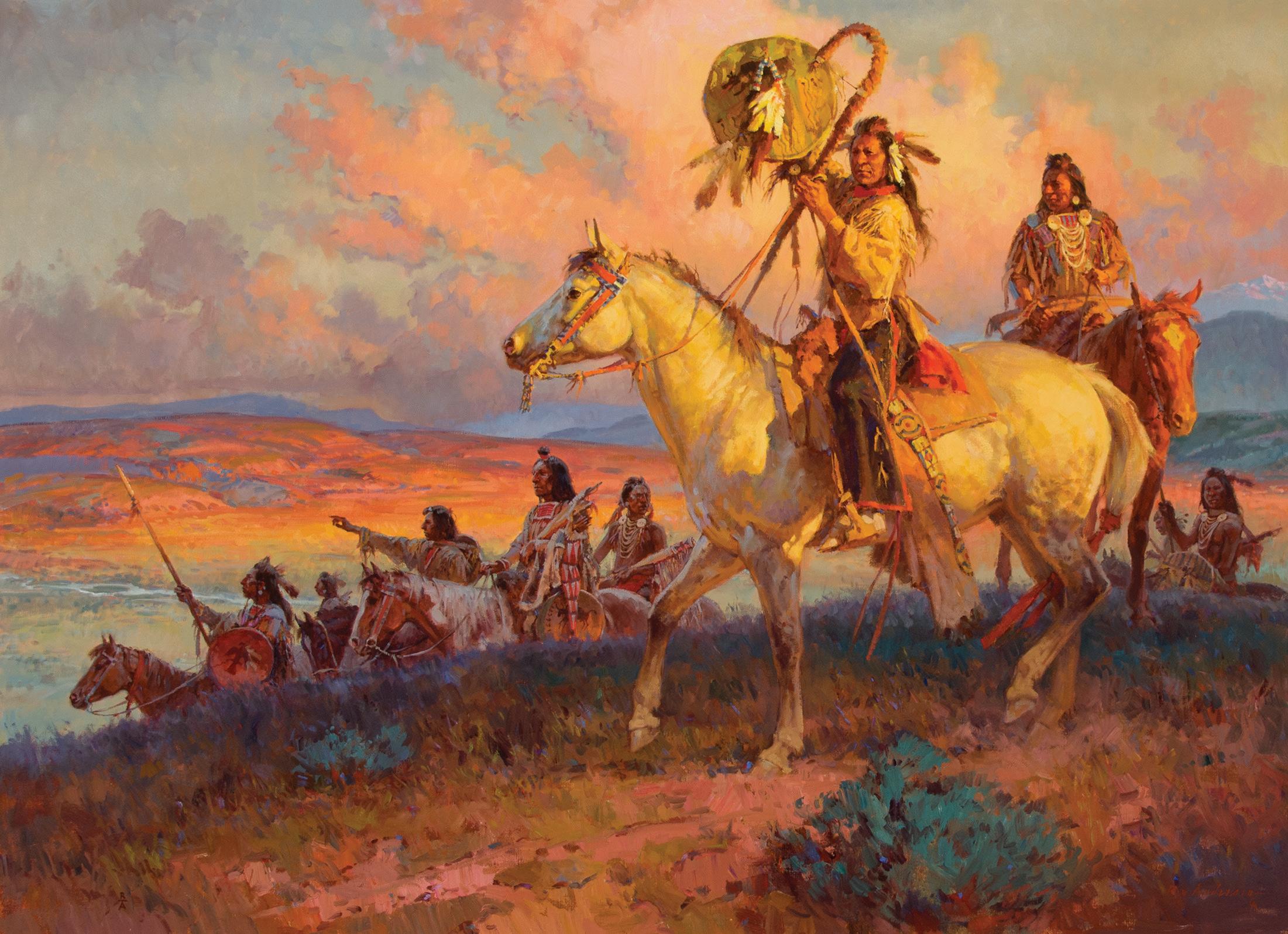
269
Roy Andersen 1930-2019
The Challenge
Oil on canvas
45 x 60 inches
Signed/CA lower right
Estimate: $60,000 - 90,000
Although he painted similar subjects to several of his esteemed contemporaries—artists such as Howard Terpning and Ken Riley—Roy Andersen often pushed his work into new territory with his use of color, which he painted with an intensity that would vibrate on the canvas. He was especially adept at warm tones—red, orange, yellow and gold—which he would use to draw attention to the brilliant light and atmosphere of the Great Plains and its original inhabitants. In
Dream Spinner: The Art of Roy Andersen, the artist provides a picture of his paint palette, which is covered in colors with fascinating names: cadmium yellow orange, rose crimson, thalo rose, cadmium red deep, terra rosa and others. These are the colors that bring his images of Plains Indians to life. They are also the colors that are seen in The Challenge, a large and magnificent piece that exemplifies Andersen’s skills as a painter and colorist.
“Indians believe life moves in circles. I returned to a love of horses and the Native people who lived their lives on horseback. This is now my main focus, not just because Indians are picturesque, but because they are living symbols that express the thoughts of free men and animals moving through a natural world,” Andersen writes in Dream Spinner “They are real, spiritual, serious and honest people looking for a connection between God and their own nature and the beautiful landscape around them.”
SCOTTSDALE ART AUCTION 143
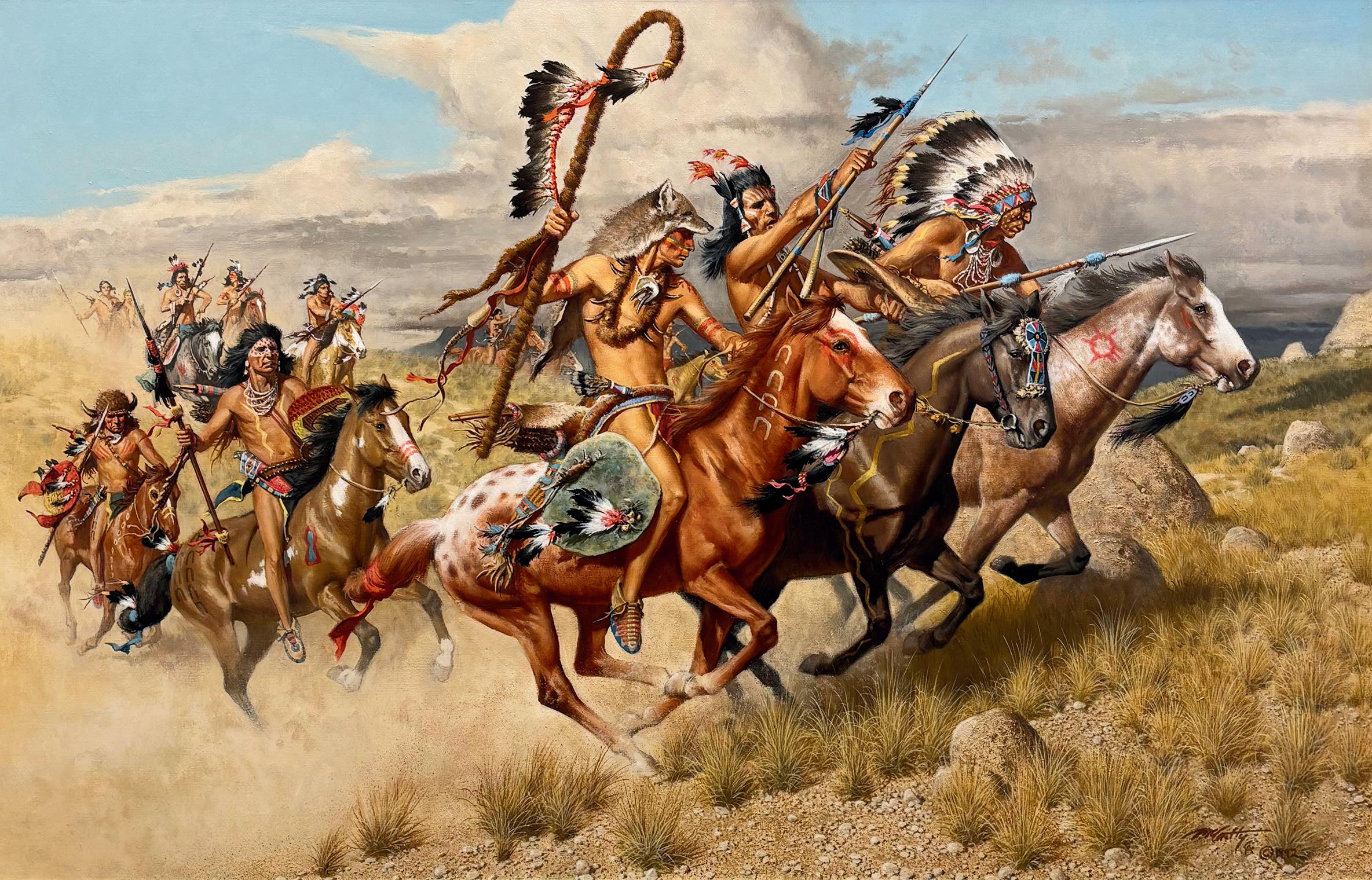
270
Frank McCarthy 1924-2002
Warriors of Savage Splendor Oil on canvas 26 x 40 inches
Signed/CA and dated 1992 lower right;
Signed, titled and dated 1992 verso
Estimate: $45,000 - 65,000
Heart-stopping action, vivid detail and countless figures were hallmarks of Frank McCarthy’s works, but at the end of the day it often came down to the artist’s love of the American West: “Some Western artists document, some do scenery, animals and portraits of Indians,” he writes in The Western Paintings of Frank C. McCarthy. “I paint to achieve visual impact—trying to redesign, if you will, the beauty and character of God’s creation in the West: the mountains, streams, lakes, deserts, and most of all, the rock. I put into this setting the characters that roamed it: mountain men, free traders, cavalry, cowboys and Indians, as well as the vehicles that crossed it such as the wagon trains and the stagecoaches. My paintings are based on truth and their settings in reality, but the events are not specific. I guess the illustrator in me likes to leave the story to the beholder and never end a situation in a painting, always leaving another hill to climb and stream to cross.”
SCOTTSDALE ART AUCTION 144

271
Frank McCarthy 1924-2002
Under Hostile Attack Oil on canvas 24 x 36 inches
Signed/CA lower right;
Signed, titled and dated 1993 verso
Estimate: $45,000 - 65,000
Frank McCarthy was fond of several prominent Western subjects, including mountain men in pristine landscapes and Native American warriors riding into battle. One subject that would come up frequently was the raid on the stagecoach, which provided endless opportunities to show the drama and action that came with the wildest parts of the West. In The Art of Frank C. McCarthy, author Elmer Kenton suggests that the artist favored these scenes because stagecoaches represented the West’s last gasp before the arrival of the railroads on gleaming rails laid down under the desert sun. Kenton writes: “The black smoke of the iron horse signaled the closing chapter in that wild and free way of life, and a new era for an expanding nation.”
SCOTTSDALE ART AUCTION 145

272
G. Harvey 1933-2017
Boot Top Crossing
Oil on canvas
24 x 36 inches
Signed lower right; Signed and titled verso
Estimate: $75,000 - 100,000
Traversing a flooded river during a rainstorm brings with it many risks and few rewards. Therein lies the drama of G. Harvey’s Boot Top Crossing, showing a pair of cowboys in yellow slickers riding through boot-high water pulling a pair of packhorses. The Texas artist painted the rain slicing downward at a slight angle, with droplets splashing off the riders’ waterlogged hats. Harvey’s grandfather was a trail boss at just 18 years old, so he grew up hearing stories of cattle drives, blistering summers, numbing winters and dangerous river crossings. The painting resembles Boot-Top Deep from 1982, which depicts an even more perilous crossing amid churning rapids and a torrential downpour. Boot Top Crossing, on the other hand, shows the resolve of the subjects—the looks on their faces suggest they already have the river beaten.
“These modern cowboys are part of a tradition and way of life. They confront the same weather, stubborn cattle, ranch jobs, loneliness and fears as their great-grandfathers. G. Harvey thinks of them as living legends standing proud against the enticements of modern comforts,” Randy Best writes in G. Harvey: The Golden Era — The American Dream. “He has listened endlessly to the stories of cowboys breaking ice on water troughs before dawn and of digging new ponds to catch the shower of reluctant clouds, always mindful and protective of the year’s profit grazing beside their mothers.”
SCOTTSDALE ART AUCTION 146
Daybreak
Oil on canvas
12 x 16 inches
Signed lower left; Titled and dated verso
Estimate: $20,000 - 40,000


The Evening Carriage
Oil on canvas
16 x 14 inches
Signed and dated 1986 lower left;
Signed, titled and dated 1986 verso
Estimate: $25,000 - 45,000
SCOTTSDALE ART AUCTION 147
273
G. Harvey 1933-2017
274
G. Harvey 1933-2017

275
G. Harvey 1933-2017
Tracks Below the Rim
Oil on canvas 24 x 36 inches
Signed lower right;
Signed and titled verso
Estimate: $75,000 - 100,000
Provenance:
Legacy Gallery, Scottsdale, AZ, 2008
Private collection, Nebraska
Texas painter G. Harvey’s artwork focuses on a period of transition, in more ways than one—the transition between day and night, work and rest, autumn and winter, or the transition between periods in history, like when the horse and buggy were replaced by early automobiles. This push-pull dynamic sets up a clash between the way things were and the way they are now. In Tracks Below the Rim, Harvey uses sunlight and shadow to show the transition of time and place, with the riders getting closer to warmth and light, and further from cold and darkness.
“G. Harvey believes the West, more than any other part of the country, is a state of mind—an independence. He admires the qualities embodied in frontier families, the commitment of a handshake, and an outward toughness but inner gentleness. He saw these characteristics in his own father and, from him, learned that self-reliance and adversity build character,” writes Randy Best in G. Harvey: The Golden Era — The American Dream. “Together, they walked dry riverbeds and searched ancient campsites for the relics of talented hands that shaped tools and weapons. In his paintings, he crosses rivers and the barriers of time. He has painted the same campsites filled with lodges and unshod horses grazing in meadows which adorned the margins of sacred hunting grounds.”
SCOTTSDALE ART AUCTION 148

Distant Signal
Oil on linen
36 x 48 inches
Signed/CA and dated 2015 lower right;
Signed/CA, titled and dated 2015 verso
Estimate: $150,000 - 200,000
Provenance:
Quest for the West, Eiteljorg Museum, Indianapolis, IN, 2015
Private collection, Colorado
Painted in 2015, Distant Signal shows many of the qualities collectors seek in a Martin Grelle painting: gorgeous color, a composition that allows for an intriguing narrative, breathtaking scenery and historical accuracy. The painting was created during two important milestones in the art world: 2015 marked a year-long celebration for the 50th anniversary of the Cowboy Artists of America, and it also marked the 10th anniversary for the Eiteljorg Museum’s Quest for the West exhibition, which is where Distant Signal was sold via live auction. In addition to the Eiteljorg exhibition in Indianapolis, Grelle (and his fellow Cowboy Artists) opened shows and exhibitions in Oklahoma, Georgia and Arizona, as well as smaller gallery shows around the country to mark the CA’s 50th year.
Born in Clifton, Texas, on the northeastern edge of Texas Hill Country, where he still lives today, Grelle began his art career early with his first show while he was still in high school. The young painter looked up to cowboy artists Melvin Warren and James Boren, both of whom lived in Bosque County near him. He was later mentored by Boren before going on to become one of the top living Western artists painting today. Today his works are in many of the most prestigious collections, including a number of major museum collections.
SCOTTSDALE ART AUCTION 149
276
Martin Grelle b. 1954
Tom Lovell 1909-1997
Cottonwood Gazette (two paintings)
Provenance:
Private collection, Texas
Literature:
The Art of Tom Lovell: An Invitation to History, Don Hedgpeth and Walt Reed, William Morrow and Company, New York, NY, 1993: p. 35.
Tom Lovell painted Native Americans as a proud people dedicated to their culture and their ways of life, but he also painted them as a curious people eager to explore and always willing to learn the ways of the visitors who were turning up in their lands. Images with this theme include some Lovell classics: the conquistador trading with the Arapaho in The Iron Shirt, a Native warrior peering down into a bucket well in The Water Hole, and two Lakota riders getting some much-needed heat from the stovepipe of a sod house in The Handwarmer

Cottonwood Gazette fits squarely into this theme with three Native American riders analyzing carvings in the light bark of a cottonwood tree. “Stolen horses and enemy scalps were measures of greatness among the warriors of the Great Plains. They were the trophies of battle, evidence of individual acts of bravery to be celebrated,” Lovell writes in his book The Art of Tome Lovell: An Invitation to History. “In 1840, a party of Cheyennes on a horse-stealing raid were attacked by Pawnees on the south fork of the Republican River. There were no survivors of the Cheyenne raiding party. The victorious Pawnees held a scalp dance near the battle site and recorded the event in pictographs on the trunk of a dead cottonwood tree. In this scene, a party of Sioux scouts reads about the fight. They will carry the tragic news to their Cheyenne allies. In the foreground are the ashes of the Pawnees’ scalp dance fire.”
Lovell would do a number of war scenes throughout his career that showed the ferocity of Native American fighters, but the bulk of his Indian paintings are quieter and more introspective. This is reflected even earlier in his career when he was an illustrator for men’s adventure magazines and other pulp titles, such as The Shadow and Wild West Weekly. After World War II—in which Lovell and John Clymer (with consecutive dog tag numbers) served in Washington, D.C., as illustrators for Marine publications—pulp magazines took on a harder edge with sensationalized images and exploitive content, but Lovell focused on smaller stories that allowed him to spend time on the narrative and figures. His illustration clients included romance-heavy Redbook, National Geographic and True, where the artist painted numerous Civil War images. When the time came to venture off into his fine art career, Lovell brought all he had learned from illustration to his easel. He also brought his interest in American Indians back into his studio. That interest had never left him. In his book, Lovell tells a story about graduating as the valedictorian of his high school. The speech he gave was titled “The Ill-treatment of the American Indian by the U.S. Government.” Lovell writes, “In retrospect, I wonder how the 300 hapless parents felt, being scolded by a 16-year-old on an otherwise cheerful occasion.” The story reveals a greater truth about Lovell: he was concerned about the portrayal of Native Americans long before he was a painter in the West.
Accompanied by: Limited Edition Signed Book: The Art of Tom Lovell: An Invitation to History; Number 977/1500; by Don Hedgpath and Walt Reed, The Greenwich Workshop Inc. 1993, Illustrated on pg. 35
SCOTTSDALE ART AUCTION 150
Cottonwood Gazette oil study

Oil on Canvas, signed/NAWA and dated 1983 lower right and verso 40
Accompanied with the original oil study 10 x 7 ½ inches, signed lower right
Estimate: $200,000 - 300,000
151 SCOTTSDALE ART AUCTION
277
Tom Lovell 1909-1997 Cottonwood Gazette (two paintings)
x 30 inches
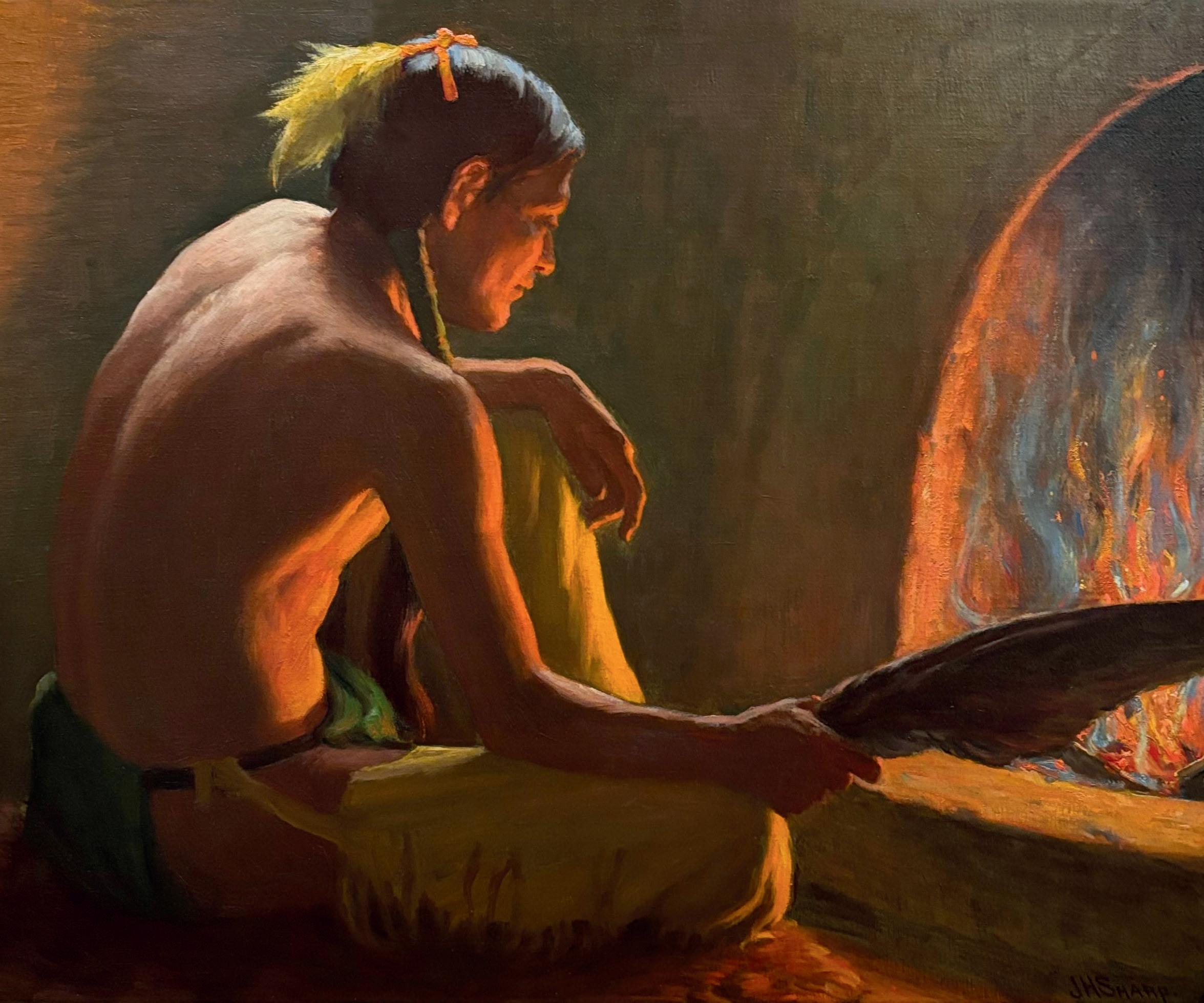
Indian by Firelight
Oil on canvas
25 x 30 inches
Signed lower right
Estimate: $90,000 - 120,000
Provenance:
Private collection, Massachusetts
When Joseph Henry Sharp settled in Taos, New Mexico, his first studio was the Luna Chapel in 1908. The small Spanish adobe building, originally built in 1835, was renamed the Studio of the Copper Bell and was used for six years before the artist needed room to expand. Sharp eventually moved into his second studio, completed in 1915, that allowed for more space and storage. The star of the new studio, though, was a small round window with a square frame, and below it a kiva fireplace. The window and the fireplace have appeared in dozens of Sharp paintings, many showing figures standing at the window lit by brilliant afternoon light or, as is the case with Indian Sitting by Fireside, figures kneeling near the crackling fire as it casts orange light into the room. Today, both the Luna Chapel and Sharp’s second studio are part of the Couse-Sharp Historic Site in Taos.
Like his neighbor and friend Eanger Irving Couse, Joseph Henry Sharp focused a great deal of attention on interior scenes of Taos people examining objects or gazing into the fire. But Sharp was also fond of exploring the region to find new outdoor subjects. In addition to his work in Taos, Sharp also spent time on the Crow Reservation in Montana, where he had a studio built by President Teddy Roosevelt’s Indian Commission. Summers in Montana beginning in 1901 yielded a stunning collection of more than 200 Native American portraits, many of them in museum collections today.
SCOTTSDALE ART AUCTION 152
278
Joseph Henry Sharp 1859-1953

Provenance:
Braus Art Gallery, New York, NY, 1915
Mr. Lutz, 1916
Private collection, Williamson, GA
Private collection, Texas
Literature:
279
Eanger Irving Couse 1866-1936
The Sculptor
Oil on canvas
24 x 20 inches
Signed lower right
Estimate: $90,000 - 120,000
American Art News, “14 Indian Pictures at Braus Gallery,” New York, April 9, 1915, image was published with title Indian Sculptor.
Painted just a year before the formation of the Taos Society of Artists, Eanger Irving Couse’s painting The Sculptor (also referred to as Indian Sculptor by the artist) shows a Native American figure using tools to carve a pictograph figure into a wall. The piece was originally presented in a show at the Braus Art Gallery, from April 8 to 17, 1915, in New York City. The solo exhibition, which received notice in art publications at the time, included other classic Couse works The Medicine Water, The Pueblo Housetop and Prayer to the Water God. In addition to the paintings in the exhibition, Couse also decorated the gallery with pottery and other Native American items from his collection to help set a mood that would transport visitors to the Taos Pueblo. “The Rocky Mountain region abounds in pictographs cut into the rocks by the ancient Indians representing figures of men and animals and symbols of natural phenomenon,” Couse wrote about his subject. “Having no written language, the Indians depicted their deeds and legends by pictorial representation on skin or the rocks…”
153 SCOTTSDALE ART AUCTION

280
Eanger Irving Couse 1866-1936
Kachina Doll Maker
Oil on canvas
24 x 29 inches
Signed lower right
Estimate: $150,000 - 250,000
Exhibitions:
Provenance:
H. Lieber Company, Indianapolis, IN, 1922
Gerald Peters Gallery, Santa Fe, NM
Larry & Utta Kravet, Hewlett Bay Park, New York
Coeur d’Alene Art Auction, Reno, NV, 2014
Private collection, New Mexico
Taos Society of Artists, 1921-22: St. Louis, MO, 1922; Indianapolis, IN; Don Fernando Hotel, Taos, NM; Louisville, KY.
Literature:
E. Irving Couse: 1866-1936, Nicholas Woloshuk, Santa Fe Village Art Musem, 1976: p. 14 as Kachina Doll Maker
In Kachina Doll Maker, Eanger Irving Couse poses a Native American subject on the hearth of an adobe fireplace as he holds a small katsina carving that cuts a strong shape in front of the flames. The subject is Ben Lujan, Couse’s favorite model from Taos Pueblo, who would appear in dozens of the artist’s paintings, including several masterpieces in museum collections. Although katsina carvers are primarily Hopi, there is some precedent for Taos carvings from the early to mid-20th century, including pieces that are in the Smithsonian and the National Museum of the American Indian. These particular examples from this painting are likely Hopi and were probably seen during Couse’s visit to Hopi lands, which began on August 3, 1903. Couse and family took three trains to get to Holbrook, Arizona, where a lumber wagon freighted them 60 miles to Polacca at the base of the Hopi mesas. The artist came well prepared with provisions to last six weeks. The goal of the journey was to see the Hopi Snake Dance, an elaborate prayer for rain. The ceremony takes nine days, much of it within the kivas and closed to outsiders, but on the ninth day dancers emerge for the final ceremony. Couse did see the Snake Dance, at both Walpi and Mishongnovi, but he also experienced plenty more during his travels to the Hopi people. He ate their food, participated in their customs and sketched subjects all around the mesas. He even met Hopi potter Nampeyo. The treasures Couse brought back from the trip, including at least one large kachina, are now part of the Couse-Sharp Historic Site and the Lunder Research Center in Taos.
SCOTTSDALE ART AUCTION 154

281
Carl Oscar Borg 1879-1947
Arizona Navajos
Oil on canvas
30 x 34 inches
Signed lower right
Estimate: $75,000 - 125,000
Provenance:
Private collection, Arizona
Self-taught Swedish painter Carl Oscar Borg was only 24 years old when he landed in Santa Monica, California, as a seaman on the steamship S.S. Arizonan. On leave in town, Borg laid eyes on a cowboy with a sunburnt face, leather chaps with silver buttons, boots with spurs and a belt with a revolver in a holster. That single image lit a fire in his imagination—“the spark of adventure,” Borg would later say. Back on the Arizonan, the seaman served the boat as it steamed up the coast, out to Hawaii and then back to San Francisco with a load of sugar. Once the boat docked, he jumped ship and never looked back. Borg would go on to become a sensation in California for his Western paintings, etchings and woodblock prints; he befriended Phoebe Hearst, mother to businessman William Randolph Hearst; he worked in Hollywood as an art director with Cecil B. DeMille, Samuel Goldwyn and Douglas Fairbanks; and he was a prominent art teacher later in his life. His true love, though, was Native American people of the Southwest. During his lifetime, and well after, he was praised for his sensitive perspective of American Indians and their cultures. He was especially fascinated by the Navajo people, who are the subject of this painting.
155 SCOTTSDALE ART AUCTION
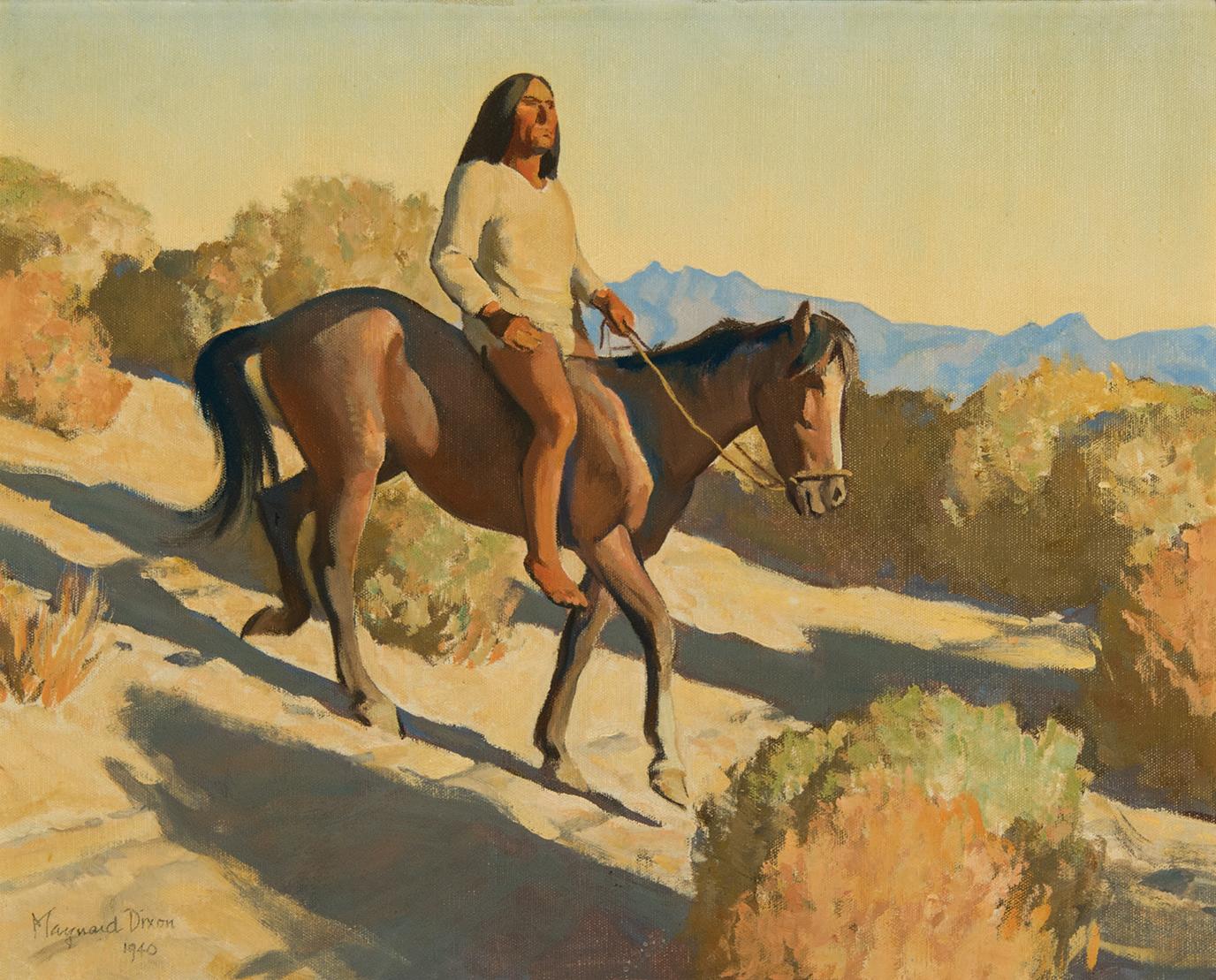
282
Maynard Dixon 1875-1946
Pima Indian
Oil on board
15 ¾ x 19 ¼ inches
Signed and dated 1940 lower left;
Signed, titled and “Tucson, Arizona” verso
Estimate: $55,000 - 75,000
Literature:
Provenance:
Owings-Dewey Fine Art, Santa Fe, New Mexico
Jackson Hole Art Auction, Jackson, WY, 2011
Gerald Peters Gallery, Santa Fe, NM
Private collection, Texas
Maynard Dixon: Artist of the West, Wesley M. Burnside, Brigham Young University, Provo, Utah, 1974: p. 183. (Listed as #582 on Maynard Dixon’s master painting list.)
After Maynard Dixon moved to Tucson, Arizona, he made a series of visits to surrounding Native American communities in the winter of 1939-40. The trip put him in contact with Pima and Papago Indians. Dixon and his wife, painter Edith Hamlin, attended ceremonies and rodeos, and they painted and made sketches of much of what they witnessed. Descendants of the Hohokam, the Pima people, also known as Akimel O’odham, have lived in central Arizona for centuries. Pima Indian, from 1940, was directly inspired by those winter trips.
Dixon’s move to Arizona was largely due to his deteriorating health, which required a drier climate. Prior to the move, the artist and his wife were living in San Francisco, where they had strong ties—Dixon survived the earthquake there in 1906 and helped give the Golden Gate Bridge its famous color—but the weather took a toll on his lungs. When they finally made the choice to uproot their lives from the Bay Area in 1939, they held a large studio sale that was covered in the local newspapers: “Last week brought a closing…of one of San Francisco’s well-established artistic landmarks. The closing is that of Maynard Dixon’s studio at 728 Montgomery Street. Dixon, who has for years been one of San Francisco’s most distinguished muralists and painters of Western life, is leaving this city after 30 years residence, to set up shop somewhere in the desert.” Dixon would call Arizona’s desert home until his death in 1946.
SCOTTSDALE ART AUCTION 156

283
Maynard Dixon 1875-1946
Peaceful Morning
Oil on canvas
16 x 20 inches
Signed and dated Utah 1941 lower right; Titled verso
Estimate: $100,000 - 150,000
Provenance:
W. Herbert Allen, California
Thatcher School, Ojai, CA
Private collection, California, 1980
Private collection by descent, Las Vegas, NV
Sotheby’s, New York, NY, 2011
Private collection, Nevada
Painted in 1941, Maynard Dixon’s painting Peaceful Morning shows a common theme that runs through many of his landscapes of the era—cottonwood trees. “Like cloud formations, cottonwoods are a theme for Dixon from the mid-’30s on—a prominent force in his Tucson, Arizona, and Mt. Carmel, Utah, paintings,” writes Mark Sublette in Maynard Dixon’s American West. Drawings and oil sketches of the period, as well as finished paintings, show Dixon frequently painted cottonwoods, with their golden-yellow leaves and abundance along creek beds in desert valleys. Dixon spent the first half of 1941 in Tucson, where he painted cacti and the Santa Catalina Mountains, and for the second half, he and wife Edith Hamlin journeyed north to their summer home in Mt. Carmel, Utah. The year would also bring about Dixon’s final public mural at California’s Canoga Park Post Office, which is still on view there today.
157 SCOTTSDALE ART AUCTION
Nicolai Fechin
Carmelita
Provenance:
Hammer Galleries, New York, NY
Private collection
Biltmore Art Gallery, Scottsdale, AZ, 2001
Private collection, Arizona
Exhibition:
Fechin Studio, National Cowboy Hall of Fame (National Cowboy & Western Heritage Museum), Oklahoma, City, OK, 1972-ca. 1986
Literature:
Nicolai Fechin, Mary N. Balcomb, Northland Press, 1975: p. 113.
In 1967, the National Cowboy Hall of Fame (today the National Cowboy & Western Heritage Museum) in Oklahoma City unveiled an exhibition focused on painter Nicolai Fechin, a trained craftsman who became an artist in Russia and later traveled to the United States to be one of the top portrait painters of the 20th century. The Oklahoma exhibition, which was a resounding success, prompted the museum to borrow a dozen Fechin works from New York’s Hammer Galleries in 1971 for a semi-permanent space devoted to the artist’s studio. The museum display, shown behind floor-to-ceiling glass panels, offered a glimpse into Fechin’s Taos studio, complete with books, furniture, paint supplies, personal items and other materials from the artist’s collection. Also in the exhibit were more than a dozen paintings, including one on an easel showing a woman with olive skin and piercing eyes in a red blouse—Carmelita. The work, displayed as if Fechin would return at any moment to add a daub of paint to the edges of the figure’s face, remained on view for at least a dozen years at the Oklahoma museum.
“Although his roots were remote from the frontier, Fechin was enthralled with the Southwest’s rugged character from the outset of his coming in 1926. In Taos he found mountain air that he loved. Nature’s ever-changing color schemes matched his insatiable and changing artistic temperament; the Indians were not unlike tribesmen of his native Russia. It was new and different but still it was familiar in many ways. Fechin’s 29 years as a painter in Taos and the western half of America were extremely productive. It was a perfect blending of talent, vision and environment,” wrote Dean Krakel, who was the director of Cowboy Hall of Fame when the work was placed in the museum. “Because of his unique portrayal of the Southwest and its peoples, we wanted to honor him in a way that vast numbers of people could view his work. Our goal was to bring a small but important collection of the artist’s paintings to the Cowboy Hall of Fame together with some suggestions of a studio setting to give an insight into his powerful drafting ability.”
Efforts to acquire Carmelita and other paintings borrowed from Hammer Galleries were unsuccessful and the artwork eventually left the museum, possibly prior to 1986. Images of the exhibit and Carmelita can be seen in Mary N. Balcomb’s book on the painter, Nicolai Fechin. When Balcomb’s publication was released in 1975, limited edition versions of the book came with a small bronze sculpture of Carmelita’s striking face. The bronze works were special casts made from a clay model the artist originally sculpted in 1940. The artist died in 1955 and, although he had work in important collections, Fechin was due for a deeper examination in the art world in the second half of the 20th century. It was the exhibits in Oklahoma in 1967 and 1971, the book in 1975, and the renovation and restoration of the Fechin House in Taos beginning in 1977 that would help pave the way for future generations to appreciate and admire his work. And Carmelita was there to see a lot of it happen.

SCOTTSDALE ART AUCTION 158
Photo showing Carmelita on display in Fechin's studio at the National Cowboy Hall of Fame (National Cowboys & Western Heritage Museum).

Carmelita
Oil on canvas
24 x 20 inches
Signed lower right
Estimate: $300,000 - 500,000
159 SCOTTSDALE ART AUCTION
284
Nicolai Fechin 1881-1955
285
Oscar Berninghaus 1874-1952
Meeting on the Plains
Oil on board
13 x 18 inches
Signed lower right
Estimate: $15,000 - 25,000
Provenance:
Private collection

Oscar E. Berninghaus first laid eyes on the beauty of the West during a fateful trip from St. Louis to Denver in the summer of 1899 on assignment for the Denver and Rio Grande Railroad. The train crew, noticing he was painting from windows with limited views, suggested he paint from the top of a freight car where he was able to see land and sky without obstruction. It was on this trip that Berninghaus also visited Taos, New Mexico, for eight days. When he returned to St. Louis, he admitted to close friends that the trip had changed him. It became immediately apparent in his work, which began to show Western scenery, Native American subjects and unobstructed views of Western skies.
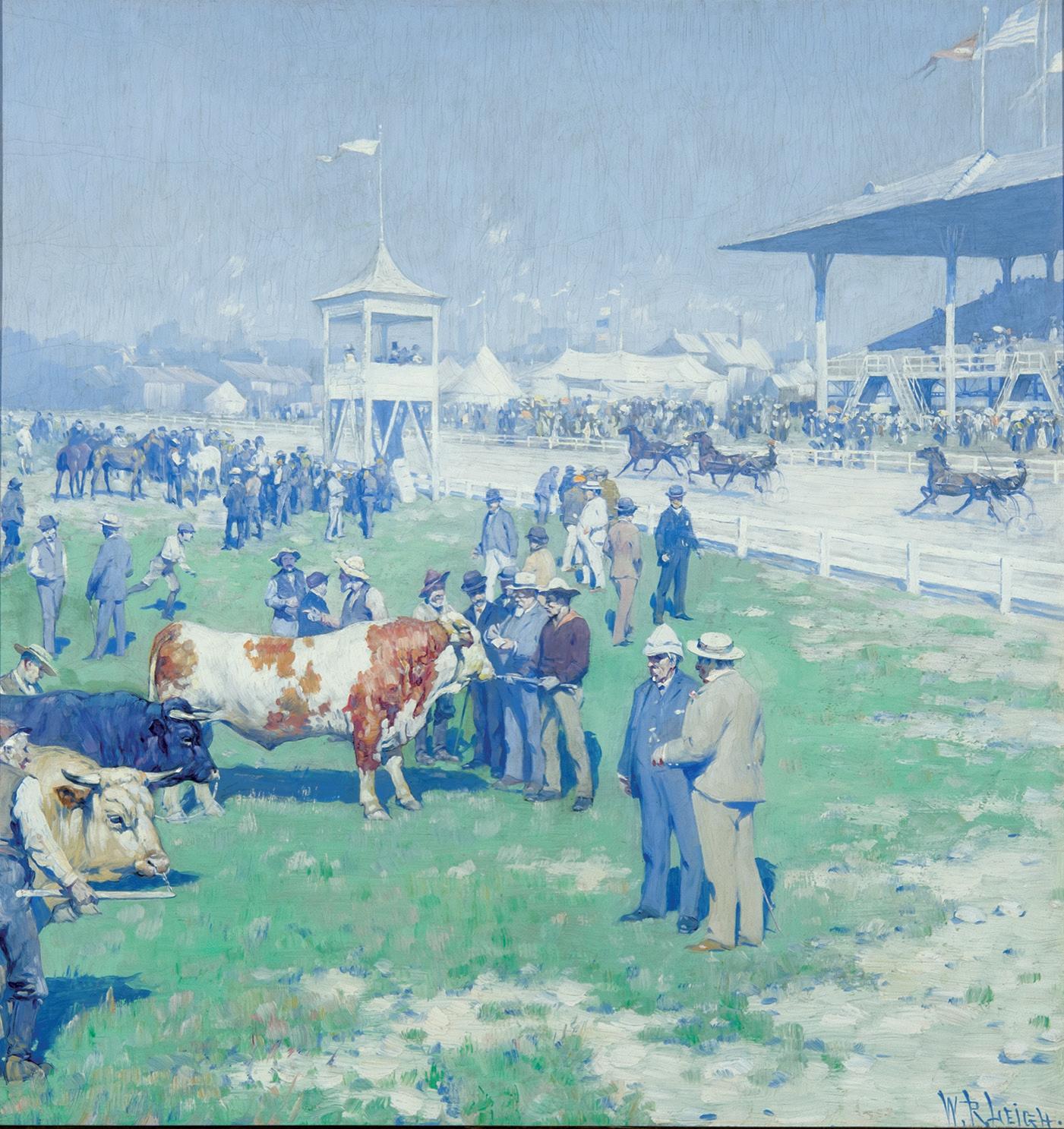
286
William R. Leigh 1866-1955
A Country Fair
Oil on paper, mounted on canvas 15 ½ x 15 inches
Signed lower right
Estimate: $10,000 - 15,000
SCOTTSDALE ART AUCTION 160
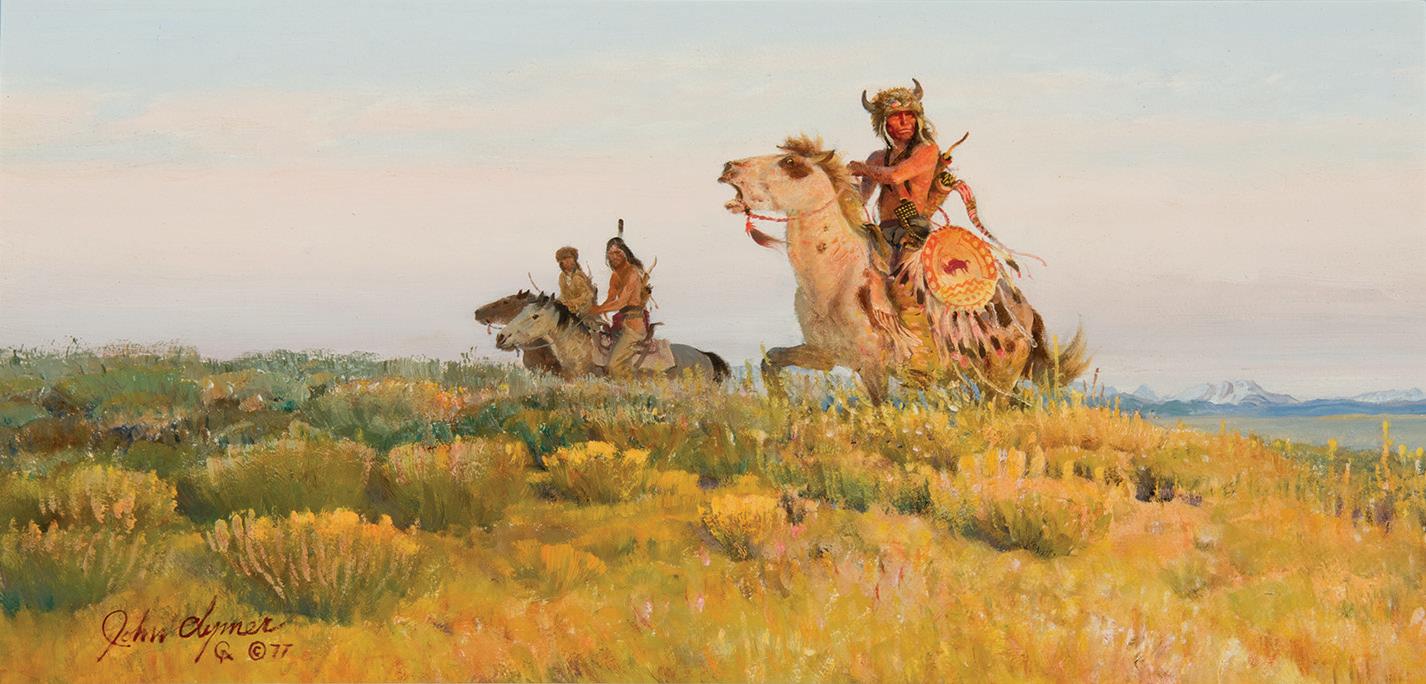
Buffalo Scouts
Oil on board
10 x 20 inches
Signed/CA and dated 77 lower left; Titled verso
Estimate: $50,000 - 75,000
161 SCOTTSDALE ART AUCTION
287
John Ford Clymer 1907-1989
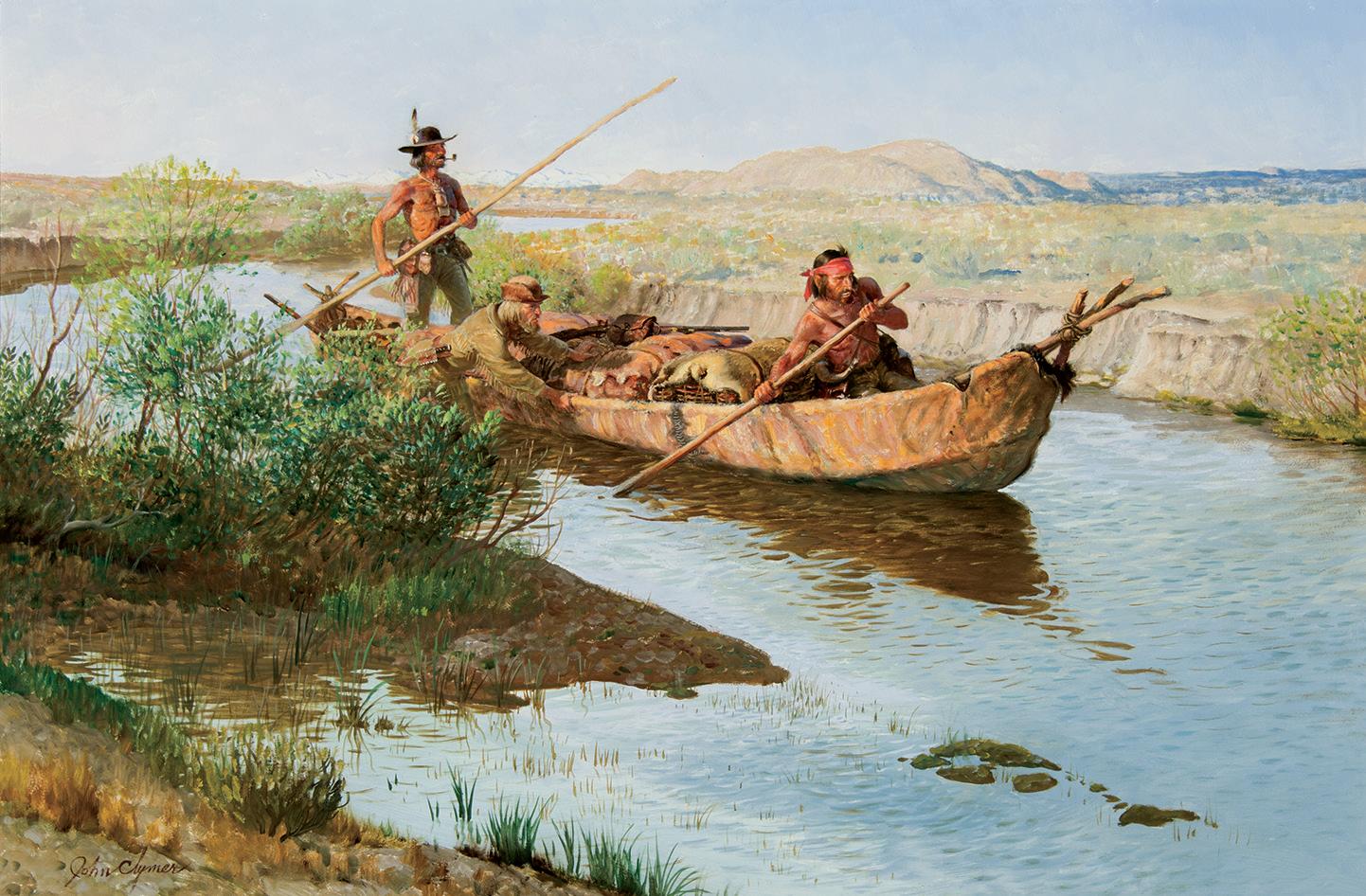
288
John Ford Clymer 1907-1989
Trading Down the Sweetwater
Oil on board
24 x 36 inches
Signed lower left;
Titled verso
Estimate: $90,000 - 120,000
Provenance:
Grand Central Art Galleries, New York, NY, August 1968
Private collection, Tulsa, OK, 1977
Rivers play a vital role in many of John Clymer’s greatest works. As a man of history and a voracious reader, Clymer saw the waterways of the frontier as the lifeblood of the American West prior to the arrival of the great railroads. Lewis & Clark, George Catlin, Karl Bodmer’s expedition with Prince Maximillian, traders in overloaded flat boats, fur trappers during the 1600s and 1700s—all had relied on rivers to navigate their way around the West. Trading Down the Sweetwater is a stunning example of his fascination with the rivers of the West. In this case, the Sweetwater River is a tributary of Wyoming’s North Platte River.
Clymer was also fond of the Missouri River, which played a significant role in establishing travel and trade in the West. In the summer of 1966, Clymer and his wife floated down the Missouri River on an outboard-powered, pontoon platform boat called The Chief. “It carried us for four days, 144 miles downriver, during which time we camped out at night and often stopped along the shore to explore,” Clymer wrote in John Clymer: An Artist’s Rendezvous with the Frontier West. “Our route passed through the white cliff area so vividly described by Lewis and Clark and other early and later-day travelers on the river. It was also the subject for several of Karl Bodmer’s paintings. Along this section of the river are old Indian campsites and buffalo jumps, Lewis and Clark campsites, sites of old forts and military posts, and well-known rapids and bars where early-day steamboat wrecks occurred. This section of the river winds through an area where great buffalo herds once roamed. In the days before the settlers there were also large numbers of deer, elk, prairie wolf, mountain sheep, antelope and the formidable grizzly bear described by Lewis and Clark. I was inspired to do a number of historical paintings based on our exploration of that area.”
SCOTTSDALE ART AUCTION 162

Estimate: $175,000 - 275,000
289
John Ford Clymer 1907-1989
Clearing the Palo Duro Oil on canvas 24 x 48 inches
Signed/CA and dated 1980 lower right; Signed, titled and dated Feb. 10, 1980 verso

289
John Ford Clymer 1907-1989
Clearing the Palo Duro (detail)
Oil on canvas
24 x 48 inches
Signed/CA and dated 1980 lower right; Signed, titled and dated Feb. 10, 1980 verso
Estimate: $175,000 - 275,000
Provenance:
Erivan & Helga Haub
Private collection, Texas
Literature:
Erivan and Helga Haub Family: Collection of Western Art, by Christine Mollring, published by Mollring Enterprises, Inc. Jackson, Wyoming, 2005, illustrated p.156
During a 20-year period starting in 1942, John Clymer painted more than 80 covers for one of the most popular publications of the first half of the 20th century, the Saturday Evening Post Although he couldn’t hold a candle to Norman Rockwell’s 322 covers for the Post, Clymer’s reputation as a master storyteller of the American experience was set in stone by the time he left the world of illustration in 1962. He immediately turned his attention to the American West, particularly historical scenes that he could bring to life through careful research and detailfocused depictions of early Americans. The interest in history was no accident; it materialized during a trip along the Oregon Trail. Clymer would drive and Doris, his wife, would read from a trail journal she had discovered several years earlier. As they made their way along the route, noting each major pioneer stop along the way, the West unfolded dramatically for the artist. A new world was open to him as stories began to come alive in his studio: trappers on the American frontier, flatboats delivering pelts and goods to a hunting camp or rendezvous, Native American warriors hunting from horseback, or epic scenes of cattle drives and cowboys.
In the 1980 painting Clearing the Palo Duro, Clymer painted the thunderous arrival of a herd of buffalo to the Palo Duro Valley, known by many as the Grand Canyon of Texas. The scene is filled with wildlife, but it tells a simple story: the buffalo are the unrivaled champions of the land. As the herd breaks through a small creek, critters of all shapes and sizes scatter away from the surging wall: mule and whitetail deer, a black bear, quail, wild turkey, ducks and a pair of wolves. Clymer’s images have cinematic qualities to them, including in their size and scope, but also due to the dramatic tension he creates with his lively and action-packed compositions. He finds ways to use the entire canvas to tell his stories, and Clearing the Palo Duro is no exception. The artist hides a clue as to the cause of the stampede in the far back left of the painting, amid the chaos of the dust and destruction. There, in hazy silhouette, is a human figure with a rifle raised high into the air.
“I think it is the accumulation of all these experiences, the research and the old stories, the trips on the old trails to actual places, the visits to history museums, large and small, that make it possible to do pictures that are real and believable and have the feeling of the place and the time,” Clymer wrote in John Clymer: An Artist’s Rendezvous with the Frontier West. “I have always tried in both wildlife paintings and historical paintings to take the viewer to an actual place and make him feel he was really there.”
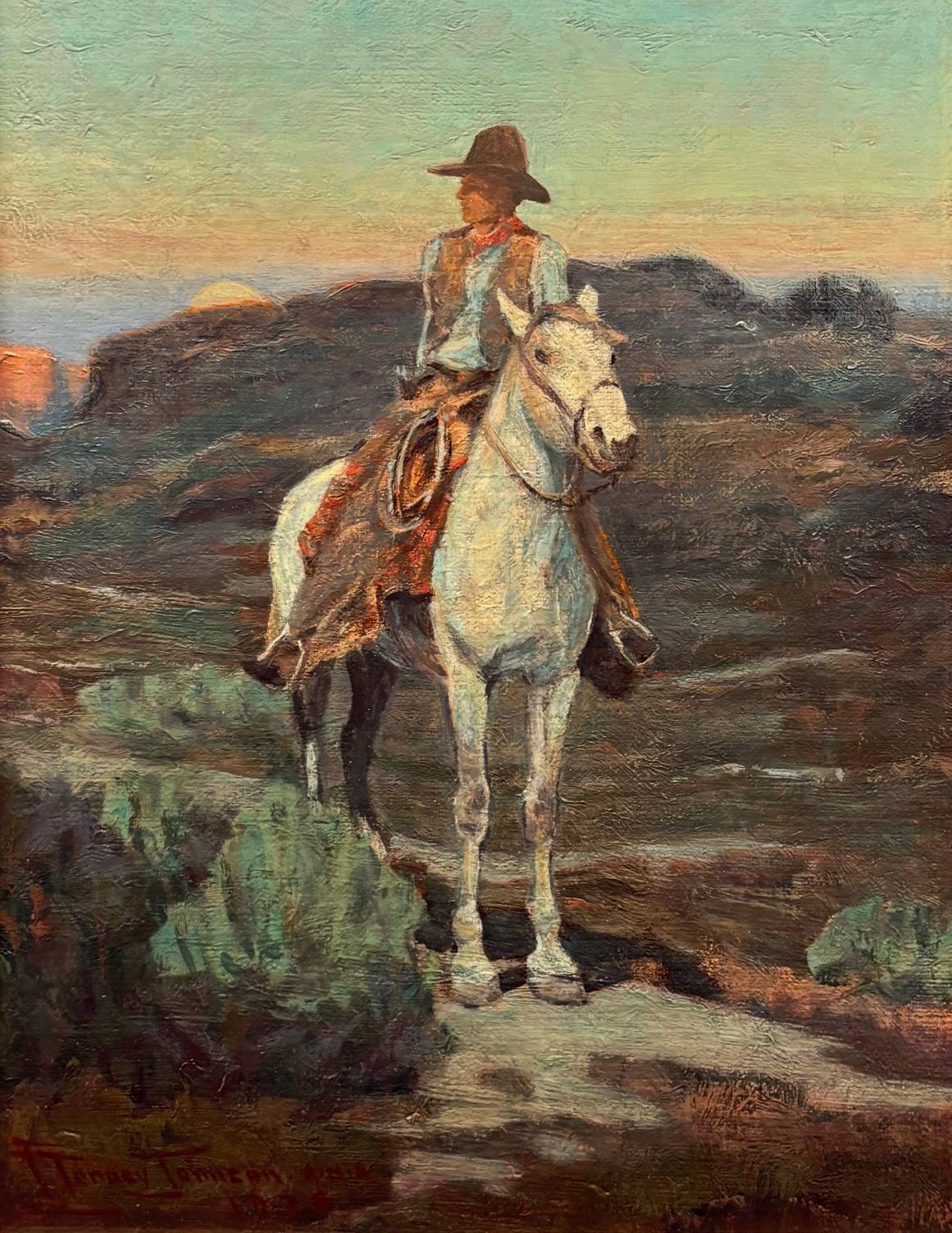
290
Frank Tenney Johnson 1874-1939
Moonrise Over Trail
Oil on board
14 x 11 inches
Signed and dated 1934 lower left; Titled verso
Estimate: $40,000 - 60,000
Provenance:
Edward Oakley Estate, Hacienda de Los Cerros, Santa Fe, NM, ca. late 1930s-1940s
Property of a gentleman, Sonoita, AZ
Master of the Western nocturne, Frank Tenney Johnson was also fond of the sub-category of moonrises, a subject that he sporadically painted dozens of times across his distinguished career. With works such as Moonrise Over the Mesa, Apaches at Moonrise, Coyote Moonrise and here in Moonrise Over the Trail, Johnson paints the arrival of the moon against the horizon as a spiritual moment for both man and beast. This tracks with his own history among Native American people, who almost universally view the moon as a sacred symbol in the sky. During a radio broadcast in 1925 at the Buffalo Bill Historical Center, a fan of his work told him, “[Y]our moonlights seem to me to possess the impalpable elusive mystery that moonlight has.” Years later, Johnson partially explained his fascination: “I like to think of moonlight as nature’s indirect lighting,” he told the Christian Science Monitor in 1931. “In the far West, where the air is clear, you can see all the essential structure of the rocks by moonlight, and a good deal of color detail in the foreground.”
SCOTTSDALE ART AUCTION 164 163 SCOTTSDALE ART AUCTION

Provenance:
Collection of Kathleen and Gerald Peters, Santa Fe, NM
Santa Fe Art Auction, Santa Fe, NM, 2016
Private collection, Texas
291
Edward Borein 1872-1945
Navajos at the Watering Hole
Pen & ink on paper
23 x 19 inches
Signed and dated 11’ lower right
Estimate: $65,000 - 85,000
Edward Borein was one of the earliest Western artists originating from the West. The painter and printmaker, born in 1872, saw the West’s rapid growth firsthand from the cow town of San Leandro in the Bay Area. He started sketching cowboys at the tender age of 5 years old. When he was 17, he became a working cowboy in California and the Southwest, but also in Mexico and Guatemala. He later continued his art education in both San Francisco and New York City, he met Maynard Dixon and Charlie Russell, and he became enthralled in the process of etchings and printmaking. After a successful career in illustration and many years on the move to places that appealed to him, Borein settled in Santa Barbara, California, in his 50s. There he worked relentlessly until his death in 1945.
Borein’s legacy is one of authentic depictions of the West, but also one of exploration with materials and media. He was highly proficient in oil and watercolor, as well as pen and ink and graphite drawing, and his etchings are some of the finest in the West. This drawing, Navajos at the Watering Hole, should thrill collectors because it shares a subject and composition with a popular Borein etching, Navajos at the Water Hole, editions of which are prized by collectors. The etching is set at night, but this work in pen and ink is set in daytime conditions. Both works share the four figures on horseback and general composition, although the drawing has more detail in the faces, the wearing blankets around each rider and in the lineup of horses at the water’s edge.
SCOTTSDALE ART AUCTION 165
292
Winold Reiss 1886-1953
Indian Madonna
Mixed Media on paper
29 x 21 inches
Signed lower right
Estimate: $25,000 - 35,000
Provenance:
Long Champs Restaurant, Madison Ave., New York City, NY.
J.N. Bartfield Galleries, NY
Private collection, Wyoming

It’s hard to put Winold Reiss in just one box when he fits in so many. To the Western world, he was a modernist painter whose portraits of Native American subjects are considered some of the finest in the genre, on par with those of Nicolai Fechin and Robert Henri. To others, he was a critically acclaimed muralist, whose public works, including those at the Cincinnati Union Terminal, are still celebrated today. Another aspect of his career, one less talked about, is Reiss’ architectural work and interior design. Much of it started immediately after he landed in New York City from Europe in 1913. So vast is this portion of his career that in The Multicultural Modernism of Winold Reiss, 1886-1953, C. Ford Peatross and Renate Reiss, the artist’s daughter-in-law, list hundreds of restaurants, hotels, lounges and ballrooms where the artist contributed design work, everything from paintings and murals to stairways and lighting fixtures.
Indian Madonna, which hung in the Longchamps restaurant on Madison Avenue in New York City for 20 years, intersects with this portion of Reiss’ career. The artist had been going to Montana and Alberta, Canada, to paint Native American portraits beginning in 1919. Later, in 1928, he was commissioned to paint similar portraits for the Great Northern Railway. As word got out about these stunning images, Reiss paintings were suddenly in high demand in New York City. Dozens of these Native American portraits ended up in Longchamps, the Art Deco restaurant chain that started in 1919. Peatross and Renate Reiss first pin the Longchamps commissions in 1935, with additional restaurants through the mid-1940s. Longchamps had restaurants all over Manhattan (and in Washington, D.C.), each with its own Reiss theme, including “Louis XIV” and “Swiss and abstract modern.” A Mexican theme decorated the inside of the restaurant at Fifth Avenue and 34th Street, inside the Empire State Building. The Native American-themed restaurant was on Madison Avenue and 59th Street. The chain closed in the 1970s, but Reiss’ designs and architectural additions are still being discovered today.
SCOTTSDALE ART AUCTION 166
293
Winold Reiss 1886-1953
Blackfoot Maiden
Mixed Media on paper
29 ½ x 21 ¼ inches
Signed lower left
Estimate: $25,000 - 35,000

Provenance:
Midwestern Gallery, Cincinatti, OH
Private collection, New York ca. 1980
Beginning in 1919 and continuing until 1948, German painter Winold Reiss made routine trips to the Blackfeet in Montana and the Bloods in Alberta, Canada. He had made the long journey from Europe to the United States specifically to see Native Americans, whose romantic depictions in James Fenimore Cooper novels had thrilled him while he was studying art in Munich. When he arrived in New York City in 1913, he was surprised to learn that American Indians weren’t greeting visitors at the pier. Broke and hungry for opportunities, Reiss stuck around New York City until he had the funds to tour the West. He used the pause in his adventure to his advantage: by the time 1919 rolled around, Reiss had established himself as a portrait artist, muralist, art teacher and interior designer. Not only was he in a better place in his career, but he was also a better artist. The work he made in Montana was groundbreaking and modern.
“Western artists created mementos of a vanishing frontier. Their work was to encapsulate the exceptionalism of the Western experience, an often-romanticized view that was increasingly difficult to find. According to historian Frederic Jackson Turner, the West was settled by Euro-Americans including many newcomers. We can imagine Winold Reiss as an immigrant for whom the frontier myths and the Native Americans were a resource to shed his European identity and become an American,” writes Jochen Wierich in The Multicultural Modernism of Winold Reiss, 1886-1953. “However, his images of Native Americans did not reiterate the tragic hero narrative that pervaded so much of Western art. Reiss almost returns to the ethnographic beginnings of the genre but with a modernist eye for color and design. Unlike [George] Catlin, who defined his own role as a historian, Reiss was more comfortable with the artifice of his craft.”
SCOTTSDALE ART AUCTION 167

294
Kathryn Woodman Leighton 1875-1952 Indian with Turquoise Earrings Portrait Oil on canvas
36 x 28 inches
Signed lower right; Signed verso
Estimate: $18,000 - 28,000
Provenance:
Olaf Wieghorst Roy Wieghorst by decent in the family
Two subjects would captivate the attention of Kathryn Woodman Leighton throughout much of her career: Glacier National Park and Native American portraits, of which she did hundreds, if not thousands. In 1910, after living on the East Coast, Leighton and her husband moved to Los Angeles, where she dove headfirst into the art world. A party at painter Jack Wilkinson Smith’s house is where she was introduced to Charles M. Russell, who would become a friend and colleague. Leighton and her husband would later join Charlie and Nancy Russell at the Bull Head Lodge on Lake McDonald in Glacier National Park. In 1926, Russell introduced Leighton to Blackfeet Indians in Montana, which helped pave the way for many of her greatest portraits.
SCOTTSDALE ART AUCTION 168
295
Henry Balink 1882-1963
Portrait of Chief Bacon Rind
Oil on canvas
46 x 32 inches
Signed lower right
Estimate: $25,000 - 35,000
Provenance:
Private collection, Santa Fe, NM, ca. 1965
Private collection, Littleton, CO, 2018

This exceptional portrait by Taos painter Henry C. Balink likely originated around 1927, when the artist was documenting Native Americans. Although not mentioned by name, the painting is noted in an article in the August 1927 edition of The Art Digest. “Henry C. Balink, member of the Taos colony of artists, native of Amsterdam and modern follower of the [Hans] Holbein tradition, is painting a series of portraits of the most prominent Indians of Oklahoma for the museum to be established at Ponca City, [Oklahoma,] by E.W. Marland, oil magnate,” the article reads. “Thus far he has painted Blue Hair, Atoe chief; Bacon Rind, Osage chief; and Horse Chief Eagle, of the Poncas.” At least one of the Balink portraits, Chief Blue Hair, is in the Smithsonian’s collection at the National Portrait Gallery.
As for Balink’s sitter, Chief Bacon Rind is thought to be one of the most photographed American Indian leaders of his era. The Osage chief, known as Wah-she-hah (Star-That-Travels), came to Oklahoma during the removal of the Osage people from Kansas in the 1870s. “Bacon Rind was politically progressive and favored the allotment of the Osage Reservation and the development of its oil and natural gas resources,” notes the Oklahoma Historical Society. “He remained a traditionalist in customs, however, and always wore native dress and an otter-skin cap. Bacon Rind was a gifted speaker of the Osage language. He spent the last quarter century of his life representing the Osage on annual visits to Washington, D.C.”
SCOTTSDALE ART AUCTION 169

296
Bert G. Phillips 1868-1956
The War Captain Rides
Oil on board
20 x 24 inches
Signed lower left;
Signed and titled verso
Estimate: $35,000 - 50,000
Provenance:
Private collection, Scottsdale, AZ
Literature:
Bert Greer Phillips and the Taos Art Colony, by Julie Schimmel & Robert R. White, Published by the University of New Mexico Press, Albuquerque, NM, 1994; mentioned on p. 270
The War Captain Rides, which is occasionally lengthened to The War Captain Rides on a Moonlight Night in October, was originally sold for $500 after it was created in 1954-55, toward the end of the artist’s life. The image is listed in the comprehensive catalog of known works in Bert Geer Phillips and the Taos Art Colony. The 1994 book also lists three unnamed exhibitions where the work was shown in Roy, Deming and Gallup, New Mexico.
Phillips rode into Western art history when he and Ernest L. Blumenschein, tenderfeet from the big city, purchased a wagon and a pair of horses in Denver in 1898. They were so inexperienced they had to carefully watch the man who sold them the horses hitch the team to the wagon so they could duplicate the process on their own. Four months later, the pair of artists rode into Northern New Mexico, where the wagon fell into a rut and broke a wheel. Phillips stayed with the wagon and Blumenschein rode into nearby Taos, where the wheel could be mended. Although Joseph Henry Sharp had visited Taos in 1893, the “wagon incident” would essentially mark the beginning of the Taos Art Colony. Phillips, it should be noted, was smitten immediately by Taos, and was the only artist to move there permanently from the moment he laid eyes on it. He was also instrumental in bringing some of the artists out and in organizing the Taos Society of Artists.
297
Bert G. Phillips 1868-1956
Taos Valley
Oil on board
8 x 10 inches
Signed lower left
Estimate: $4,000 - 6,000

SCOTTSDALE ART AUCTION 170

New
Oil on canvas mounted to board
7 ½ x 9 ½ inches
Signed lower left;
Signed and dated 1903 verso
Estimate: $7,000 - 11,000
Oil
24 x 28 ½ inches
Signed lower left; Certificate of Authenticity verso
Estimate: $20,000 - 30,000
Provenance:
Private collection, Scottsdale, AZ

SCOTTSDALE ART AUCTION 171
298
Eanger Irving Couse 1866-1936
Mexico Pueblo Walpapi
299
Eanger Irving Couse 1866-1936
French Fishing Scene
on board

300
William R. Leigh 1866-1955
Pack Trip (Rough Going)
Oil on canvas
22 x 30 inches
Signed and dated 1943 lower left
Estimate: $250,000 - 450,000
Provenance:
Private collection, Indiana
Literature:
W.R. Leigh: The Definitive Illustrated Biography, June DuBois, The Lowell Press, Kansas City, MO, 1977: illustrated p. 158 (using the title Rough Going).
When William R. Leigh landed in Western art, no one quite like him had been seen before, or since. His work was wholly unique, with sumptuous color, compositions held together with flailing hooves and hands twisted within dusty clouds, and exaggerated human and animal figures that defied realism ever so slightly to create a heightened emotional sense. As he rose within the art world, there was even serious discussion as to what his work should be called. Critics were stumped: Illustration? Romantic realism? Impressionism? When Leigh was asked to weigh in, he wrote in a letter: “I like to think of myself as a conscientious artist.” In an article titled “This Rembrandt Lived in Tepees to Paint Canvas Sagas of Wild West,” one reviewer from the New York World Telegram offered insight: “As the…pictorial spokesman for the land of chaps and chaparral he has been dubbed the ‘Sagebrush Rembrandt’…Of special delight to Mr. Leigh is that he has a constant audience from old-timers to youngsters all united by a common bond, the lure of the West that is sometimes wild and woolly.”
These qualities are on full view in Pack Trip, which uses the title Rough Going in June Dubois’ 1977 book W.R. Leigh: The Definitive Illustrated Biography. Regarding the work, which shows a hunter making his way up a risky cliffside path, Leigh wrote in his unpublished memoirs, “When a man is out to get bighorn sheep, he has got to get first of all to the places where these animals are. The means to the open country above timber, and it takes knowledge, sure feet and good lungs to do that.”
SCOTTSDALE ART AUCTION 172

Norman Rockwell 1894-1978
Bucking Bronco
Oil on canvas
27 x 20 inches
Signed lower right
Estimate: $60,000 - 90,000
Provenance: Scottsdale Art Auction, Scottsdale, AZ, 2018
Originally made for Ralph Graham Taber’s novel Chained Lightning: A Story of Adventure in Mexico, Norman Rockwell’s Bucking Bronco shows the book’s main character, Maurice Belville, holding tightly to a kicking horse. Taber describes what happens next: “Three times that gentle mustang bucked, and Belville felt that his ears were bursting. Then Luis plunged his spurs in deep and that mustang started. There was no stopping him then…Somehow they managed to keep on the animal’s back, but how they could never satisfactorily explain to each other.” This early work from 1915 helped land Rockwell at the Saturday Evening Post in 1916.
SCOTTSDALE ART AUCTION 173
301

302
George Henry Durrie 1820-1863
Twelve Miles To Goshen
Oil on canvas
18 x 24 inches
Signed and dated Jan 1858 lower right
Estimate: $100,000 - 150,000
Provenance:
Private collection, Indiana
George Henry Durrie spent all 43 years of his life in Connecticut, which is where Twelve Miles to Goshen takes place. Goshen is a small village 35 miles from Hartford, Connecticut. Dated 1858, the work is an early American scene that highlights the beauty of the winter landscape, a style of painting that Durrie helped make popular in the mid-19th century. Durrie drew inspiration from the Hudson River School painters, but later added his own twist to the landscape genre when he included the snowy and icy conditions that were common during the winter months in Connecticut. Not only were the works a success, Durrie helped pioneer the genre of winter scenes. While his paintings were dismissed by art critics and curators, they were quite successful with collectors, including many who sought out commissions from the artist. Today his works are noteworthy for their quaint visions of small-town life during a time of year that is captured far less by other artists of the period.
“Almost all of his compositions are relatively small in scale, few exceeding 18 by 24 inches, and his views are quiet and intimate. He knew and admired the works of Thomas Cole, and may have tried to emulate certain aspects of Cole’s style, yet he eschewed the Hudson River School’s compositional complexity and expansiveness,” the National Gallery of Art notes. “Because his paintings combined extensive genre elements with landscape they had a story-telling content that made them pleasant, accessible images to the average viewer. The lithographic firm of Currier & Ives successfully reproduced 10 of Durrie’s scenes and these, in turn, became popular calendar illustrations in the 20th century. As a result, Durrie’s depictions of rural life in the mid-19th century are now among the most familiar images in all of American art…[H]owever, these printed pictures do not convey the keen sensitivity to and understanding of conditions of atmosphere and light that are so pronounced in Durrie’s paintings.”
SCOTTSDALE ART AUCTION 174

303
Clark Hulings 1922-2011
Red Door - San Miguel Allende
Oil on board
19 x 29 inches
Signed lower right
Estimate: $35,000 - 50,000
Provenance:
Olaf Wieghorst Roy Wieghorst by decent in the family
Often considered a sign of sanctuary and protection, a red door marks the center of Clark Hulings’ painting Red Door Born in Florida and raised in New Jersey, Hulings often spent more time in Europe than in America. His subjects would include architecture, people and open-air markets in places such as Italy, France, Spain, Mexico, Turkey and in the American Southwest.
SCOTTSDALE ART AUCTION 175

Provenance:
Christie’s, Los Angeles, CA, 2001
Private collection, Idaho
304
Walter Ufer 1876-1936
A Singer
Oil on canvas
10 ¾ x 12 ¼ inches
Signed upper right;
Titled and signed verso
Estimate: $50,000 - 75,000
Like all the Taos Society of Artists members, Walter Ufer alternated fairly frequently between outdoor paintings with multiple subjects and more intimate indoor scenes with a single figure. Many of Ufer’s single figures are often holding drums or other instruments, as is the case here for A Singer. In Taos: A Painter’s Dream, Patricia Janis Broder writes, “Walter Ufer was both romantic poet and social critic, and his Taos paintings express his basic philosophy and outlook on life. He loved the beauty of the natural world and valued all forms of artistic creation. Above all, he was a humanitarian, a believer in the dignity and basic rights of the individual.”
SCOTTSDALE ART AUCTION 176

305
Leon Gaspard 1882-1964
Portrait of a Young Girl (Urga, 1922)
Oil on canvas mounted to board
11 x 11 inches
Signed and dated 1922 lower left
Estimate: $25,000 - 35,000
Provenance:
Private collection, Nevada
Private collection, Texas
Painted in 1922, Portrait of a Young Girl originates from Gaspard’s travels to Mongolia and eastern China in 1921. This transatlantic voyage, one of three major journeys made to Asia, proved incredibly valuable to the artist, who would paint the people and customs he witnessed during adventures to far-off lands. Notably, the 1921 trip came at an important time for the painter: It was one year after Gaspard and his wife first visited Taos, New Mexico, and three years before they made Taos their permanent home. The artist, who flew planes in World War I, was shot down and injured seriously. It was those wounds that led him to Northern New Mexico and its dry climate.
306
William H. Dunton 1878-1936
Night Pueblo
Oil on board
8 x 10 inches
Signed lower right
Estimate: $40,000 - 60,000

Of the six founders of the Taos Society of Artists, William Herbert “Buck” Dunton was the last to arrive in Taos, New Mexico. He would also be the first to die, and he was also the youngest at the time of his death at just 57 years old. And yet, in a shorter period of time, Dunton put his stamp on the West through his remarkable work. He also dearly loved Taos. In 1922, he wrote: “And when we speak of Taos it is not alone the cluster of grey, adobe buildings that crest the hill and constitute the town, but of the undulating swells of the sagebrush valley as well; the tiny Mexican settlements that dot the cottonwood fringed rivers; the skies of marvelous blue through which pass, in summer, regiments of stately clouds; the majesty of the mountains—those serrated, rugged peaks to the east and north and the gentler tone of the remoter ranges low lying in the west.”
177 SCOTTSDALE ART AUCTION

Provenance:
Private collection, California
Private collection, Wisconsin
Literature:
307
Charles M. Russell 1864-1926
A Bronc Twister
Bronze, signed/CM Russell with Skull
Height: 17 ¾ inches
Calif. Art Bronze FDRY L.A.
Estimate: $200,000 - 300,000
Charles M. Russell: The Artist in His Hayday, Gerald Peters Gallery, published by the Peters Corporation, 1995; illustrated p. 118-119
In Patricia Janis Broder’s monumental book Bronzes of the American West, she compares Frederic Remington’s The Broncho Buster to A Bronc Twister, arguably Charles M. Russell’s most iconic bronze sculpture. “In Remington’s sculpture, the cowboy is the conquering hero, whereas in Russell’s, the horse is the object of admiration.” She uses a 1916 letter from Russell, full of language not used today, to illustrate this point: “An Injun once told me that bravery came from the hart not the head. If my red brother is right Bronk riders and bull dogers are all hart above the wast band but its a good bet theres nothing under there hat but hair.”
When the Met exhibited Western bronzes in late 2013, comparisons between The Broncho Buster and A Bronc Twister (originally called The Weaver) again resurfaced, this time from Western scholar Peter Hassrick, who wrote that Russell’s bronze was “in a sense…a statement of dissent” against Remington’s work. “Though not cast until two years after Remington’s death in 1909, [A Bronc Twister] had in fact been inspired in 1904, during Russell’s first visit to New York. At that time he painted a remarkably true-to-life watercolor, A Bad Hoss, that was illustrated in Scribner’s with the subtitle, ‘A cowboy riding a horse known as a weaver.’ It was probably watercolors such as this that empowered Western historian Emerson Hough in 1908 and Texas photographer Erwin Smith in 1909 to favor Russell over Remington and attack the latter as a charlatan. Hough accused Remington of having spawned a whole class of Eastern artists who knew nothing about the West, while Smith lambasted The Broncho Buster as ill-informed and incorrectly posed,” Hassrick wrote in The American West in Bronze. “Russell, in contrast, was lauded as the only artist who, in works like A Bad Hoss, had ‘truthfully caught the cowboy and painted him in action as he is.’ Now, with A Bronc Twister, it was Russell’s turn to portray the bronco buster as faithfully in bronze as he had in paint. The result was a masterpiece in animal motion and a thoroughly three-dimensional work.”
SCOTTSDALE ART AUCTION 178
308
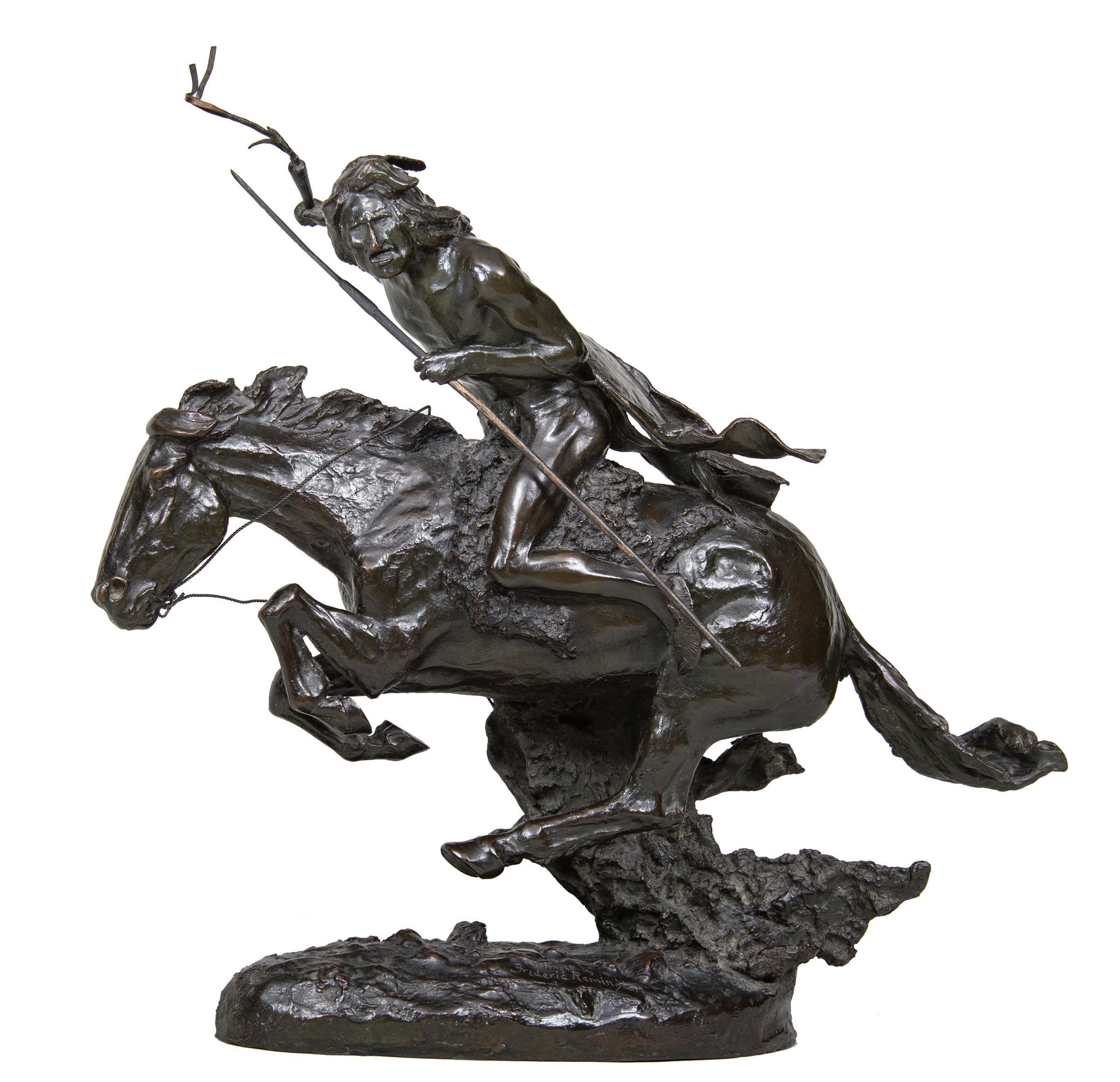
Frederic Remington 1861-1909
The Cheyenne
Bronze, signed
Cast N-25 beneath base
Height: 19 ¾ inches
Roman Bronze Works N-Y-
Estimate: $100,000 - 150,000
One of the greatest American works in bronze ever created is Frederic Remington’s The Broncho Buster. It was his first bronze. Number six was The Cheyenne, which would be followed a year later by another iconic sculpture, Coming Through the Rye. To call these simply great works of art is an understatement—they are timeless. For The Cheyenne, sculpted in 1901 and cast by Roman Bronze Works using the lost-wax casting method, Remington created a heroic image of a Native American on horseback. “…Frederic Remington’s Cheyenne…presents a historical image of a highly visible defiant warrior on a pony, a sculpture that Remington described as ‘burning the air.’ His patrons admired the statuette’s tour de force modeling, the extraordinary casting in which a draped bison robe supports the flying horse, and the patination and chasing that animate the tactile surface,” writes Carol Clark in The American West in Bronze, the catalog for the hit exhibition at the Met in 2013. “The animal moves as swiftly and as confidently as its rider, who tilts forward at the waist, gripping his mount with muscular buttocks, thighs and calves. Mouth open in a cry that distorts his face, one hand holding a lance, the other clenching a quirt, with a shield on his back and knife at his waist, the man exudes power. But against whom does he ride into battle—enemies from another tribe or soldiers of the U.S. Army? Whoever the foe, by the time Remington’s sculpture was made in 1901, it presented a vision of the past.”
179 SCOTTSDALE ART AUCTION
309
Charles M. Russell 1864-1926
The Broken Rope
Oil on canvas
24 ⅛ x 36 ¼ inches
Signed and dated 1904 lower left with skull
Estimate: $5,000,000 - 7,000,000
Known as the Cowboy Artist, Charles M. Russell earned that nickname through grit and determination from 1882 to 1893, during which time he worked as a cowboy in Montana’s Judith Basin and later in Missouri. It was during a stint riding for the N Bar N brand when Russell received an important early commission that lured him away from cowboying—and his specialty, night herding—to become a professional artist. By then, the nickname of the Cowboy Artist had stuck.
That 11-year period of riding and roping on horseback is what makes Russell’s work so authentic to the Western canon. Having experienced it firsthand, he understood how cowboys operated: where they put their hands and their feet, how they moved and carried themselves, how the horses would react to cattle and different kinds of terrain, and what scenarios were most risky to a cowboy. In the oil painting The Broken Rope, completed in 1904, Russell captured the danger and drama of being a cowboy like only a real cowpuncher could. Showing a collision between cow and cowboy, the 24-by-36-inch work was produced during one of the most active and important periods of the artist’s career. The painting is considered one of Russell’s masterworks, with an exhibition history to prove it. In an essay titled “Poetry and Motion in the Art of Charles M. Russell” in The Masterworks of Charles M. Russell: A Retrospective of Paintings and Sculpture, Joan Carpenter Troccoli, identifies the work as an important milestone in the artist’s career: “The Broken Rope represents one of Russell’s notable periodic advances in technical skill and confidence…”
The painting is likely a loose continuation of events that appear in earlier paintings Mad Cow and When Cowboys Get in Trouble (The Mad Cow), both of which show a charging cow but with all riders still in their saddles. The “mad cow” part of Broken Rope is likely a reference to something Russell saw during his cowboy days: when a mother cow would lose its calf, either to wolves or natural causes, it would go “mad” without a calf to relieve the pressure of milk in its udders. These animals would often charge and create problems for the cattle wranglers. Broken Rope tells a similar story, but the composition is unique to the other “mad cow” paintings, which might be the result of his visit to New York City earlier in 1904. During that fateful trip, Russell would inquire with John Marchand and other accomplished artists about creating more dynamic compositions. It’s possible they gave him some tips that manifested in this painting, including the arroyo that funnels the eyes of the viewer into the action and the still-falling hat that shows the action in the scene is still unresolved. Another little detail in the work is the rider’s worn-out and patched pants, which hint at Russell’s Blackfeet nickname, Ah-Wa-Cous. The artist was prone to wearing patched pants, which was noticed by his Indian friends, who began to call him the Blackfeet word for antelope, due to the light patch of cloth on his hindquarters.
The image appears in Frederic G. Renner’s 1976 book on the artist, titled simply Charles M. Russell. “Many authorities feel that Russell’s greatest work was done between 1902 and 1916, the period of this fine action painting. At this time the artist was painting the scenes that he loved best and that delighted his most critical audience, his cowboy friends. To them, every detail in the painting, from the brand on the horse to the ring in the tail of the angry cow, helped tell the story. If they couldn’t name the cowboy to the right they could spot him for a Texan from his tapaderos. These stirrup coverings of heavy cowhide were used to protect the rider's feet in the southern brush country, but were not used by Montana cowboys in the early days. The angora chaps, which the cowboys called ‘woolies’ were strictly ‘Montana,’ however. These were a real comfort in the winter or during the crisp days of the fall roundup,” Renner writes. “Russell’s admirers have always claimed ‘he was the only artist who could paint a horse with all four feet in the air and make’im look natural,’ a point well demonstrated in The Broken Rope.”
SCOTTSDALE ART AUCTION 180

24 ⅛ x 36 ¼ inches
Signed and dated 1904 lower left with skull
Estimate: $5,000,000 - 7,000,000
309
Charles M. Russell 1864-1926
The Broken Rope
Oil on canvas
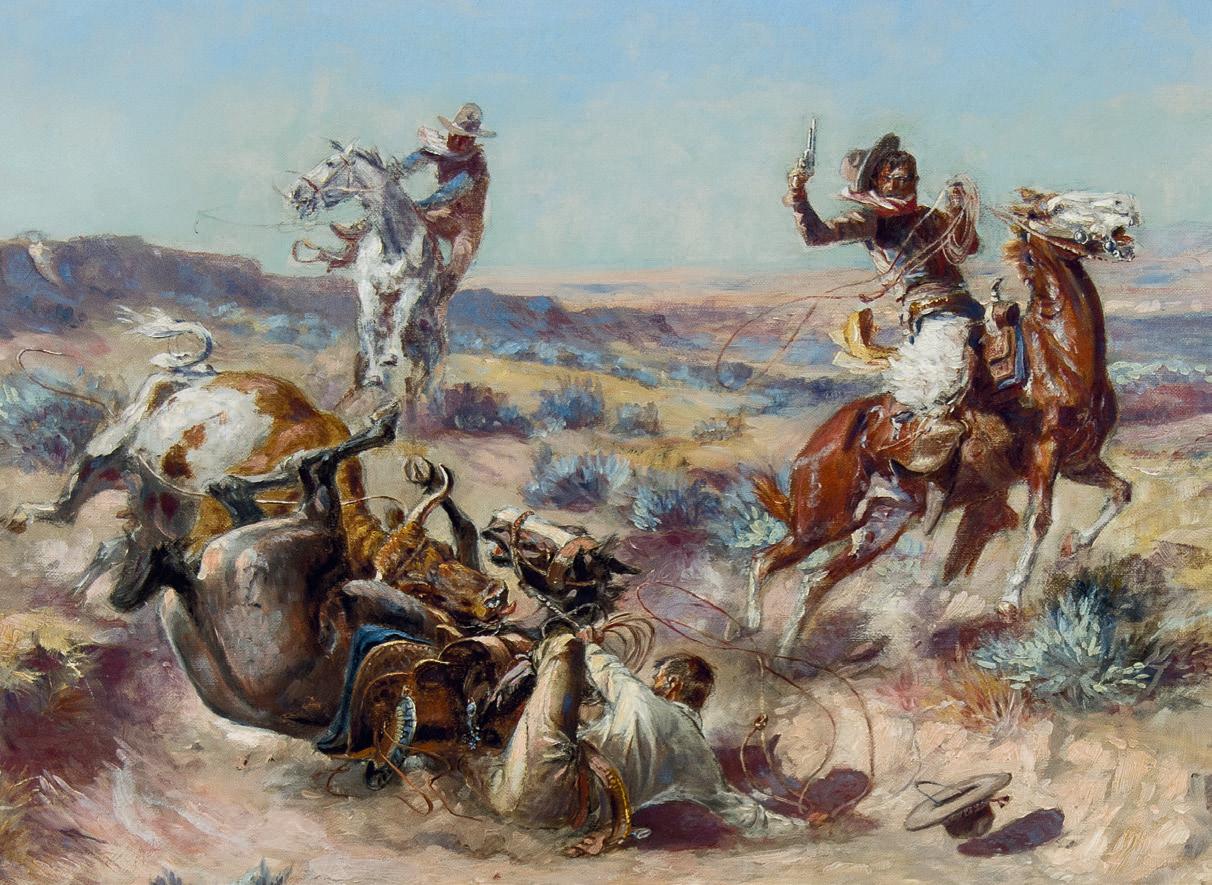
309
Charles M. Russell 1864-1926
The Broken Rope (detail)
Provenance:
The artist
Collection of Benjamin B. Thayer, Anaconda, MT, ca. 1904
David B. Findlay Galleries, New York, NY, 1950
Amon Carter Museum of American Art, Fort Worth, TX, 1950
Geral Peters Gallery, Santa Fe, NM
Private collection, Colorado ca. 1999
Literature:
Charles M. Russell Frederic G. Renner, Harry N. Abrams Inc. / Amon Carter Museum of Western Art, Fort Worth, TX, 1976: p. 109.
The Masterworks of Charles M. Russell: A Retrospective of Paintings and Sculpture, Joan Carpenter Troccoli, University of Oklahoma Press, Norman, OK, 2009: p. 26.
The American Cowboy Lonn Taylor and Ingrid Marr, Library of Congress, Washington, D.C., 1983: p. 104.
The Book of Horses Fred Urquhart, Secker and Warburg, England; William Morrow & Company, New York, NY, 1981.
The Cowboy Buffalo Bill Historical Center, Cody, WY, May 1-September 30, 1975
Masters of Western Art, Angelo State University, San Angelo, TX, June 16-29, 1977
Western Heritage Art Fair, Littleton, CO, August 5-7, 1977
Charles Russell Exhibition, Colorado Springs Fine Arts Center, Colorado Springs, CO, June-August 1980
The American Cowboy Library of Congress, Washington, D.C., January 15-December 15, 1983
C.M. Russell: Artist of the American West Museum of Our National Heritage, Lexington, MA, April-October, 1984
Charles M. Russell: Paintings, Drawings and Sculpture Amon Carter Museum of American Art, Fort Worth, TX, January 11-March 10, 1985
To be included in a forthcoming book entitled Following Russell Trails
Exhibited:
Fort Worth Art Association Gallery, Fort Worth, TX, 1950
Days on the Range: Artists of the American West, Houston Museum of Fine Arts, Houston, TX, February 3-March 5, 1972
Cowboys, Indians, Trappers and Traders, Amherst College, Mead Art Building, Amherst, MA, February 1-28, 1973

310
Charles M. Russell 1864-1926
The Milk Creek Canyon Disaste[r]
Oil on board
18 x 24 inches
Signed and titled lower right
Estimate: $75,000 - 125,000
Provenance: Private collection, Oklahoma
Exhibited:
Borderlands: Images of the American West Fred Jones Jr. Museum of Art, Norman, OK, 2009 National Cowboy & Western Heritage Museum, Oklahoma City, OK, 2016-2017 Montana Historical Society, Helena, MT, 2018-2019
This exceptionally early Charles M. Russell painting depicts the Milk Creek Battle, which is often paired with a separate event linked to it, the Meeker Massacre. Both events took place in September 1879, when U.S. Army forces left Fort Steele in Wyoming to investigate a possible uprising against federal agent Nathan Meeker, who was appointed to oversee the White River Indian Agency in Colorado. During the Army’s march into Colorado, commanding officer Major Thomas Thornburgh ignored previous orders to not cross south of Milk Creek with his entire force, which angered Ute chiefs Jack (Nicaagat) and Colorow. On September 29, heavy Ute forces simultaneously descended on Thornburgh’s soldiers and on the White River Agency 25 miles to the south. It wasn’t until October 5 that reinforcements arrived to push the Ute fighters back. By the end of the battle, two dozen soldiers were dead, including Thornburgh and Meeker. More than 20 Ute fighters were thought to have died in the skirmish.
As word of the battle spread, newspapers and magazines were quick to dramatize the events that happened on the banks of Milk Creek. One publication that wrote about the battle was the National Police Gazette, which printed a story about the deadly skirmish on October 18, 1879. Included in the coverage was an unsigned wood engraving of a Native American fighter shooting Major Thornburgh off his horse. Due to the many similarities of the newspaper illustration and Russell’s painting, it’s fair to say that Russell was likely inspired by the engraving during the creation of his work, which was executed possibly as early as the fall of 1879, when he was only 15 years old. The painting is also likely one of the earliest attributable Western paintings known to exist from the artist. The undated work is listed in the catalogue raisonné as The Milk Creek Canyon Disaste[r], though it is sometimes titled as The Milk Creek Canyon Desaste Death of Magor Thornburgh.
SCOTTSDALE ART AUCTION 182
181 SCOTTSDALE ART AUCTION
311
Olaf Wieghorst 1899-1988
Sioux Warrior
Oil on board 10 x 8 inches
Signed lower left; Titled verso
Estimate: $15,000 - 25,000
With a history that reads like the most improbable epic ever assembled—child acrobat, sailor, New York City mounted police officer, cavalry rider, cowboy artist—Olaf Wieghorst had one thread that ran through his whole life: horses. He famously told friends he could draw equine subjects without photos or life models. He was also quite critical of other artists who would paint the wrong cowboy gear in their paintings. This dedication to authenticity translated into his Native American work as well. “I don’t like to paint by guess and approximation,” he said in the book Olaf Wieghorst. “That just isn’t fair to the serious student of history. All the information the future generations will get of the passing of the West must surely come from the pen of the author and the brush of the artist. I will often spend more time researching a painting than I do in painting it.”


312
Cyrus Dallin 1861-1944
Appeal to the Great Spirit Bronze, Cast 54 8 ¾ inches overall height
Signed and dated 1913; Gorham Co. Founders OAG
Estimate: $7,000 - 10,000
SCOTTSDALE ART AUCTION 183

313
Olaf C. Seltzer 1877-1957
Scouts at Waterhole
Watercolor
17 x 22 ½ inches
Signed and dated 1909 lower right
Estimate: $25,000 - 35,000
Delicate brushwork, an intricate composition that is more complex than it first seems and detailed Native American figures are just some of the magnificent qualities of Scout at Waterhole. At first glance, and to untrained eyes, the piece would almost look like a Charlie Russell painting, of which it bears many similarities. In fact, Russell and Seltzer were dear friends after meeting on Russell’s birthday in 1897—Russell was 33, and Seltzer was 19. The two artists would pal around Great Falls, travel up to Bull Head Lodge in northwestern Montana and trek through the wilderness to sketch and paint together. Today their works speak to rich art traditions that still thrive in Montana.
SCOTTSDALE ART AUCTION 184
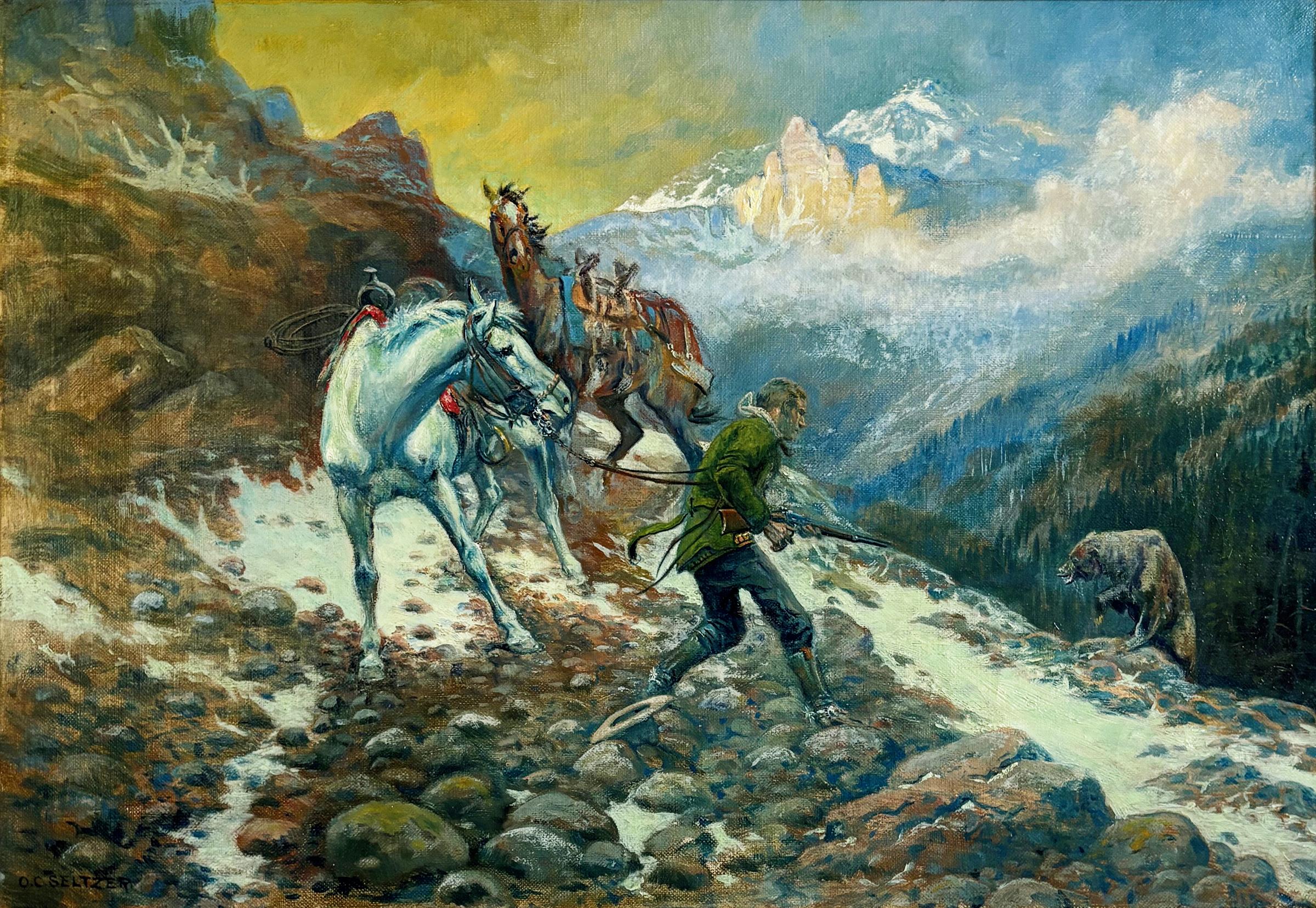
314
Olaf C. Seltzer 1877-1957
Dangerous Grizzly
Oil on canvas
14 x 20 inches
Signed lower left
Estimate: $30,000 - 50,000
Danish-born painter Olaf C. Selter arrived in America at just 14 years. Within weeks of landing on American shores, he was in Montana with his family. First working as a cowboy, Seltzer later found employment with the Great Northern Railway as a machinist and repairman. It was in Great Falls where he met Charles M. Russell and many of Russell’s prominent collectors, who took an immediate liking to the younger artist’s works. In addition to his cowboy and Native American paintings, Seltzer was also fond of hunting and adventure scenes, as seen here in Dangerous Grizzly
SCOTTSDALE ART AUCTION 185
Charles M. Russell
Grizzly at Close Quarters
Provenance:
Collection of J.T. O’Connor, Vancouver, British Columbia
Joe Berlin, Montana
Heffel Galleries, Vancouver, British Columbia, 1980s
Quail Hollow Galleries, Oklahoma City, OK, 1986
Private collection, Montana
Private collection, Canada
Biltmore Galleries, Scottsdale, AZ
Private collection, Florida
The Russell: Sale to Benefit the C.M. Russell Museum, Great Falls, MT, 2016
Private collection, Texas
Literature:
Recorded in Charles M. Russell: A Catalogue Raisonné: CR.UNL.206.
Charles M. Russell was known to paint and sculpt the two opposing identities of bears: the majestic and curious creatures of the forest, and then also the ferocious beasts known to kill and maim men trespassing in the wilderness. Grizzly at Close Quarters falls strictly within the latter depiction. Painted in 1901, this work shows one of Russell’s famous predicament paintings, in which a man has a reckoning with nature, a reckoning that is not resolved within the painting itself. “In the late 1890s Russell began to write and illustrate stories for magazines of outdoor life such as Recreation, Western Field and Stream, and Sports Afield. As his work became better known, his hunting scenes and paintings of wildlife began to attract the patronage of wealthy sportsmen, as well as less well-to-do admirers, who enjoyed the same subjects on postcards, prints and calendars,” writes Russell scholar B. Byron Price. “The element of surprise sets in motion the action portrayed in Grizzly at Close Quarters, as it does in many of Russell’s socalled ‘predicament’ paintings. In this work, a bear suddenly appears behind a prospector and his mule, startling the pair, who are trapped between the proverbial ‘rock and a hard place.’ Although the trapper gets off a shot before the bear closes in, Russell, the master storyteller, lets the viewer decide the final outcome of the encounter.”
SCOTTSDALE ART AUCTION 186

Grizzly at Close Quarters
Watercolor
17 x 14 inches
Signed and dated 1901 lower left with skull
Estimate: $800,000 - 1,200,000
187 SCOTTSDALE ART AUCTION
315
Charles M. Russell 1864-1926

316
Edgar Payne 1883-1947
Third Lake, Temple Crag, Sierras
Oil on canvas
25 x 30 inches
Signed lower right
Estimate: $35,000 - 45,000
Provenance:
Christie’s, Los Angeles, CA, 2006
Private Collection, Newport Beach, CA
Private Collection, Orem, UT
Edgar Payne ventured into the Sierra Nevada mountains for the first time around 1917. It was a cataclysmic moment for the painter, who had already witnessed and painted the Swiss Alps, Venice’s canals and the California Coast. So momentous was that early trip that Payne would revisit the Sierras regularly for the rest of his life, including on many long and arduous trips deep into the country. One newspaper noted in 1921, “His chafed feet are bleeding and his brain reels, but he perseveres for he is a true artist.”
SCOTTSDALE ART AUCTION 188

317
Birger Sandzen 1871-1954
Summer in the Mountains
Oil on canvas
60 x 80 inches
Signed and dated 1923 lower left
Estimate: $250,000 - 350,000
Provenance:
The artist
John S. Ankeney (Director of Dallas Fine Art Museum, 1929-1935)
Bequeathed to Bethany College, Lindsborg, KS
Auction in Santa Fe, 2011
Private collection, California
Coeur d’Alene Art Auction, Reno, NV, 2015
Private collection, New Mexico, 2015
Born in Sweden in 1871, Birger Sandzén never strayed far from his interest in painting. As soon as he was able, he began studying art in Sweden and later in France, as well as getting instruction and motivation from Anders Zorn, Richard Bergh and Per Hasselberg, one of Sweden’s top sculptors. After returning to Sweden from France in 1894, a friend sent Sandzén a booklet on Bethany College in Lindsborg, Kansas. He was immediately intrigued by a line in the booklet referring to Lindsborg as “Little Sweden.” By the end of that year, the artist was in Kansas teaching French, art history, drawing and painting at Bethany College. Later travel to New Mexico and Colorado helped refine his artwork, which would soon include bright patches of thickly applied paint. The combination of impressionism and heavy impasto within Western subjects was quite unique at the time, and it elevated Sandzén’s presence in the United States. Although he would continue to travel around the country, Sandzén always returned to Lindsborg, which is where he died in 1954, 50 years after he arrived.
This massive Sandzén work, painted in 1923, was first acquired by John S. Ankeney, the director of the Dallas Fine Art Museum. He later bequeathed it to Bethany College, where Sandzén remained on the faculty through 1946.
189 SCOTTSDALE ART AUCTION

318
Richard Schmid 1934-2021
Skagway Victorian
Oil on board
8 x 14 inches
Signed lower right; Signed, titled and dated 1991 “Alaska” verso
Estimate: $4,000 - 6,000

319
Richard Schmid 1934-2021
African Violets and Yellow Roses
Oil on canvas
8 x 16 inches
Signed and dated 2008 lower right; Signed, titled and dated 2008 verso
Estimate: $16,000 - 24,000
Literature:
Patrons Without Peer, The McCloy Collection, by Tom Davis, published by Collectors Covey 2009; illustrated p. 180
SCOTTSDALE ART AUCTION 190

320
Richard Schmid 1934-2021
Telluride
Oil on linen
20 x 30 inches
Signed and dated 1995 lower right; Signed and titled verso
Estimate: $60,000 - 90,000
Provenance:
Settler West Gallery, AZ
Private collection, Kansas ca 1993
Richard Schmid devoted his life and career to teaching art, but it goes so far beyond just teaching. Schmid believed that the information should be accessible to artists of all skill levels, because being a great painter shouldn’t be a secret. When he released his art book Alla Prima and its sequel, the subtitles were Everything I Know About Painting and Everything I Know About Painting—And More. And he wasn’t kidding. Born in Chicago, Schmid started painting by the age of 12. By 18 he was selling his art and being instructed by William H. Mosby at the American Academy of Art. After a stint in the military and several moves up and down the East Coast, Schmid was back in Chicago to join the Palette & Chisel Academy, an art school for students of all ages and skill levels. He started as a teacher and left as the president. After moving to Colorado in 1990, he would start other arts clubs and organizations. Many were very informal meet-ups and painting trips meant to celebrate art and the people who made it.
“Somewhere within all of us there is a wordless center, a part of us that hopes to be immortal in some way, a part that has remained unchanged since we were children. It is the source of our strength and compassion,” Schmid wrote in his second Alla Prima book. “That faint confluence of the tangible and the spiritual is where art comes from. It has no known limits, and once you tap into it you will realize what truly rich choices you have. May each painting you do from that sacred place include an expression of gratitude for the extraordinary privilege of being an artist.”
SCOTTSDALE ART AUCTION 191

321
Richard Schmid 1934-2021
New Year’s Eve
Oil on linen
24 x 18 inches
Signed “New Year 1998” lower right;
Signed, titled “Scottish Roses” and dated 1997 verso
Estimate: $50,000 - 75,000
Provenance:
Talisman Gallery, Oklahoma
Private collection, Kansas ca 1998
Richard Schmid painted and taught art within three distinct categories: landscapes, figurative and still life. While he favored all three of them, he would occasionally urge new painters toward still lifes (like his painting New Year’s Eve) for several key reasons: “A still life never has to take a break, or get home to a husband and kids to make supper,” he wrote in Alla Prima II. “Occasionally flowers will wilt, but there are ways around that. Still life allows you to take your time and do things right. You are always in charge. You get to decide what to paint, and how you wish to arrange and light it. It is always there for you. Bon appetite!”
At the time of his death in 2021, Schmid had a doctorate in fine art, had been awarded the John Singer Sargent Medal for Lifetime Achievement by the American Society of Portrait Artists, was the subject of more than 50 one-man shows and his work was in countless institutions around the world, including the Smithsonian, the Gilcrease Museum and the Art Institute of Chicago.
SCOTTSDALE ART AUCTION 192
Water Lilies
Oil on canvas
15 x 16 inches
Signed and dated 2016 lower right;
Signed, titled and dated 2016 verso
Estimate: $15,000 - 20,000


Light Catcher
Oil on board
8 x 10 inches
Signed lower right;
Signed, titled and dated 2016 verso
Estimate: $2,500 - 4,500
SCOTTSDALE ART AUCTION 193
322
Richard Schmid 1934-2021
323
Jeremy Lipking b. 1975
324
Curt Walters b. 1950
Kaibab Trail
Oil on canvas
60 x 48 inches
Signed lower right
Estimate: $25,000 - 40,000

Not since Thomas Moran in the 1800s has an artist been as passionately linked to the Grand Canyon as Curt Walters. The painter, who lives in nearby Sedona, Arizona, was only 19 years old when he saw the canyon for the first time. It was love at first sight, he jokes. Since then he has devoted much of his career to capturing the national park in all its majesty and magnificence. He also is not afraid to show the park as it is, especially when forest fires in Northern Arizona blow smoke into the canyon and limit visibility. Walters is an outspoken defender of the park and actively participates in making it better by donating sales and paintings to the Grand Canyon Foundation, which aims to protect the park for future generations.
In this work, showing the Kaibab Trail, Walters paints a view from one of the most scenic trails down into the canyon. The Grand Canyon has several famous trails, including Bright Angel Trail and South Kaibab Trail originating from the South Rim, and North Kaibab starting on the North Rim. The trails are named after the Kaibab Band of Paiute Indians, who live in Northern Arizona. Native American lands share the boundaries on three sides of the Grand Canyon and many locations in the canyon are considered sacred to several of the different tribes.
SCOTTSDALE ART AUCTION 194
30 x 36 inches
Signed lower left; Signed, titled and dated 2001 verso
Estimate: $20,000 - 30,000
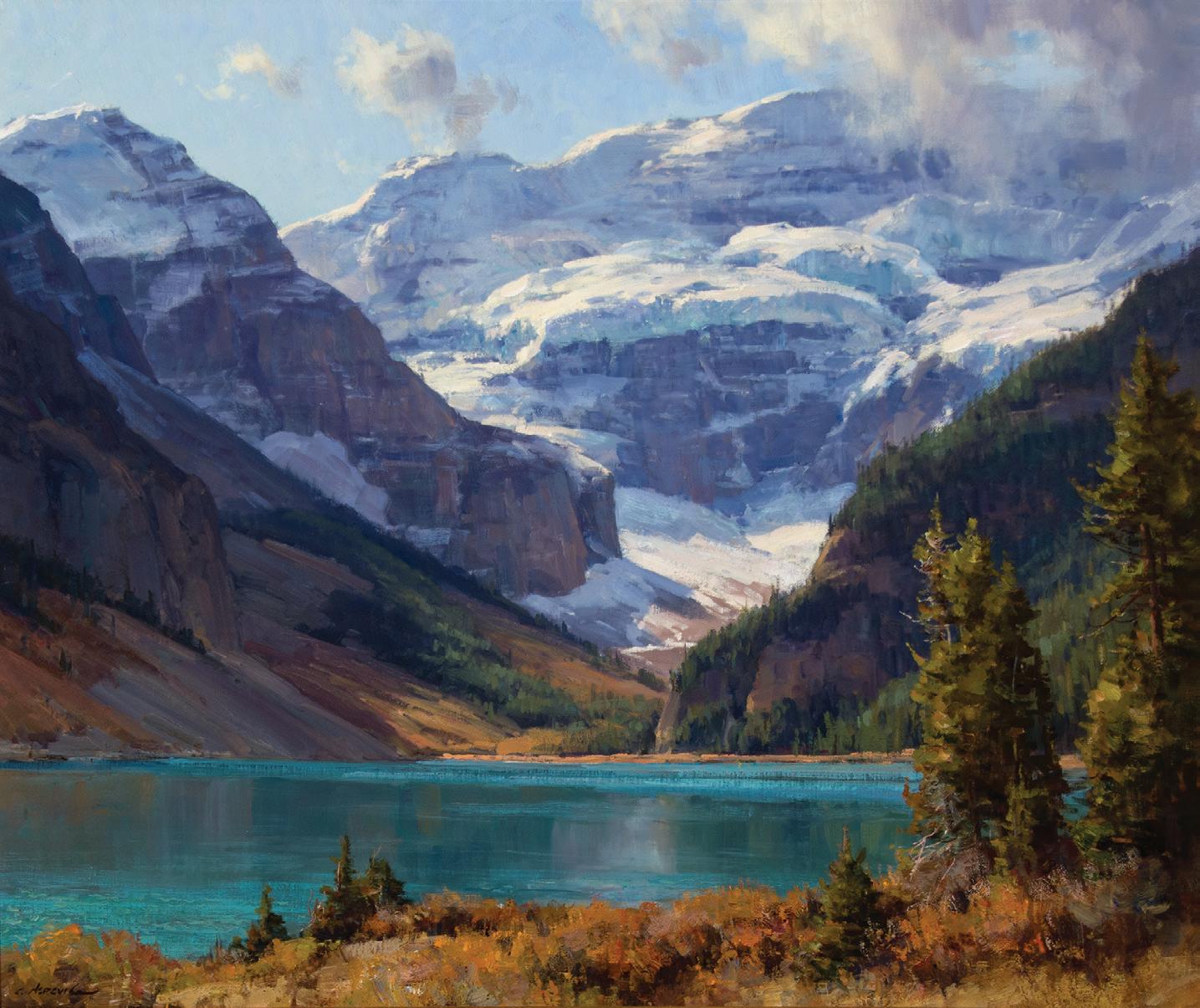

The Next Horizon
Oil on board
28 x 30 inches
Signed lower left; Titled verso
Estimate: $8,000 - 12,000
195 SCOTTSDALE ART AUCTION
325
Clyde Aspevig b. 1951
Lake Louise Canadian Rockies
Oil on board
326
Clyde Aspevig b. 1951

327
Ken Carlson b. 1937 Headrest
Oil on board
10 x 13 inches
Signed lower left
Estimate: $7,000 - 10,000
Bull Moose
Bronze, cast 13/35
12 inches overall height
Signed and dated 1996
Estimate: $2,500 - 3,500

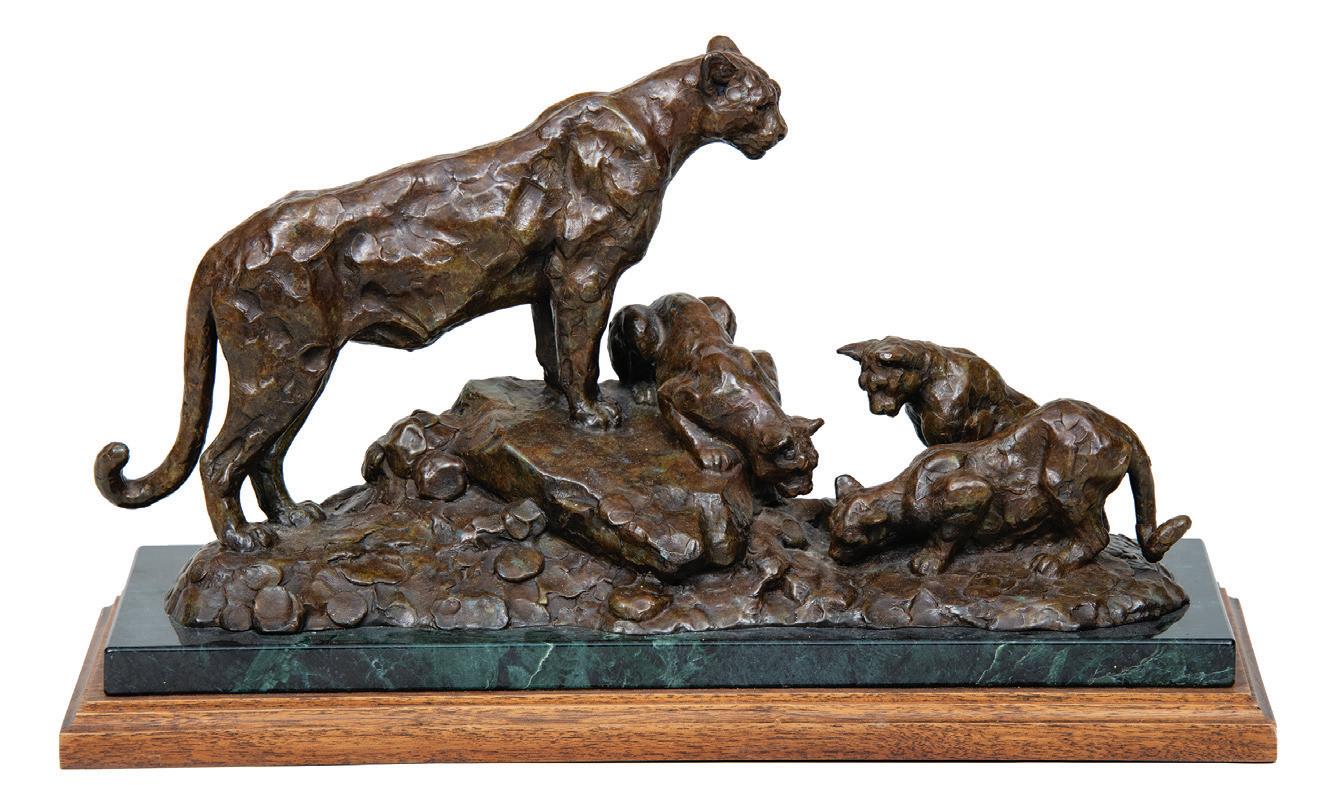
329
Kenneth Bunn 1938-2020
The Track
Bronze, cast 30/35
11 inches high
Signed
Estimate: $4,000 - 6,000
328
Kenneth Bunn 1938-2020
SCOTTSDALE ART AUCTION 196

Ridgeline Repose
Acrylic on board
7 x 14 inches
Signed and dated 07 lower right;
Titled verso
Estimate: $3,500 - 5,000

Elk
Acrylic on board
16 x 32 inches
Signed and dated 12’ lower left
Estimate: $6,000 - 9,000
197 SCOTTSDALE ART AUCTION
330
Daniel Smith b. 1954
331
Daniel Smith b. 1954
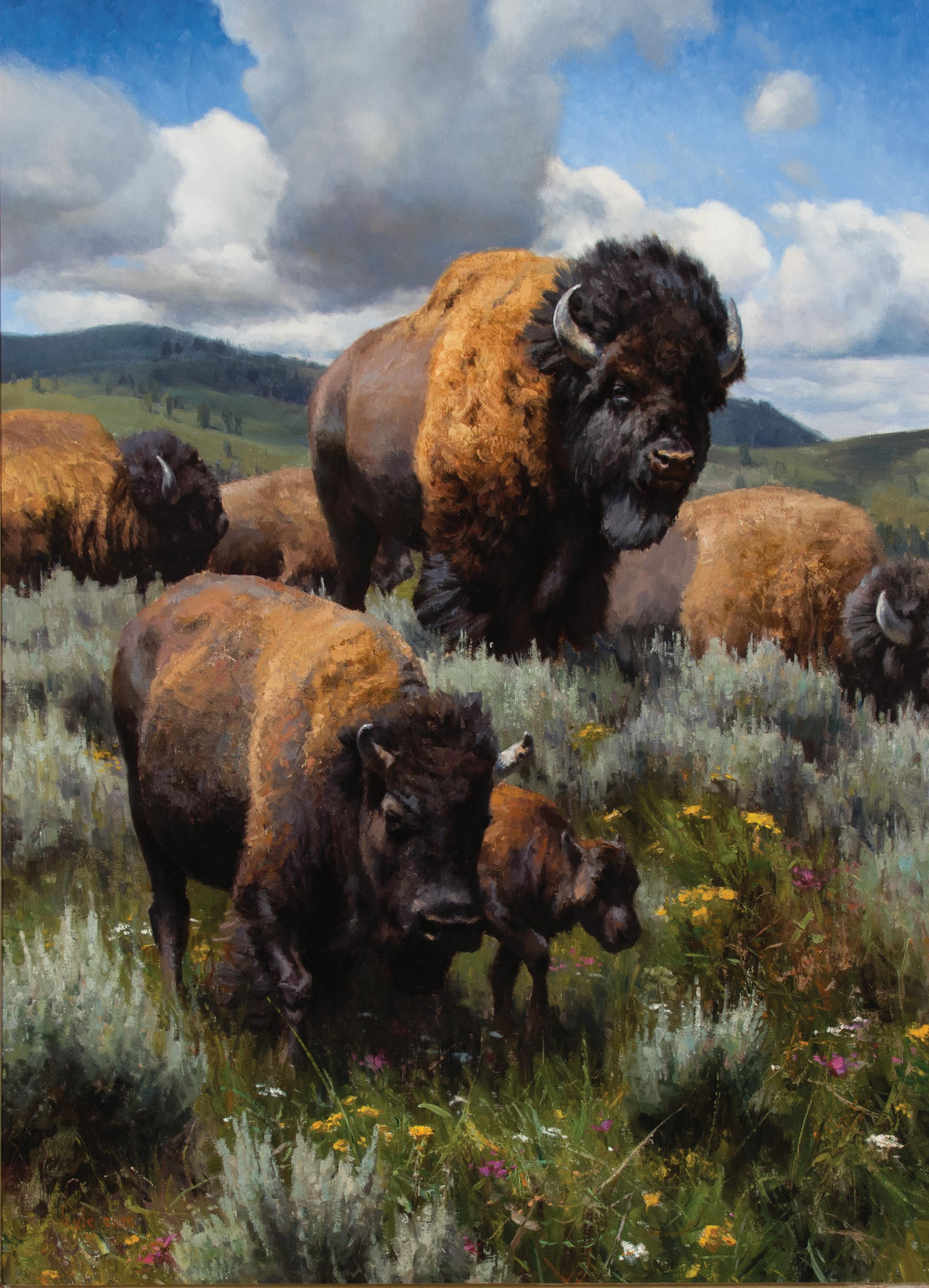
Oil on board
55 x 40 inches
Signed dated 2010 lower left
Estimate: $15,000 - 20,000
SCOTTSDALE ART AUCTION 198
332
Kyle Sims b. 1980
Yellowstone Migration

Lynx
Watercolor and Gouache
16 x 32 inches
Signed and dated 94 lower right
Estimate: $12,000 - 18,000
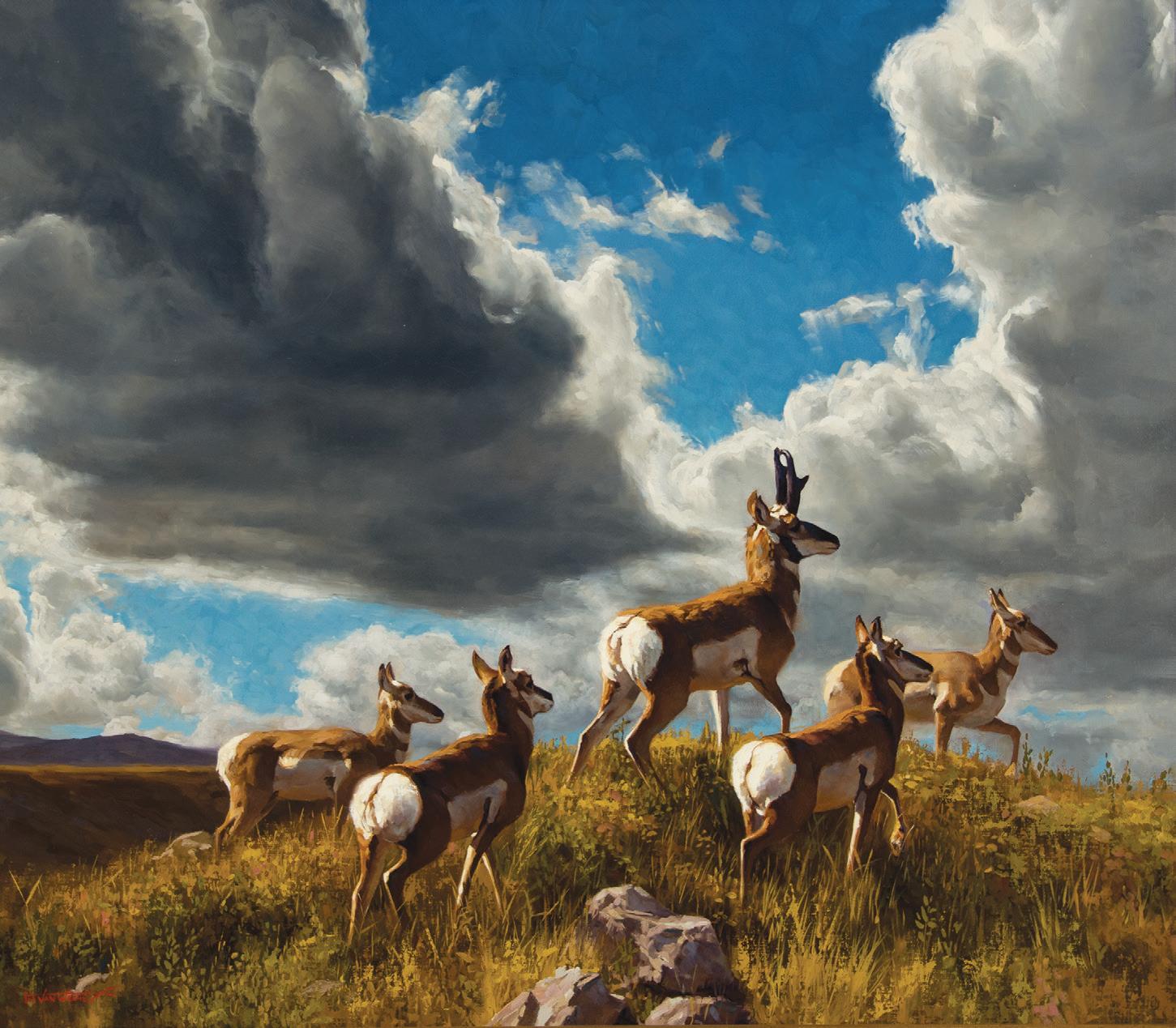
Big Sky Parade
Oil on board
33 x 38 inches
Signed lower left
Estimate: $8,000 - 12,000
SCOTTSDALE ART AUCTION 199
333 Carl Brenders b. 1937
334
Dustin Van Wechel b. 1974
Deep
Oil on board
18 x 22 inches
Signed lower right
Estimate: $4,500 - 6,500


Hunting
Oil on board
24 x 36 inches
Signed lower right
Estimate: $7,000 - 10,000
200 SCOTTSDALE ART AUCTION
335
Michael Coleman b. 1946
Woods Elk
336
Dustin Van Wechel b. 1974
Season
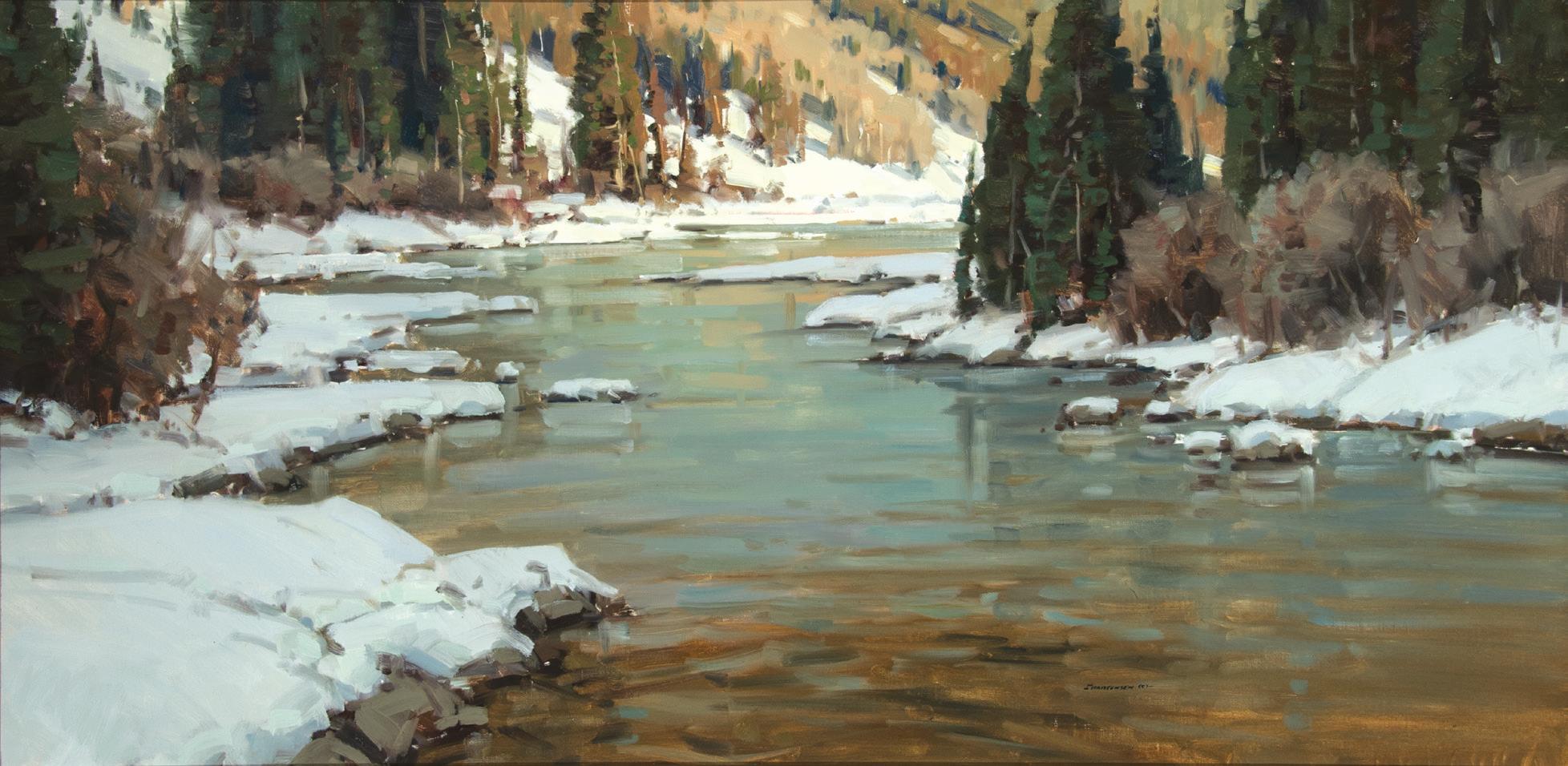
Hoback Canyon, January
Oil on board
24 x 48 inches
Signed lower right
Estimate: $10,000 - 15,000
Winter Village
Oil on canvas
24 x 30 inches
Signed lower right
Estimate: $12,000 - 18,000

SCOTTSDALE ART AUCTION 201
337
Scott Christensen b. 1962
338
Robert Daughters 1929-2013
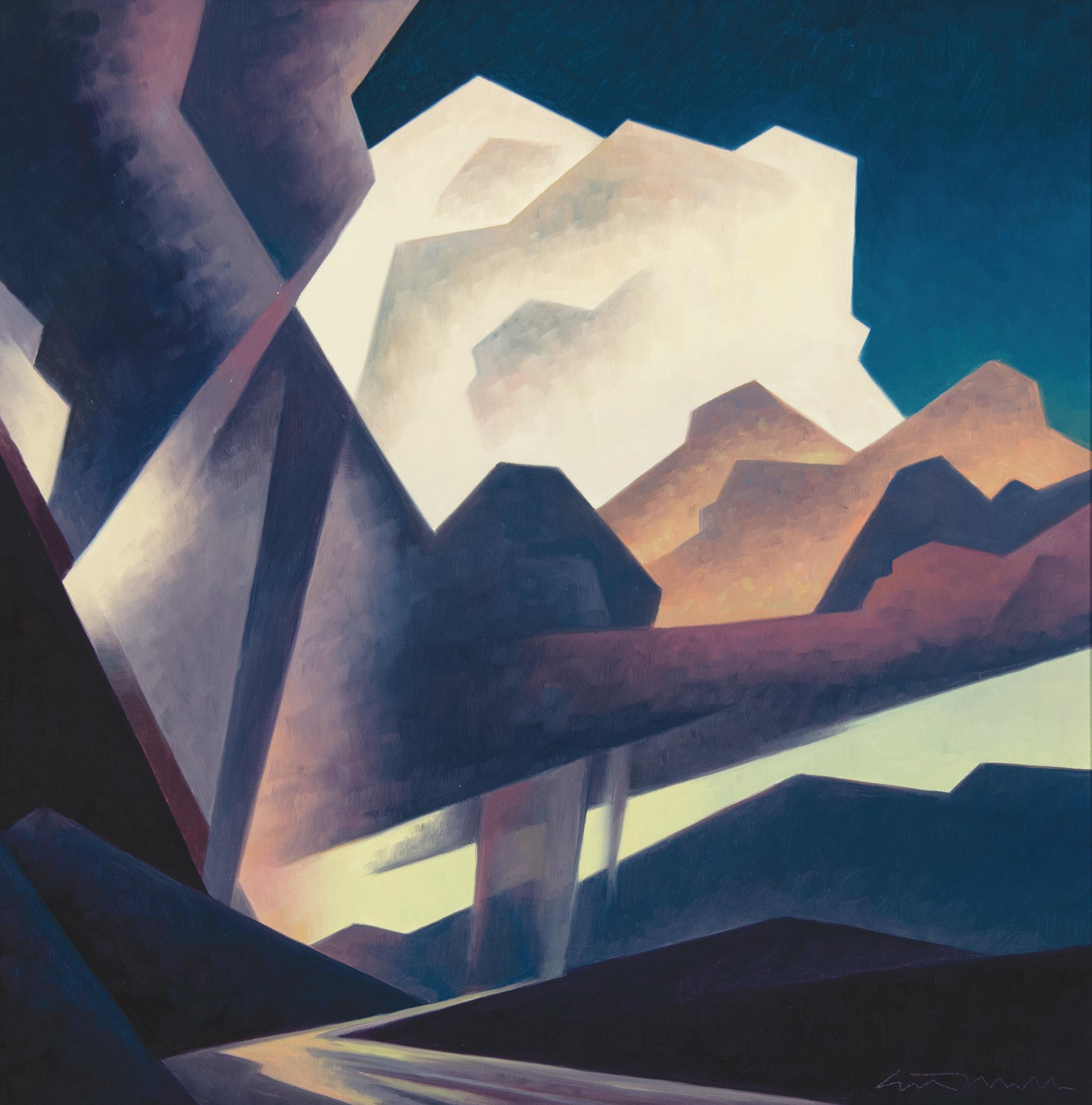
Oil
linen 22 x 22 inches
Signed lower right; Signed, titled and dated 2013 verso
Estimate: $18,000 - 24,000
SCOTTSDALE ART AUCTION 202
339
Ed Mell b. 1942
Cliff Storm
on
24 x 18 inches
Signed lower left; Signed, titled and dated 2006 verso
Estimate: $15,000 - 20,000
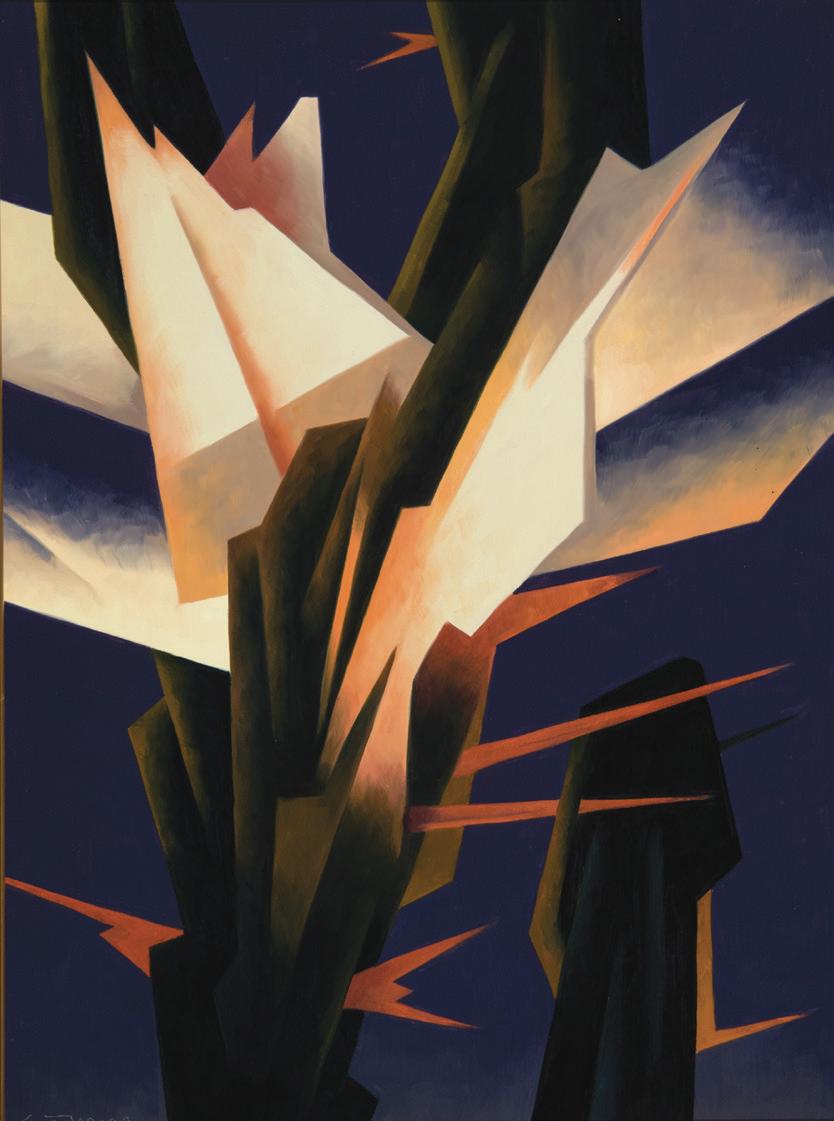
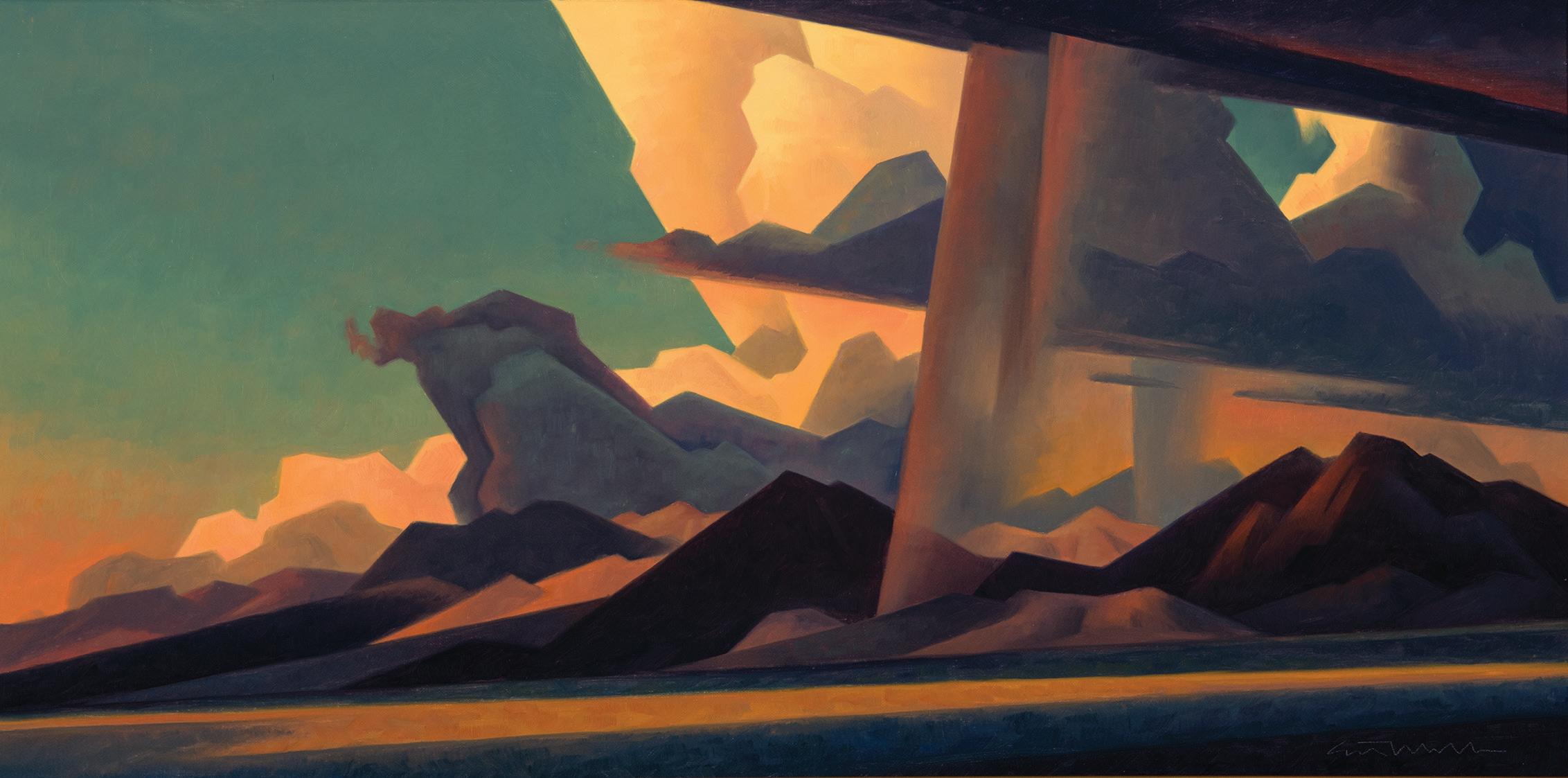
15
Signed lower right; Signed, titled and dated 2014 verso
Estimate: $18,000 - 24,000
SCOTTSDALE ART AUCTION 203
340
Ed Mell b. 1942 Desert Flake
Oil on linen
341
Ed Mell b. 1942 Sundown Storm I Oil on linen
x 30 inches

Protectors
Oil on canvas
40 x 30 inches
Signed lower right; Signed, titled and dated 2021 verso
Estimate: $35,000 - 50,000
SCOTTSDALE ART AUCTION 204
342
Z.S. Liang b. 1953
of the Lakota

Oil on canvas
24 x 18 inches
Signed lower right; Signed, titled and dated 2011 verso
Estimate: $10,000 - 15,000
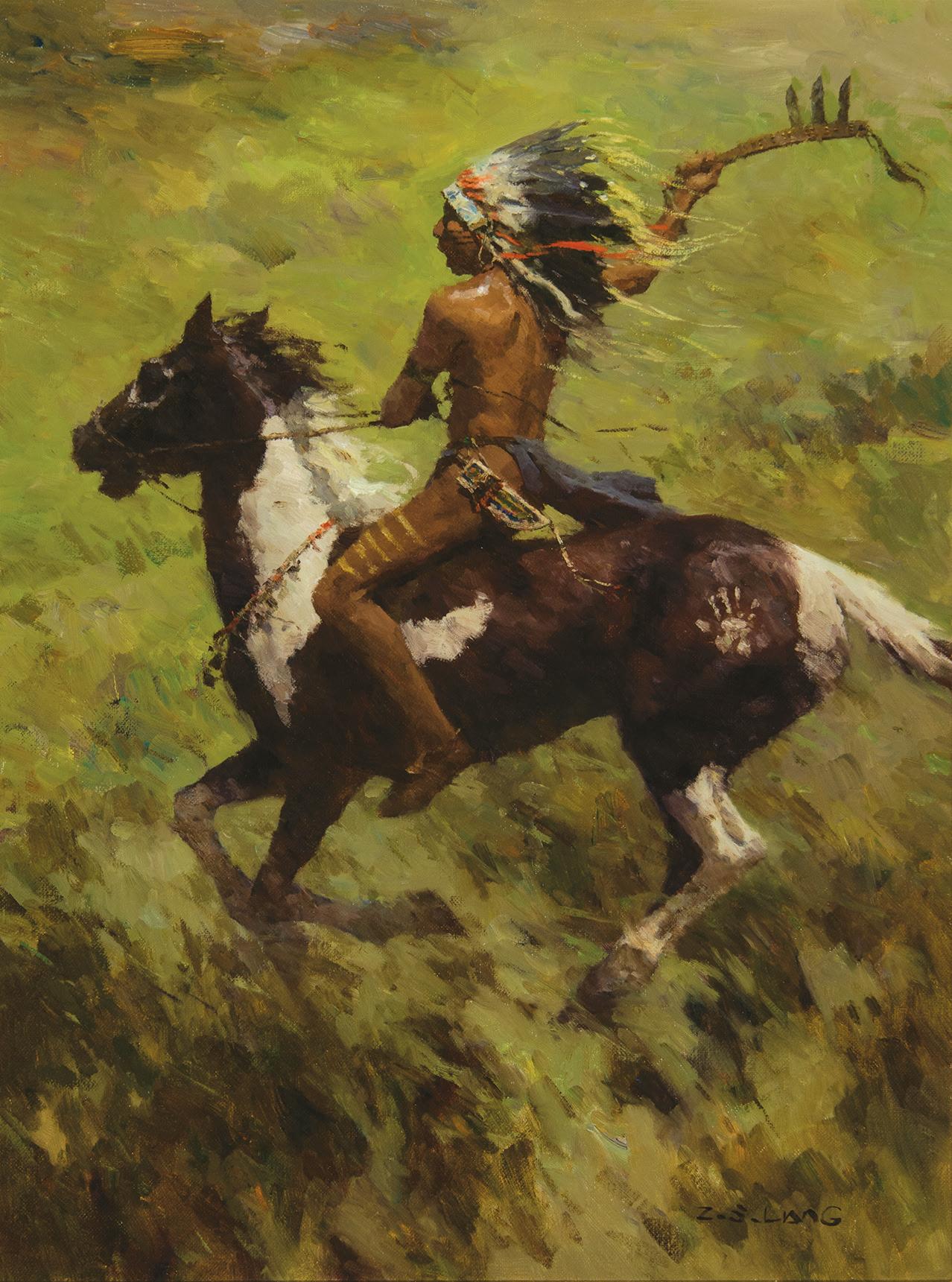
Signed lower right; Signed, titled and dated 2011 verso
Estimate: $10,000 - 15,000
SCOTTSDALE ART AUCTION 205
343
Z.S. Liang b. 1953
Eagle Headdress
344
Z.S. Liang b. 1953
Charging His Enemy Oil on canvas 24 x 18 inches

Pottery Painter
Oil on canvas
28 x 24 inches
Signed lower left
Estimate: $12,000 - 18,000
Sounds In Nature
Oil on board
9 x 7 inches
Signed and dated 2019 lower right; Signed and Titled verso
Estimate: $4,500 - 6,500
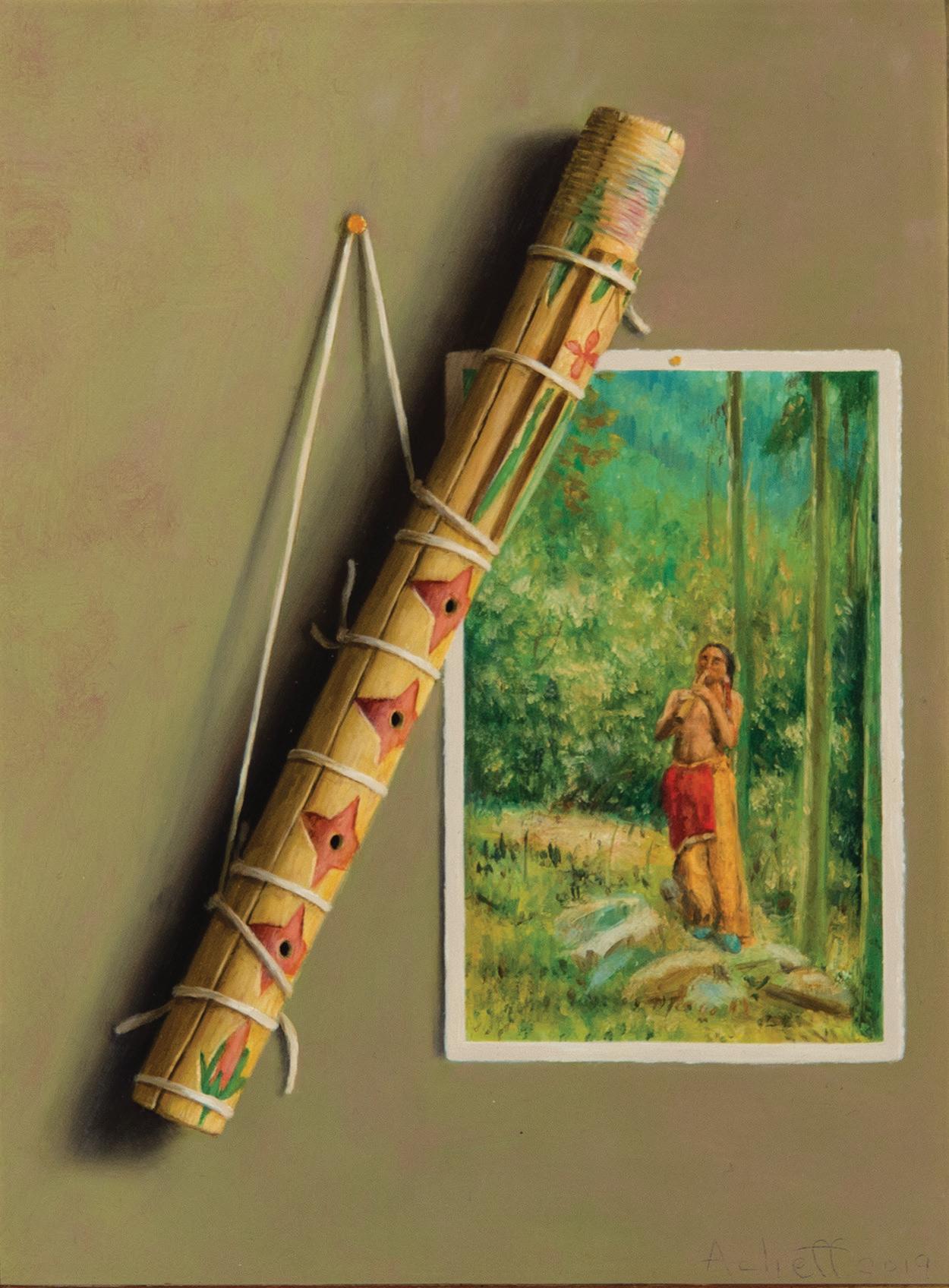
SCOTTSDALE ART AUCTION 206
345
Tim Solliday b. 1952
346
William Acheff b. 1947

The Braves
Oil on board
18 x 30 inches
Signed and dated 74 lower right; Signed and titled verso
Estimate: $18,000 - 24,000
SCOTTSDALE ART AUCTION 207
347 Frank McCarthy 1924-2002

Cuttin the Herd
Oil on
24 x 48 inches
Signed lower right
Estimate: $16,000 - 24,000
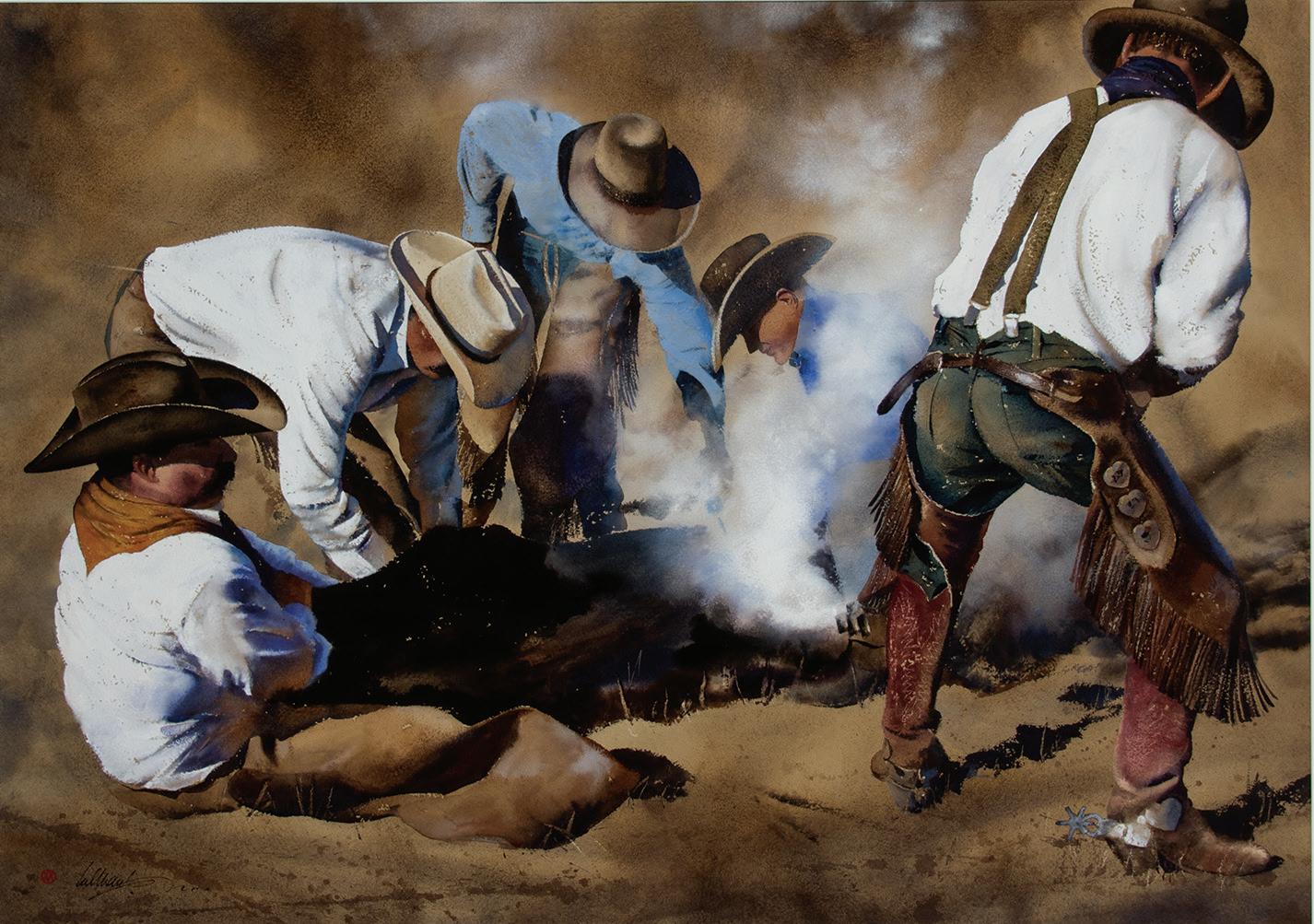
Pitchfork
Watercolor
31 ½ x 45 inches
Signed lower left
Estimate: $6,000 - 9,000
SCOTTSDALE ART AUCTION 208
348
Tom Browning b. 1949
canvas
349
William Matthews b. 1949
Team

Bill
Epilogue
Oil on board
30 x 48 inches
Signed lower right; Signed and titled verso
Estimate: $12,000 - 18,000
351
Bruce Greene b. 1953
Somewhere West of Wall Street
Bronze, cast 64/75
18 inches overall height
Signed/CA
Estimate: $4,000 - 6,000

SCOTTSDALE ART AUCTION 209
350
Anton b. 1957

Oil on board
24 x 36 inches
Signed lower left
Estimate: $25,000 - 35,000
SCOTTSDALE ART AUCTION 210
352
Ken Carlson b. 1937 Tranquil Slopes

Intruder
Bronze, cast 29/35
21 x 20 inches
Signed and dated 1998
Estimate: $6,000 - 9,000
Sounds of September
Bronze, cast 29/35
21 ½ x 27 inches
Signed Estimate: $4,500 - 6,500

SCOTTSDALE ART AUCTION 211
353
Kenneth Bunn 1938-2020
354
Tim Shinabarger b. 1966
355
John Banovich b. 1964
Heading to Better Grazing
Oil on canvas
36 x 24 inches
Signed and dated 2016 lower right
Estimate: $20,000 - 40,000


356
Tim Shinabarger b. 1966
On the Fight - bison
Bronze, cast 13/30
17 inches overall height
Signed
Estimate: $5,000 - 8,000
Literature:
Patrons Without Peer, The McCloy Collection, by Tom Davis, published by Collectors Covey 2009; illustrated p. 185
SCOTTSDALE ART AUCTION 212
Three Outlaw Wisemen: WAYLON, WILLIE, & MERLE
Bronze, cast 25/25
72 inches overall height
Signed and dated 2022
Estimate: $16,000 - 22,000


Oil on board
30 x 24 inches
Signed lower right
Estimate: $4,000 - 6,000
SCOTTSDALE ART AUCTION 213
357
Paul Rhymer b. 1962
358
Dustin Van Wechel b. 1974
Boulder Hopping
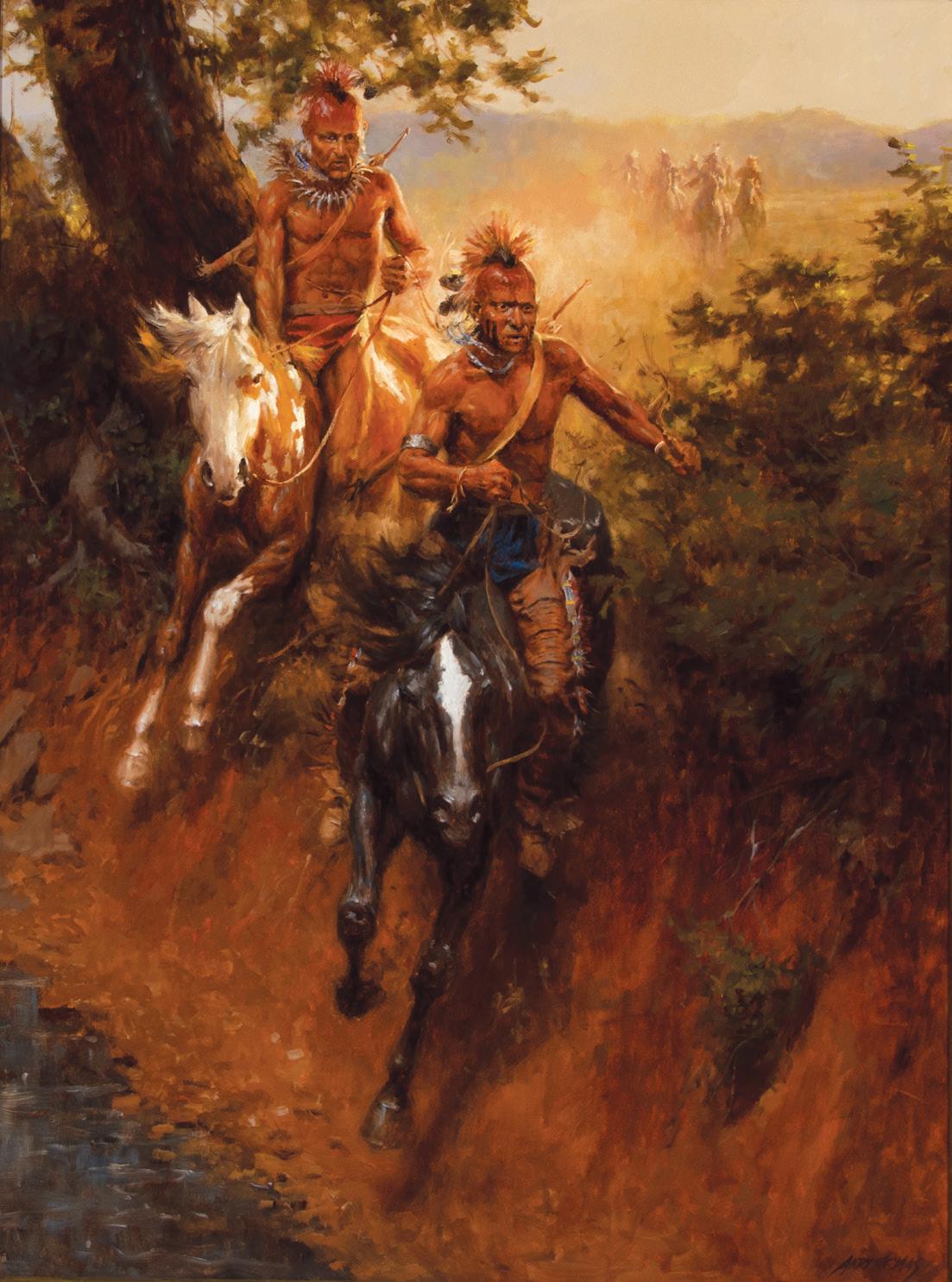
Oil on canvas
40 x 30 inches
Signed lower right
Estimate: $25,000 - 35,000
The Victor Polychrome Bronze, cast VRP 14P 40 inches high
Signed and dated in paint 1991; Signed and dated 1991 in bronze
Estimate: $4,000 - 6,000
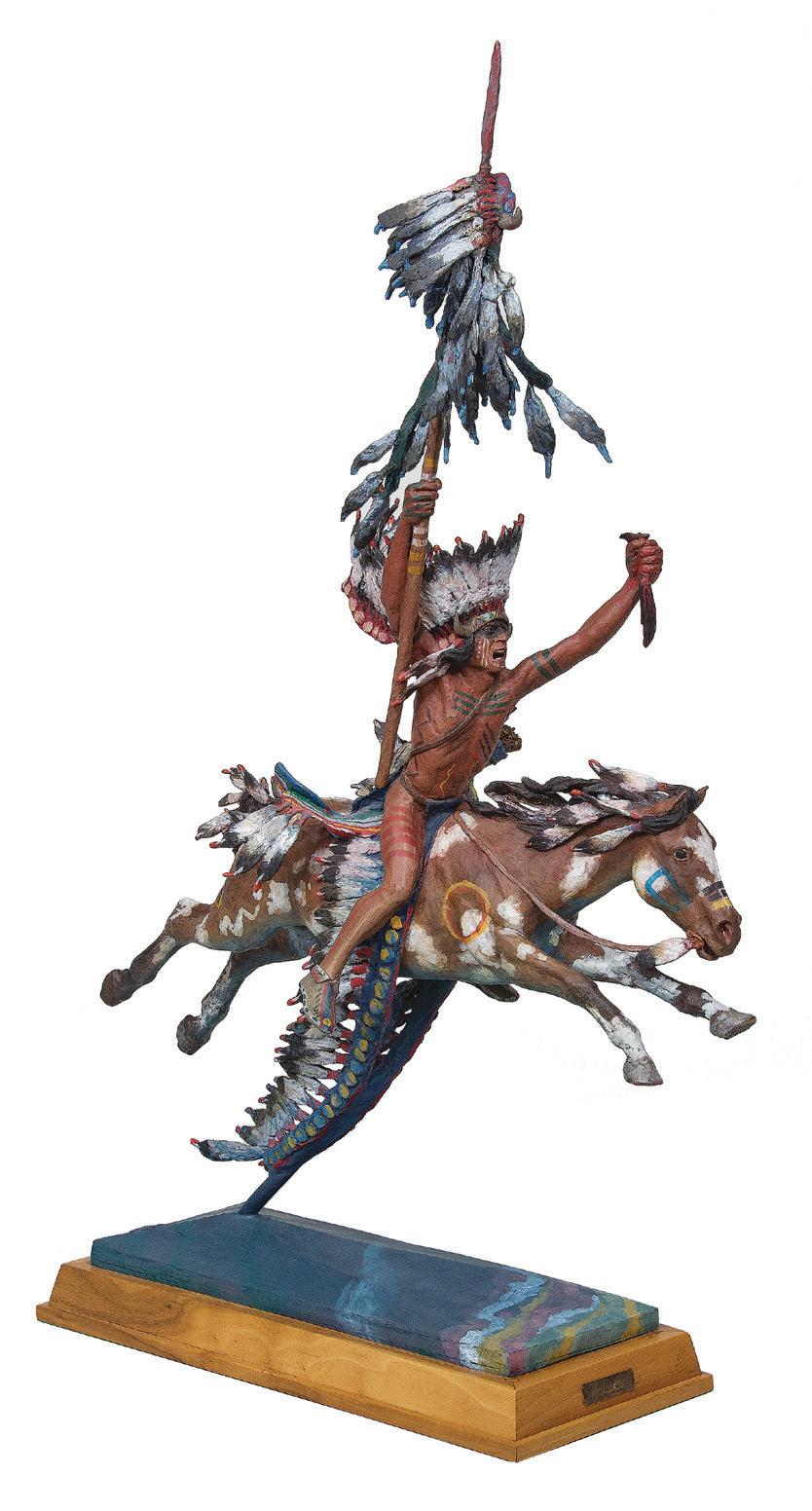
SCOTTSDALE ART AUCTION 214
359
Andy Thomas b. 1957
Pawnee Raiders
360
Harry Jackson 1924-2011
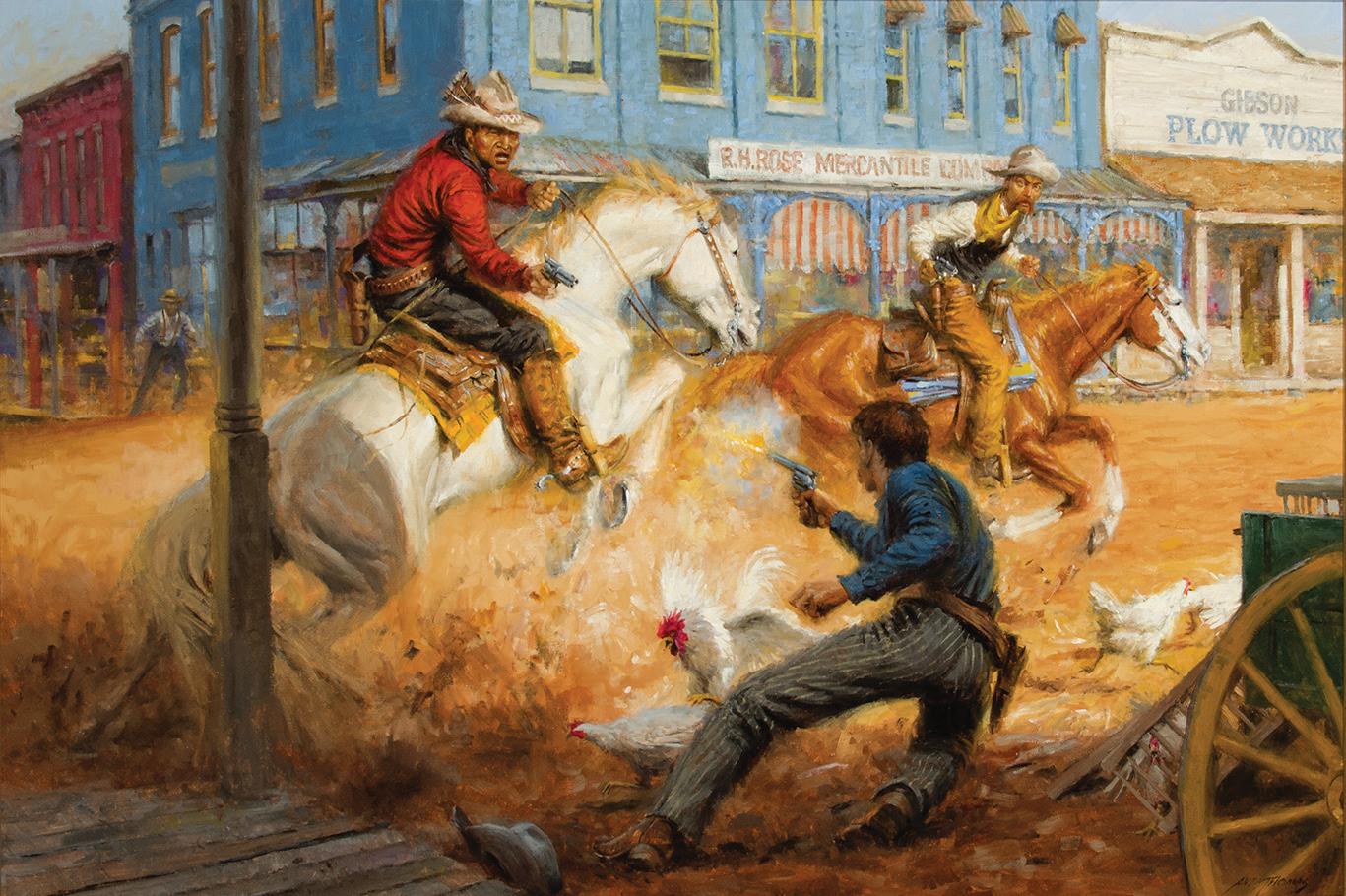
Estimate:
SCOTTSDALE ART AUCTION 215
361
Andy Thomas b. 1957
Jake’s Mistake Oil on canvas 29 x 42 inches
Signed lower right; Signed, titled and dated 2020 verso. Accompanied by a copy of Western Art Collector, August 2021, illustrated on pg. 59 & Letter from the artist
$28,000 - 40,000
Moving Shadows
Oil on board
24 x 24 inches
Signed upper left; Signed, titled and dated 2024 verso Estimate: $6,000 - 9,000


Arthur
1922
Afternoon on a Western River Watercolor
22 ½ x 17 inches
Signed lower right
Estimate: $2,500 - 4,500
SCOTTSDALE ART AUCTION 216
362
Luke Frazier b. 1970
363
Shilstone b.

364
Nicholas Coleman b. 1978
Crackling Fire at Dusk
Oil on canvas
30 x 40 inches
Signed lower right
Estimate: $8,000 - 12,000
365
R. Farrington Elwell 1874-1962
The Honeymoon Oil on canvas 23 x 36 inches
Signed lower right; Titled verso
Estimate: $2,500 - 4,500
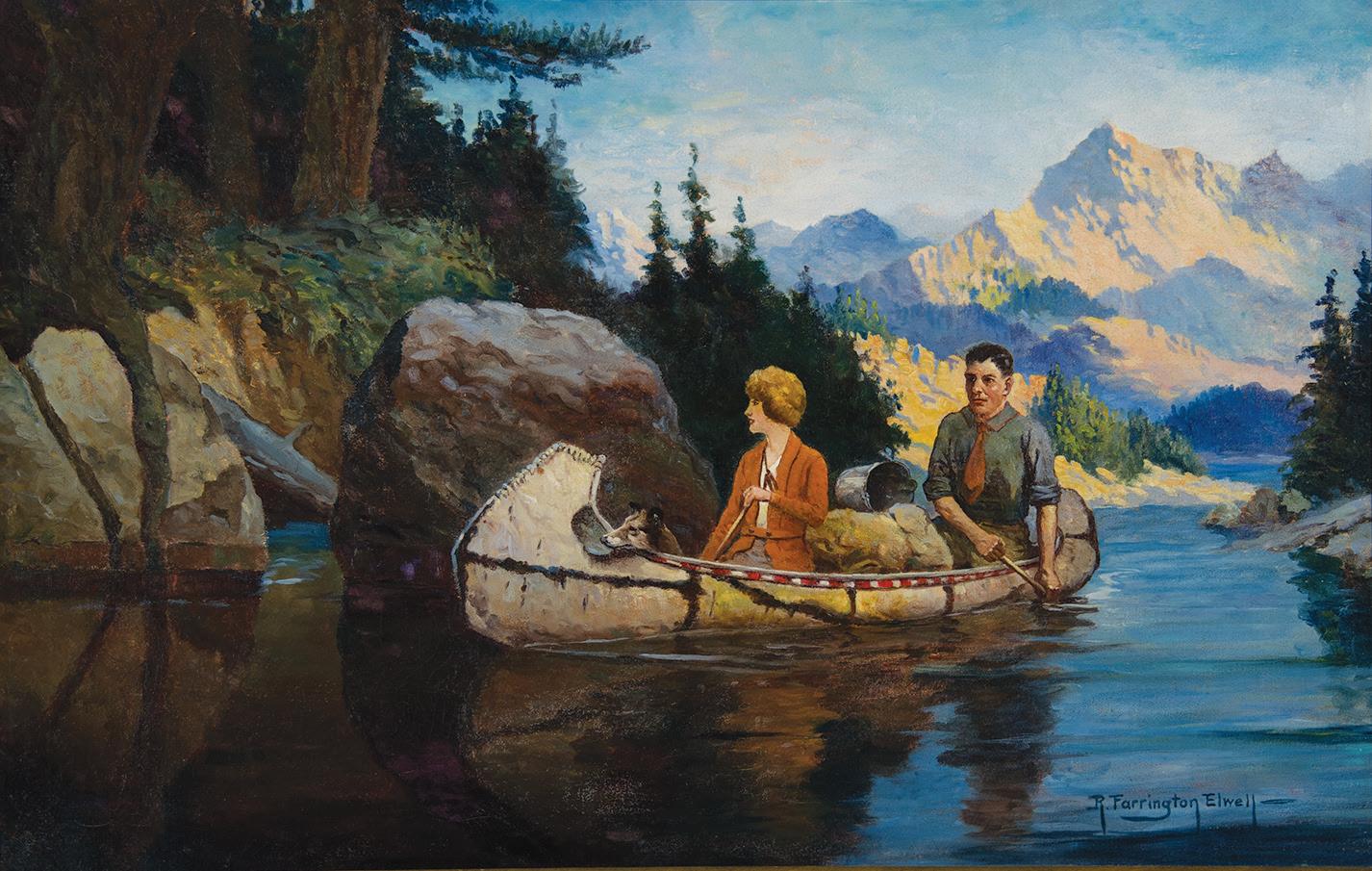
Born in Boston far away from the Western lifestyle, Robert Farrington Elwell was given entrée into the West through one of its most famous figures, William “Buffalo Bill” Cody. Elwell had illustrated some of Cody’s Wild West Show advertising, and the two became unlikely friends—Elwell was 18, Cody was 46. Within a short few years, Elwell would come to meet Frederic Remington, Teddy Roosevelt, Chief Iron Tail and Annie Oakley. Later in his career, he would illustrate for Harper’s, Century Magazine and also pulp magazines Adventure, West and Frontier Stories. He eventually settled in Arizona, where he painted and sculpted Western, adventure and sporting scenes.
SCOTTSDALE ART AUCTION 217

21 ½ x 16 ½ inches
Signed lower left
Estimate: $7,500 - 10,000
Estimate: $4,000 - 6,000

SCOTTSDALE ART AUCTION 218
366
Frank Hoffman 1888-1958
Campfire Serenade
Oil on canvas mounted to board
367
Frank Hoffman 1888-1958
Packing Out
Oil on board 16 x 20 inches
368
Olaf Wieghorst 1899-1988
Rugged Trail
Oil on canvas
28 x 38 inches
Signed lower left
Estimate: $20,000 - 30,000
Accompanied by Olaf Wieghorst book by William Reed. Signed by artist.


369
Paul Calle 1928-2010
Good Hunting
Oil on board
23 ¼ x 34 ¼ inches
Signed and dated 1984 lower left;
Signed verso
Estimate: $28,000 - 38,000
Respected in the West for his artwork of trappers, Paul Calle is known to the larger public as the NASA artist who documented the 1969 Apollo mission that would land humans on the moon. Calle was the only artist in the room as Apollo 11 astronauts Neil Armstrong, Buzz Aldrin and Michael Collins prepared for their historic trip into space, and those early sketches informed a whole portfolio of NASA images, including some of the most reproduced stamps ever released by the United States Postal Service. In 1973, Calle turned his attention to the West, where he painted adventure scenes of Native Americans and early American explorers and trappers. Good Hunting shows one of Calle’s most iconic subjects, a trapper identifiable by his red coat fashioned from a Hudson Bay blanket.
SCOTTSDALE ART AUCTION 219
370
Harry Jackson 1924-2011
Sor Capanna (Man with Guitar)
Bronze, cast 2
Lifesize - 77 inches overall height
Signed and dated 1962
Estimate: $20,000 - 30,000

In his 1981 book Harry Jackson, the artist tells the story of Sor Capanna: “In 1958 and ’59 I went to Rome a lot, and there I met a big, likable American named Remington Olmsted, who had just started a restaurant in the Trastevere section called Da Meo Patacca. He and I loved to sing cowboy songs while Italian street musicians supplied the background. It was a very unusual but sympathetic musical marriage—we were all really doing the same thing. Remy then commissioned me in 1961 to do a statue of the great street singer and poet Sor Capanna, who was a hero of the poor people of Trastevere. He sang about his people and their whole history until his death in 1923. Naturally, the Establishment hated him. He spent most of his life in and out of jail. He was a man after my own heart, both as a poet who sang his own verses, and as an outlaw. In both respects he is the same breed as the artist and the cowboy, for whom ‘goin’ to jail is just one of the hazards of goin’ to town.’”
SCOTTSDALE ART AUCTION 220

Dog Soldier
Bronze, Polychrome cast #DSZP 26 ½ inches overall height
Signed and dated 1983 - Signed and dated in Paint 1985; Foundry Stamp and Thumbprint
Estimate: $6,000 - 9,000
The Flagbearer
Bronze, cast 20
23 inches overall height
Signed and dated 59
Estimate: $8,000 - 12,000

SCOTTSDALE ART AUCTION 221
371 Harry Jackson 1924-2011
372 Harry Jackson 1924-2011

Caught in the Open Oil on board 24 x 48 inches
Signed/CA and dated 1981 lower left; Signed, titled and dated 1981 verso
Estimate: $20,000 - 30,000
Literature:
The Art of Frank C. McCarthy, by Elmer Kelton, published by William Morrow & Company, Inc., New York, 1992; illustrated p. 136, 137
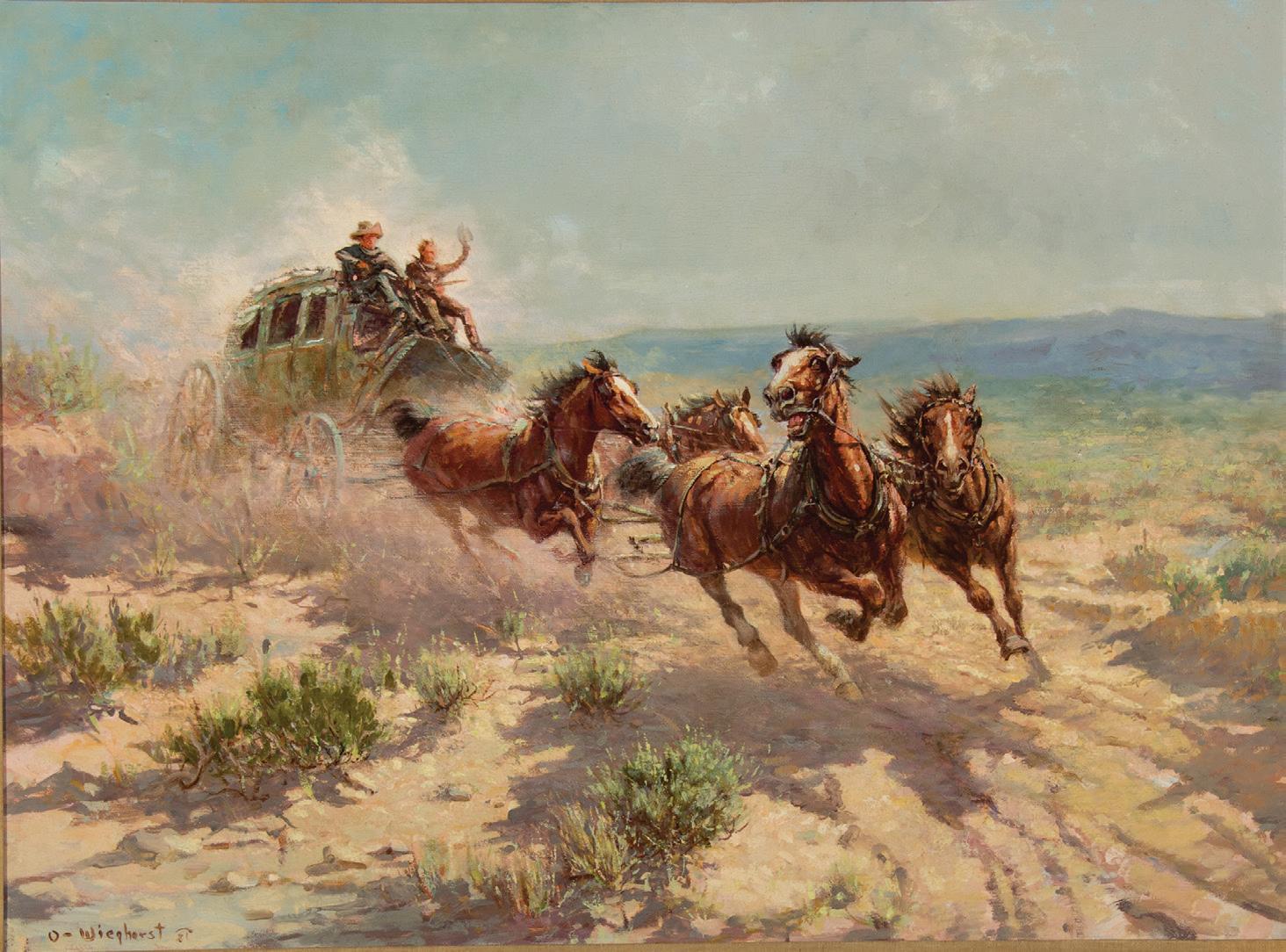
Mail Going East to West Oil on canvas 28 x 38 inches
Signed lower left
Estimate: $15,000 - 25,000
SCOTTSDALE ART AUCTION 222
373 Frank McCarthy 1924-2002
374
Olaf Wieghorst 1899-1988

The Old Pro
Oil on board
22 x 40 inches
Signed/CA and dated 1978 lower left; Signed, titled and dated 9/15/78 verso
Estimate: $20,000 - 30,000
Literature:
Southwest Art, October 1978: cover.
James Reynolds captured the images of American cowboys, but he also sang to their souls. With paintings of working cowboys, many in yellow slickers fighting the elements or at sunset’s golden hour, the California-born artist brought life to both the cowboys of lore and their present-day versions. “Most people will go through life without ever having seen a real cowboy,” he wrote in Traildust: The Art of James Reynolds. “Yet, as with some exotic endangered creature, they have heard rumors of his existence and are intrigued by the stories. Folks who live close to cow country are pleased to report: the cowboy is alive and well. You just can’t see him from the interstate.”
Two Riders
Oil on board
18 x 24 inches
Signed/CA lower left
Estimate: $10,000 - 15,000

SCOTTSDALE ART AUCTION 223
375
James Reynolds 1926-2010
376
James Reynolds 1926-2010

Oil
30 x 48 inches
Signed/CA lower left;
Signed/CA, titled and dated 2012 verso
Estimate: $14,000 - 24,000
Watercolor
10 x 14 inches
Signed lower right
Estimate: $4,000 - 6,000

224
377 Jason Rich b. 1970
Prairie Scouts
on board
378 Herman Hansen 1854-1924 Homeward Bound
SCOTTSDALE ART AUCTION
379
Robert Pummill b. 1936
Summit Meeting
Oil on canvas 24 x 30 inches
Signed/CA and dated 90 lower right
Estimate: $7,000 - 10,000


380
Harry Jackson 1924-2011 Marshall II
Polychrome Bronze, cast MAII 44P 17 ½ inches overall height
Signed and dated 1979; Foundry stamp and thumb print
Estimate: $4,000 - 6,000
SCOTTSDALE ART AUCTION 225
381
Dan Ostermiller b. 1956
The Orphan
Bronze, cast 7/12
45 inches high and 70 inches wide
Signed and dated 2002
Estimate: $25,000 - 45,000

SCOTTSDALE ART AUCTION 226
382
Dan Ostermiller b. 1956
Copete
Bronze, cast 2/12
52 inches tall
Signed and dated 2014
Estimate: $12,000 - 18,000


383
Dan Ostermiller b. 1956
Wanda
Bronze, casr 6/20
19 ½ inches overall height
Signed and dated 2004
Estimate: $10,000 - 15,000
SCOTTSDALE ART AUCTION 227

Summer Shade
Oil on board
8 x 10 inches
Signed lower right
Estimate: $4,000 - 6,000
Oil on board
14 x 18 inches
Signed lower right
Estimate: $2,500 - 4,500

SCOTTSDALE ART AUCTION 228
384
Ken Carlson b. 1937
385
Bonnie Marris b. 1951
Hanging Out
Tim Shinabarger b. 1966
Chadwick Ram
Bronze, cast 24/36
15 ½ inches overall height
Signed and dated 2021
Estimate: $3,000 - 5,000

Bronze, cast 26/35
9 ½ inches overall height
Signed and dated 1999
Estimate: $1,500 - 2,500

Oil on canvas
12 x 24 inches
Signed lower right
Estimate: $1,500 - 2,500

SCOTTSDALE ART AUCTION 229
386
387 Kenneth Bunn 1938-2020 Grey Ghost-Lynx
388 Gary Swanson 1941-2010 Surprise Attack
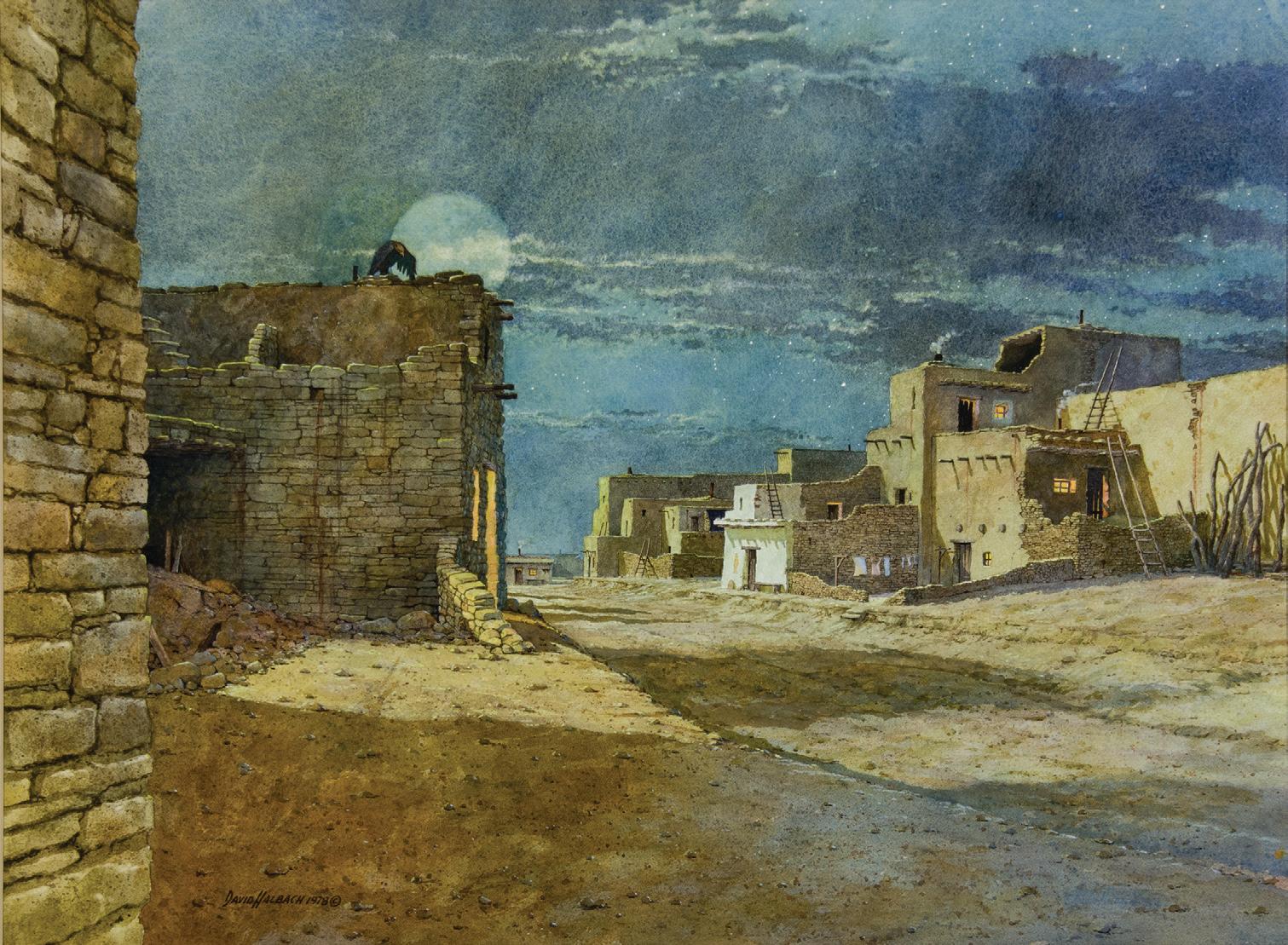
For Feathers Only
Watercolor
21 ½ x 29 inches
Signed and dated 1978 lower left; Titled verso
Estimate: $3,000 - 5,000
Place: The Hopi Village of Mishongnovi at Second Mesa, Arizona (one of three mesas).
Story: The Golden Eagle is tethered on the roof of the pueblo. Throughout the village this scene is repeated a number of times. The purpose is to enable the Hopi to have, when needed, the sacred feathers of the eagle for their religious needs. The eagle is not harmed, other than to remove a feather as needed.
Gold Metal Winner; George Phippen Memorial Art Show, 1978. Prescott, Arizona
The Veteran
Acrylic on board
34 x 24 inches
Signed lower right
Estimate: $3,500 - 4,500

SCOTTSDALE ART AUCTION 230
389
David Halbach 1931-2022
390
David Wright b. 1942

391
Jim Norton 1953-2023
Prayers of the Flute
Oil on canvas
40 x 30 inches
Signed/CA lower left
Estimate: $8,000 - 12,000
392
Don Crowley 1926-2019
All Her Possessions
Oil on canvas
40 x 31 ½ inches
Signed/CA lower right;
Signed/CA and titled verso
Estimate: $6,000 - 9,000

SCOTTSDALE ART AUCTION 231

William Acheff
Gourdes
Oil on linen
10 x 18 inches
1947
Signed and dated 1996 lower left; Signed, titled and dated 1996 verso
Estimate: $5,000 - 8,000
William
Taos Kitchen
Oil on canvas
8 ½ x 10 inches
Signed and dated 1991 lower right;
Signed and dated 1991 verso
Estimate: $4,000 - 6,000
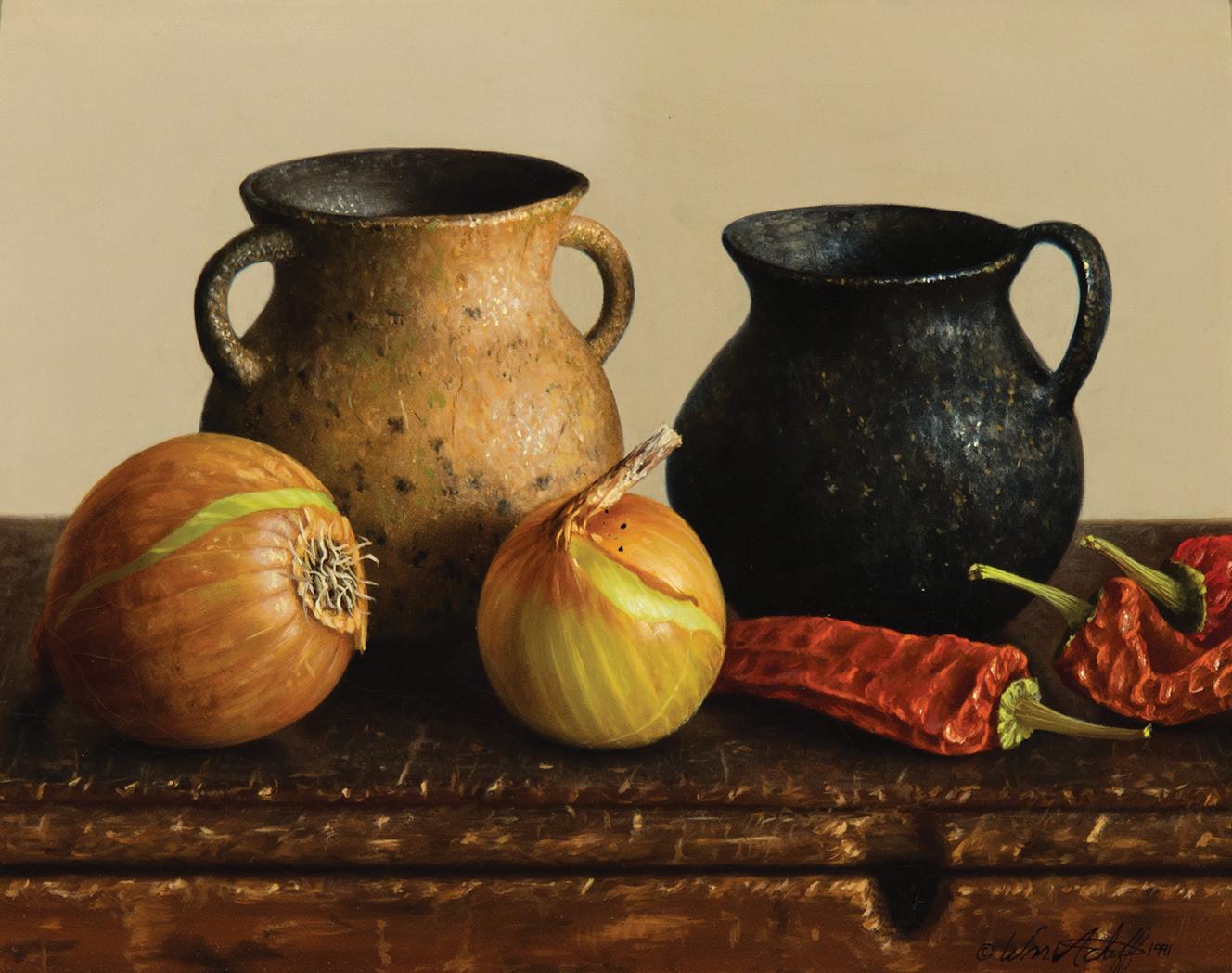
SCOTTSDALE ART AUCTION 232
393
b.
394
Acheff b. 1947

395
Doug Hyde b. 1946
Daka’s Rattle
Bronze, cast 8/12
63 inches overall height
Signed
Estimate: $15,000 - 25,000
SCOTTSDALE ART AUCTION 233
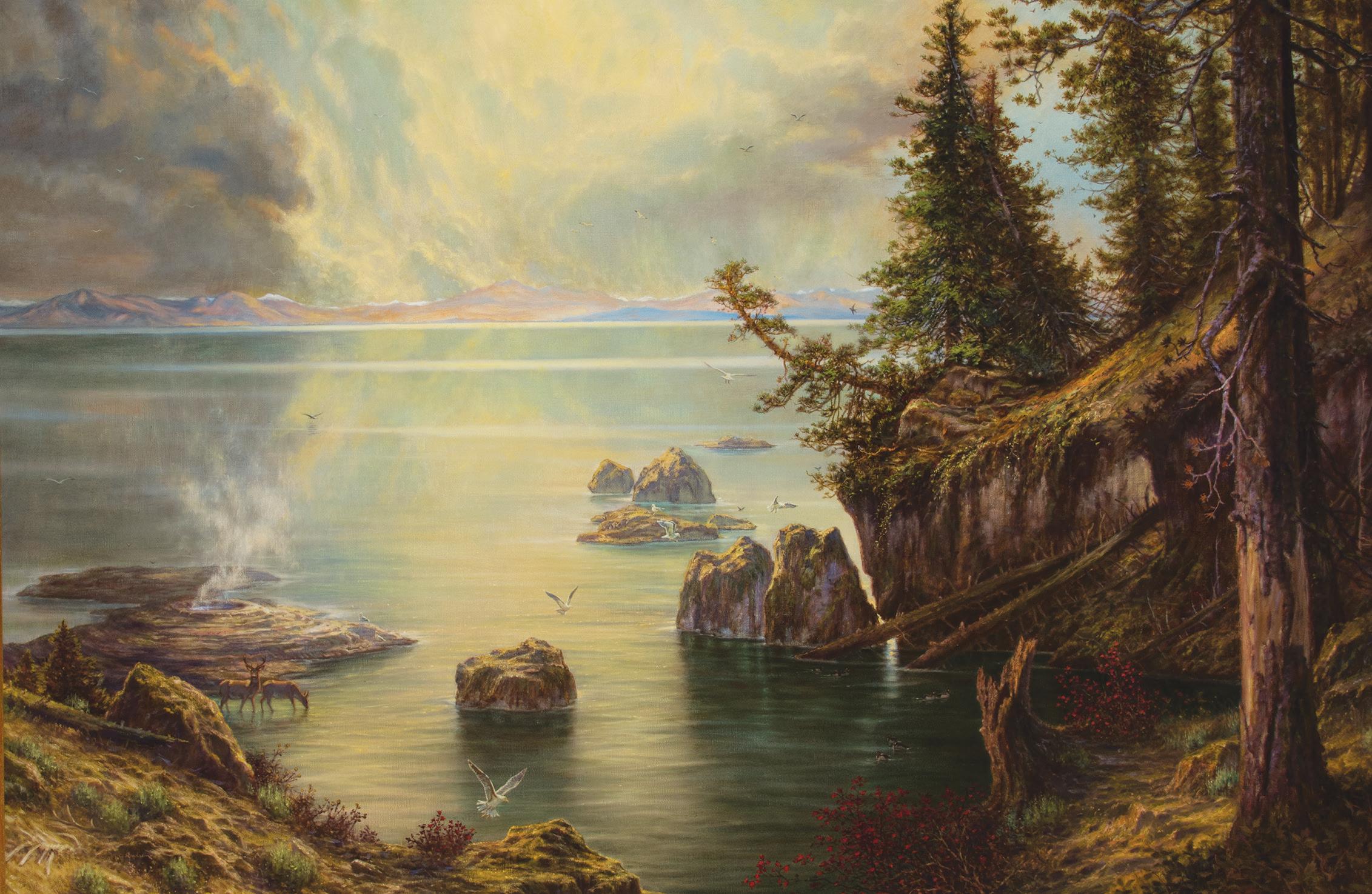
396
M.C. Poulsen b. 1953
Approaching Storm (Yellowstone Lake)
Oil on canvas
40 x 60 inches
Signed lower left
Estimate: $15,000 - 25,000
SCOTTSDALE ART AUCTION 234

Thomas Hill 1925
Western Waterfall
Oil on canvas
20 x 16 inches
Signed lower right
Estimate: $6,000 - 9,000
Frozen Brilliance
Oil on board
20 x 20 inches
Signed lower left;
Titled verso
Estimate: $6,000 - 9,000

SCOTTSDALE ART AUCTION 235
397
398
Curt Walters b. 1950
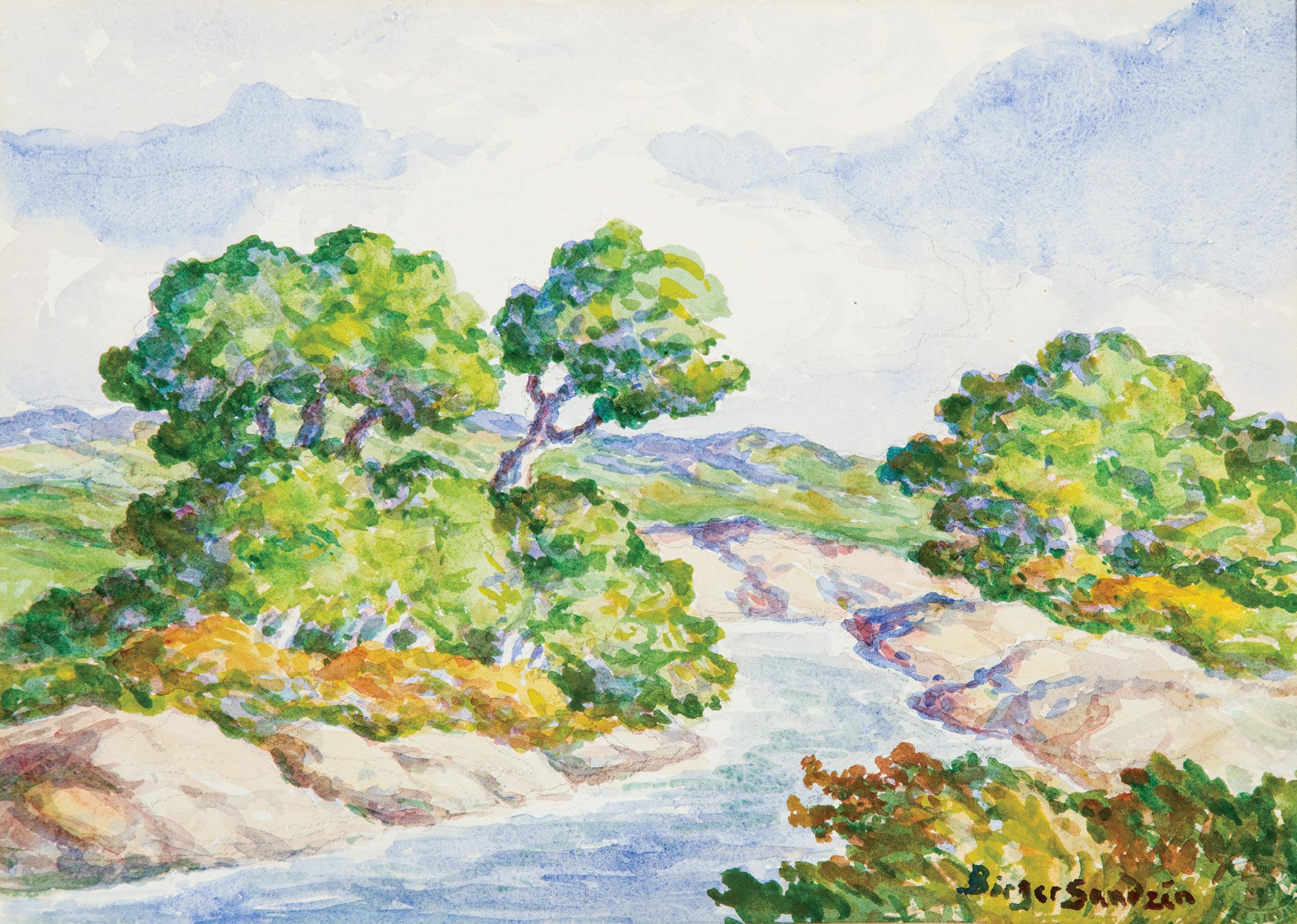
399
Birger Sandzen 1871-1954
Riverbend, Smoky River Watercolor
11 x 15 inches
Signed lower right
Estimate: $4,500 - 6,500
400
Conrad Schwiering 1916-1986 Ghosts of the Morning Oil on board
25 x 30 inches
Signed and dated 1983 lower left;
Signed verso
Estimate: $9,000 - 12,000
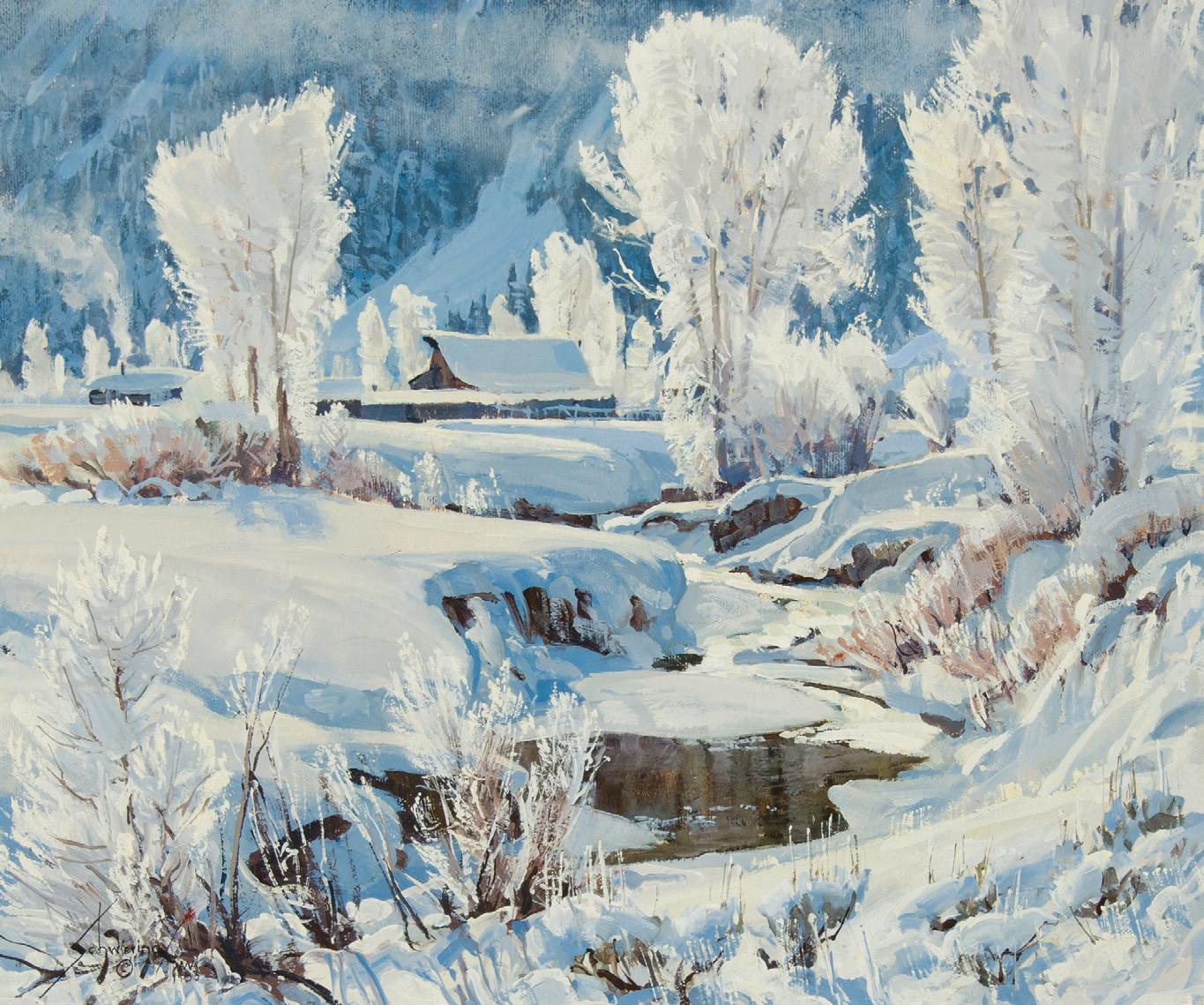
SCOTTSDALE ART AUCTION 236
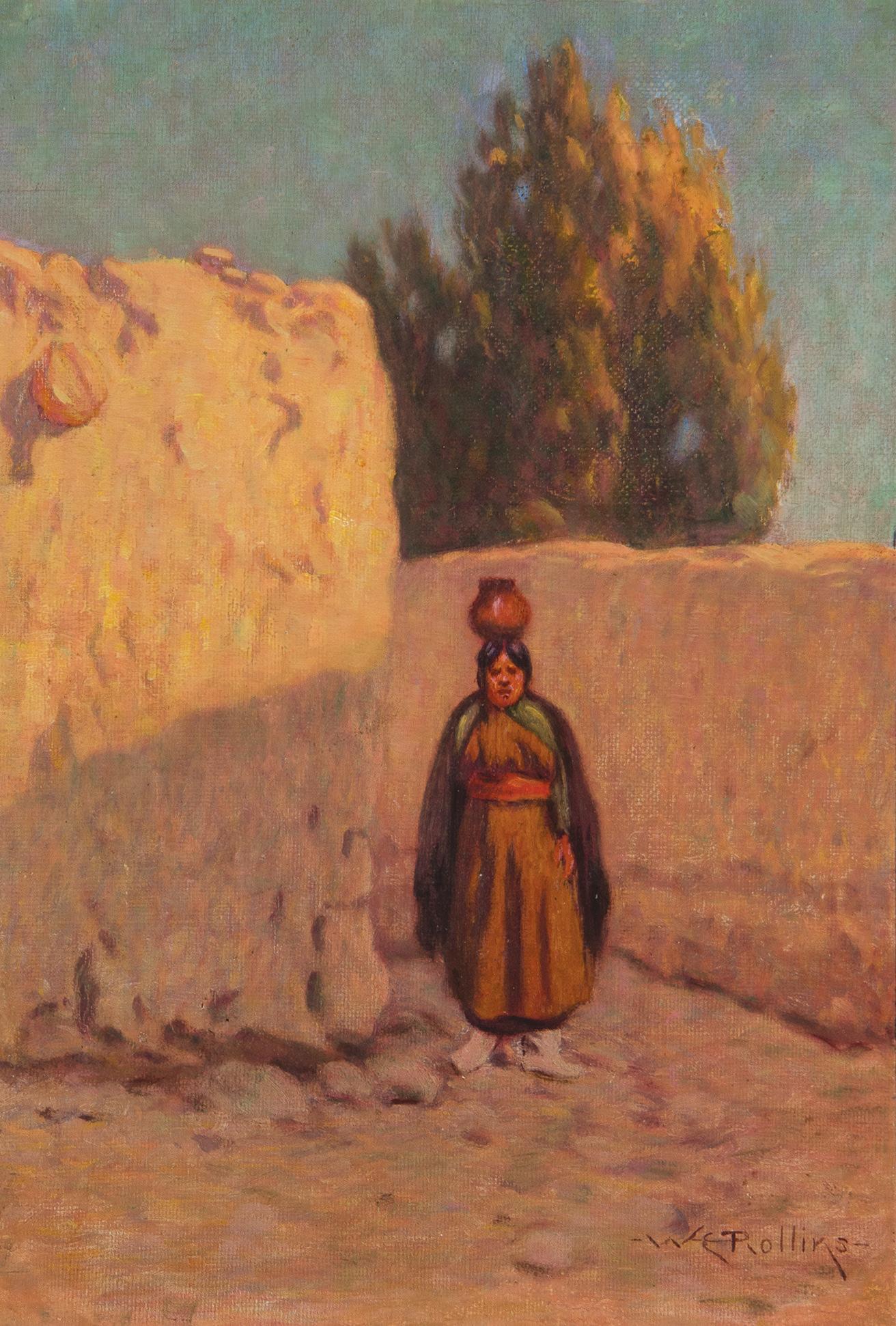
Pueblo Indian
Oil on linen
15 x 10 ½ inches
Signed lower right
Estimate: $3,000 - 5,000

402
Ray Roberts b. 1954
Canyon Color
Oil on board
16 x 12 inches
Signed lower right;
Signed and titled verso
Estimate: $1,800 - 2,800
SCOTTSDALE ART AUCTION 237
401
Warren Rollins 1861-1962

John Wayne
Bronze, cast WU17
27 inches overall height
Signed and dated 1981, with thumb print
Estimate: $6,000 - 8,000
Ropin’ a Star
Bronze, cast RS51
29 inches overall height
Signed and dated 1982; Foundry stamp and thumb print
Estimate: $6,000 - 9,000
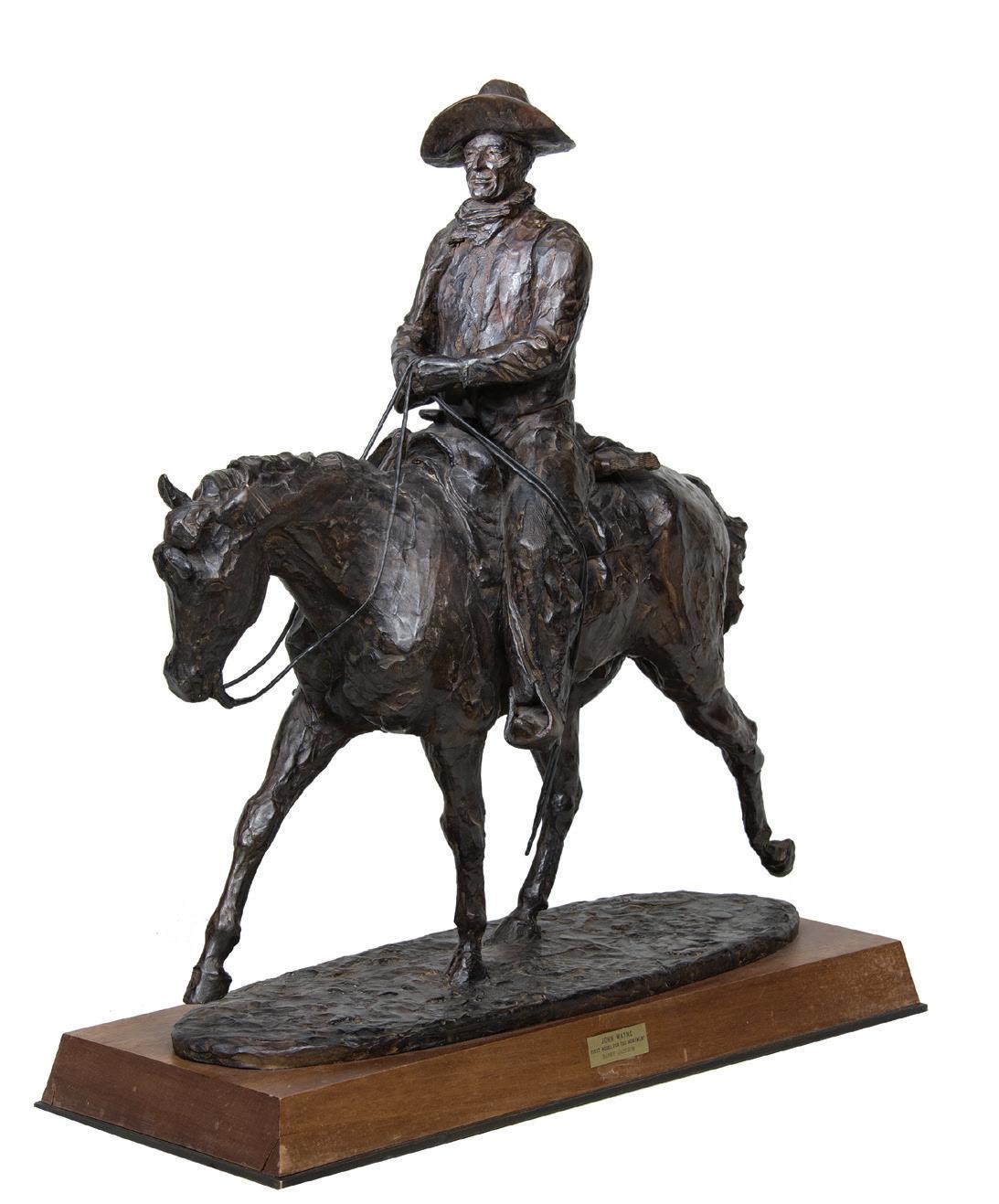
SCOTTSDALE ART AUCTION
403
Harry Jackson 1924-2011
404
Harry Jackson 1924-2011
238
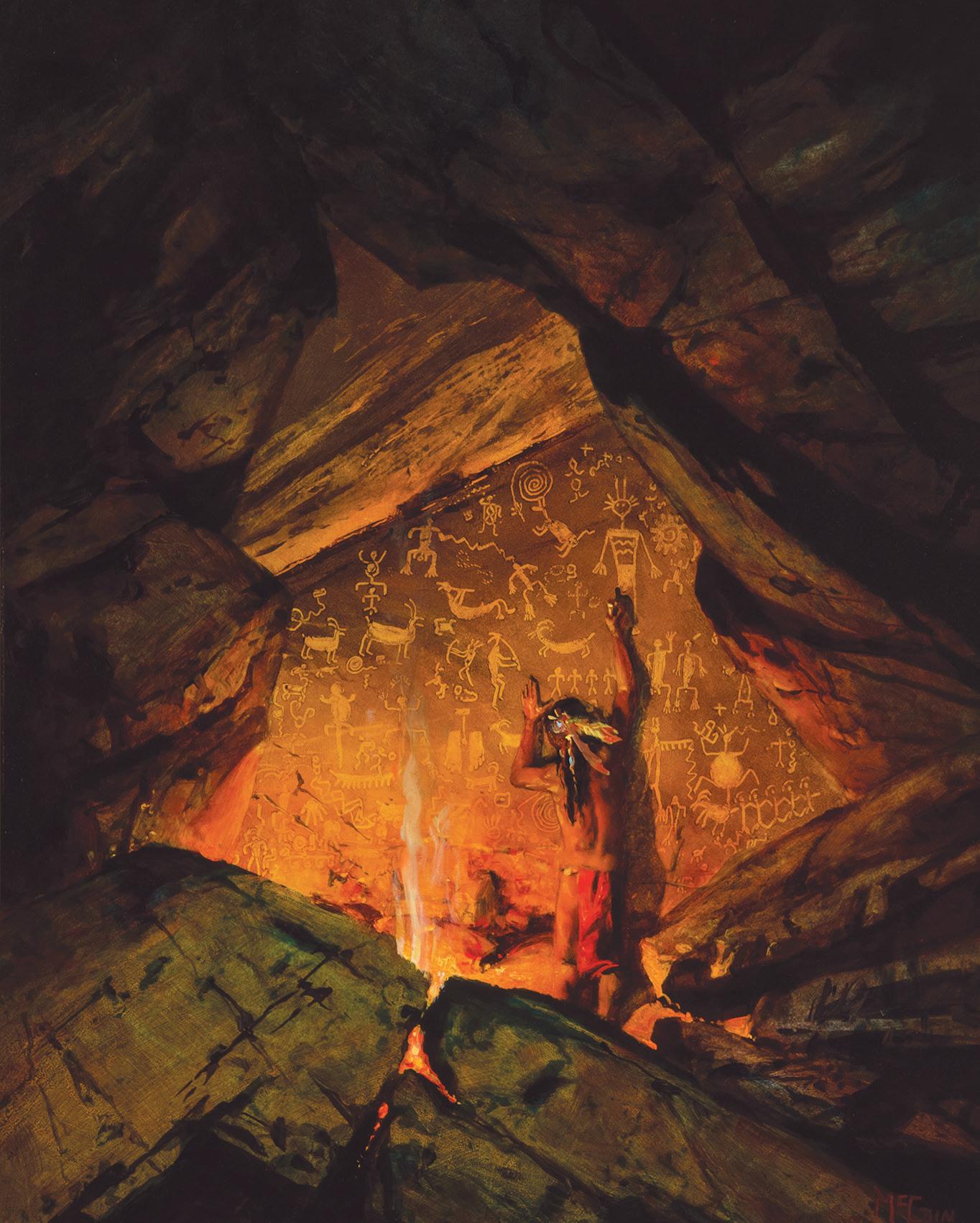
Oil on board 20 x 16 inches
Signed/CA and dated 97 lower right; Signed and dated 1998 verso
Estimate: $3,000 - 5,000
Oil on board 24 x 16 inches
Signed/CA lower right;
Titled verso
Estimate: $4,500 - 6,500

SCOTTSDALE ART AUCTION
405
Buck McCain b. 1943 Fireside Petroglyphs
406
Ray Swanson 1937-2004
Gotta Get This Rope A Workin’
239
407
Frank McCarthy 1924-2002
Pursued
Oil on board
16 x 12 inches
Signed/CA lower right
Estimate: $5,000 - 8,000


408
The Stampede
Oil on board
20 x 14 inches
Signed lower left
Estimate: $6,000 - 9,000
SCOTTSDALE ART AUCTION 240
Frank McCarthy 1924-2002

409
William Matthews b. 1949
Careful Squat
Watercolor
15 x 9 ½ inches
Signed lower left
Estimate: $2,000 - 3,000
410
Ken Payne 1938-2012
High and Lonesome
Bronze, cast 19/40
26 inches overall height
Signed, titled and dated 81’
Estimate: $1,500 - 2,500

SCOTTSDALE ART AUCTION 241
SCOTTSDALE ART AUCTION 242 Index – Alphabetical by Lot number Artist Lot # Artist Lot # Saturday • April 13, 2024 • Session
Acheff, William 346, 393, 394 Andersen, Roy 268, 269 Anton, Bill 205, 206, 350 Arpa, José 204 Aspevig, Clyde ........................................ 325, 326 Balink, Henry ................................................. 295 Bama, James.................................................. 192 Banovich, John ............................................... 355 Beecham, Greg ............................................... 260 Beeler, Joe 209 Berninghaus, Oscar 178, 285 Blumenschein, Ernest 179 Bodelson, Dan 208 Bodmer, Karl (In the manner of) 180 Borein, Edward 193, 291 Borg, Carl Oscar ............................................. 281 Bowman, Eric .................................. 231, 232, 233 Brenders, Carl ................................................. 333 Browning, Tom ....................................... 216, 348 Bunn, Kenneth ....... 254, 255, 328, 329, 353, 387 Calle, Paul 369 Carlson, George 197 Carlson, Ken 247, 261, 327, 352, 384 Christensen, Scott 337 Clymer, John Ford p.83, 287, 288, 289 Coleman, John ............................... 239, 240, 241 Coleman, Michael .................................. 210, 335 Coleman, Nicholas ......................................... 364 Couse, Eanger Irving ............. 187, 188, 279, 280, 298, 299 Cox, Tim .......................................................... 207 Crowley, Don 392 Dallin, Cyrus 312 Daughters, Robert 338 Dixon, Maynard 177, 282, 283 Dunton, William H. 306 Durrie, George Henry ...................................... 302 Elwell, R. Farrington ...................................... 365 Epp, Phil .......................................................... 234 Fechin, Nicolai ............................................... 284 Frazier, Luke 362 Gaspard, Leon 189, 305 Gollings, William 183, 184, 185 Grant, Blanche 202 Greene, Bruce 351 Grelle, Martin ......................... p.85, 266, 267, 276 Griffing, Robert ............................................... 223 Hagege, Logan Maxwell ....................... 264, 265 Halbach, David ............................................... 389 Hamlin, Edith .................................................. 176 Hansen, Herman 195, 378 Harvey, G. 272, 273, 274, 275 Hennings, E. Martin 191 Hill, Thomas 397 Hoffman, Frank 366, 367 Hulings, Clark ................................................. 303 Hyde, Doug ..................................................... 395 Idol, Colt ......................................................... 235 Jackson, Harry ............. 360, 370, 371, 372, 380, 403, 404 Johnson, Frank Tenney 290 Jordan, Jerry 238 Kuhn, Bob 249, 262, 263 Kuhnert, Wilhelm 256, 257, 258, 259
II
SCOTTSDALE ART AUCTION 243 Index – Alphabetical by Lot number Artist Lot # Artist Lot # Saturday • April 13, 2024 • Session
Leigh, William R. IFC, 286 300, Leighton, Kathryn Woodman 294 Liang, Z.S. 225, 342, 343, 344 Lipking, Jeremy 323 Lougheed, Robert ........................................... 212 Lovell, Tom .............................................. 277, BC Lungren, Fernand ........................................... 181 Maczuga, Michael ........................................ 198 Maggiori, Mark ............... 242, 243, 244, 245, 246 Marris, Bonnie 385 Matthews, William 349, 409 McCain, Buck 405 McCarthy, Frank 214, 270, 271, 347, 373, 407, 408 Mell, Ed 339, 340, 341 Moyers, John .......................................... 236, 237 Norton, Jim ........................................... 215, 391 Oelze, Don ..................................................... 224 Ostermiller, Dan .............................. 381, 382, 383 Owen, Bill 217, 218 Paxson, Edgar S. 203 Payne, Edgar 316 Payne, Ken 410 Phillips, Bert G. ....................................... 296, 297 Polzin, Kyle ..................... 226, 227, 228, 229, 230 Poulsen, M.C. ................................................. 396 Pummill, Robert .............................................. 379 Reiss, Winold ......................... 199, 200, 292, 293 Remington, Frederic 182, 308 Reynolds, James 213, 375, 376 Rhymer, Paul 357 Rich, Jason 377 Riley, Kenneth 219, 220, 221, 222 Roberts, Ray 402 Rockwell, Norman .......................................... 301 Rollins, Warren ............................................... 401 Rungius, Carl .................................................. 186 Russell, Charles M... FC, 196, 307, 309, 310, 315 Sandzen, Birger ..................................... 317, 399 Schmid, Richard 318, 319, 320, 321, 322 Schwiering, Conrad 400 Seltzer, Olaf C. 313, 314 Sharp, Joseph Henry 190, 278 Shepherd, David 250, 251, 252, 253 Shilstone, Arthur 363 Shinabarger, Tim .................... 248, 354, 356, 386 Sims, Kyle ....................................................... 332 Skeele, Anna Katharine .................................. 201 Smith, Daniel .......................................... 330, 331 Smith, Tucker .................................................. 211 Solliday, Tim ................................................... 345 Swanson, Gary 388 Swanson, Ray 406 Thomas, Andy 359, 361 Ufer, Walter .................................................... 304 Van Wechel, Dustin ....................... 334, 336, 358 Walters, Curt ......................................... 324, 398 Wieghorst, Olaf ....................... 194, 311, 368, 374 Wright, David 390
II
Terms and Conditions
BUYER’S PREMIUM The purchase price payable by the Purchaser shall be the total of the final bid price PLUS A PREMIUM OF SEVENTEEN PERCENT (17%) on any individual lot in the amount up to and including $1,000,000; TWELVE PERCENT (12%) on any individual lot on the amount in excess of $1,000,000. This premium is in addition to any commissions or other charges payable by the consignor.
Auction
The art illustrated in these two catalogues will be offered for sale on April 12 & 13, 2024 by Scottsdale Art Auction, LLC on premises at 7176 Main Street, Scottsdale, Arizona. Scottsdale Art Auction, LLC is not responsible for any postponements of the sale due to conditions out of their control.
Telephone Bidding
As a courtesy to clients who are unable to attend the sale, a telephone and order (absentee) bid service will be offered as staff and time allow. Scottsdale Art Auction, LLC shall not be responsible for any errors or omissions or failure to execute such bids. Contact Scottsdale
Art Auction, LLC at (480) 945-0225 (or register online) early for arrangements as telephone lines will be allocated on a first come basis. Scottsdale Art Auction, LLC will arrange for telephone lines on lots with a minimum estimate of $5,000 and over.
Absentee Bidding
Confidential absentee bid orders for auction items may also be completed and will be executed by Scottsdale Art Auction, LLC on behalf of the Bidder during the auction. Scottsdale Art Auction, LLC shall not be responsible for any errors or omissions or failure to execute such intent to purchase orders or auction bids.
This catalogue, as may be amended by posted notice or oral salesroom announcement, represents Scottsdale Art Auction, LLC’s entire agreement with any and all purchasers of the Property listed herein. The following are Procedures, Terms and Conditions on which all such Property listed is offered for sale by Scottsdale Art Auction, LLC as agent for various owners or other Consignors:
1. Scottsdale Art Auction, LLC reserves the right to withdraw Property at any time before or at the sale and shall have no liability for such withdrawal.
2. All Property will be sold “AS IS”. With respect to each lot of Property, Scottsdale Art Auction, LLC does not make any guarantees, warranties or representations, expressed or implied, as to merchantability or fitness for a particular purpose, the correctness of the catalogue or the authenticity or description of the Property, its physical condition, size, quality, rarity, importance, medium, provenance, exhibitions, literature or historical relevance. No statement, anywhere, whether oral or written, whether made in the catalogue, an advertisement, a bill of sale, a salesroom posting or announcement, or elsewhere, shall be deemed such a warranty, representation or assumption of liability. In no event shall Scottsdale Art Auction, LLC be responsible for genuineness, authorship, attribution, provenance, period, culture, source, origin or condition of the purchased Property and no verbal statements made regarding the Property either before or after the sale of the Property, or in any bill of sale, invoice or catalogue or advertisement or elsewhere shall be deemed such a guarantee of genuineness, or authenticity.
Notwithstanding the foregoing, if within ten (10) calendar days after the purchase of any lot of Property, the Purchaser provides an opinion by a recognized authority on the artist and gives notice in writing to Scottsdale Art Auction, LLC that the lot is not authentic, and returns the purchased lot to Scottsdale Art Auction, LLC, within ten (10) days of its purchase in the same condition as when sold, then Scottsdale Art Auction, LLC will refund the full purchase price to the Purchaser. It shall be in the sole discretion of Scottsdale Art Auction, LLC as to whether the opinion provided by the Purchaser is an opinion by a recognized authority on the artist.
3. Scottsdale Art Auction, LLC and/or Auctioneer reserves the right to reject any bids. The highest bidder acknowledged by the Auctioneer shall be the Purchaser. In the event of any dispute between bidders, the Auctioneer will have absolute and final discretion to either determine the successful bidder or to re-offer and resell the Property item in dispute. After the sale, Scottsdale Art Auction, LLC’s record of final sale shall be conclusive.
4. At the fall of the Auctioneer’s hammer, the Purchaser shall (a) be acknowledged by bidder number by the auctioneer, (b) pay the hammer price and a buyer’s premium as outlined above. In addition, Purchaser may be required to sign a confirmation of purchase. All sales are final with no exchanges or returns.
5. Unless exempted by law, the Purchaser will be required to pay any and all state and local tax pertaining to sales (sales tax, transaction privileged, etc...). It is the Purchaser's responsibility to pay any applicable use tax imposed by their state of residence on the total purchase price. In the event that sales tax has not been included in the invoiced amount and it is subsequently determined that Scottsdale Art Auction, LLC was required to collect sales tax in connection herewith, Purchaser shall reimburse Scottsdale Art Auction, LLC upon demand for any sales tax (or equivalent) accessed or due as a result of goods or services proveded by Scottsdale Art Auction, LLC hereunder, unless Purchaser provides Scottsdale Art Auction, LLC evidence of exemption from such taxes.
6. Terms for all purchases will be cash, bank wire, check, or credit card (VISA/MasterCard/American Express) with settlement and payment due in full the day of the sale unless otherwise arranged. All monies shall be made payable to Scottsdale Art Auction, LLC. At the discretion of Scottsdale Art Auction, LLC, payment will not be deemed to have been made in full until funds represented by checks have been collected or the authenticity of bank or cashier’s checks has been confirmed. An additional 3% will be charged on all credit card payments.
7. No item of Property may be paid for or removed from Scottsdale Art Auction, LLC during the sale. After the sale has been completed and after the purchase price has been paid in full, Property must be removed from the saleroom at the Purchaser’s expense not later than three business days following the sale. Scottsdale Art Auction, LLC will, as a service to Purchasers, arrange to have Property packed, insured and shipped, all charges at the expense and entire risk of Purchaser.
8. Some items of Property may be offered subject to a “reserve” or confidential minimum price below which the item will not be sold. In such instances, Scottsdale Art Auction, LLC may implement the reserve by bidding through the Auctioneer on behalf of the Consignor. In no event shall the reserve exceed the low estimate in the catalogue.
9. Neither Scottsdale Art Auction, LLC, nor Auctioneer, nor Consignor make any representations whatsoever that the Purchaser of a work of art will acquire any reproduction rights thereto.
10. These Conditions of Sale and any other applicable conditions, as well as the Purchaser’s and Scottsdale Art Auction, LLC’s rights and obligations herein shall be governed by, construed and enforced in accordance with the laws of the State of Arizona. If these conditions are not complied with by the Purchaser, Scottsdale Art Auction, LLC may, in addition to other remedies available by law, including, without limitation, the right to hold the Purchaser liable for the total purchase price stated on the Confirmation of Purchase Invoice, either (a) cancel the sale and retain as liquidated damages any and all payments made by the Purchaser or (b) resell the Property privately or at public auction on three days’ notice to the Purchaser for the payment of any deficiency in the purchase price and all costs including handling charges, warehousing, the expense of both sales, the commissions, reasonable attorneys’ fees, any and all other charges due and incidental damages.
11. Biding on any item indicates your acceptance of these terms and all other terms announced at the time of sale whether bidding in person, by phone, by Internet, by absentee bid, or through a representative.
12. In most instances, sculpture measurements do not include base. In measurements for two dimensional art, height precedes width and does not include frame.
13. Bidding increments will normally follow the pattern below but may vary at the sole discretion of the Auctioneer.
SCOTTSDALE ART AUCTION 244
Estimate Increment Estimate Increment Under 2,000 100 20,000–50,000 2,500 2,000–5,000 250 50,000–100,000 5,000 5,000–10,000 500 over 100,000 10,000 10,000–20,000 1,000










